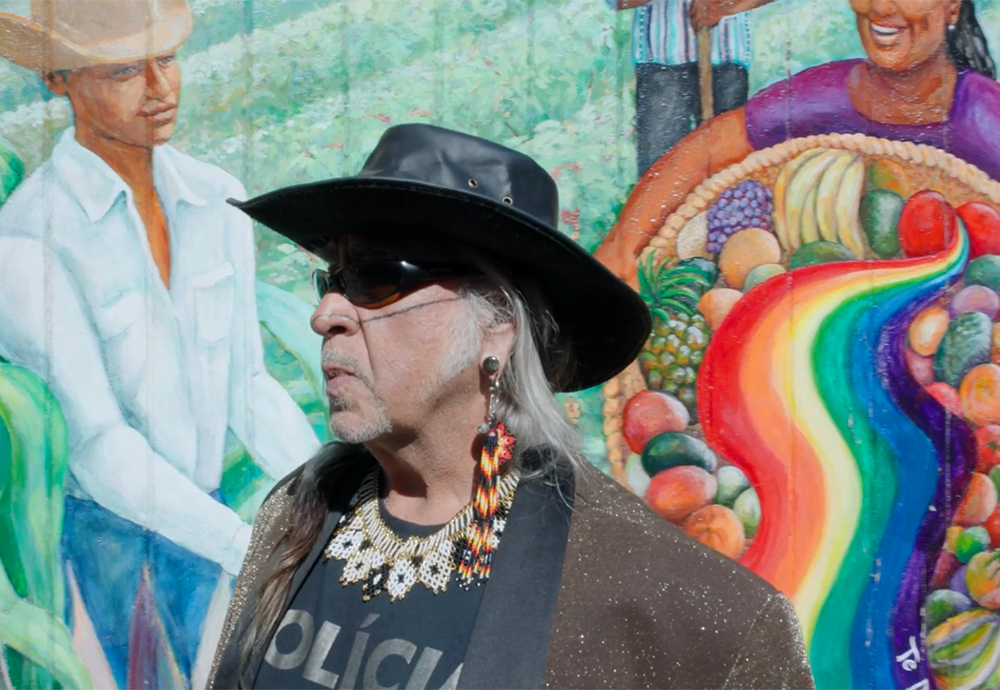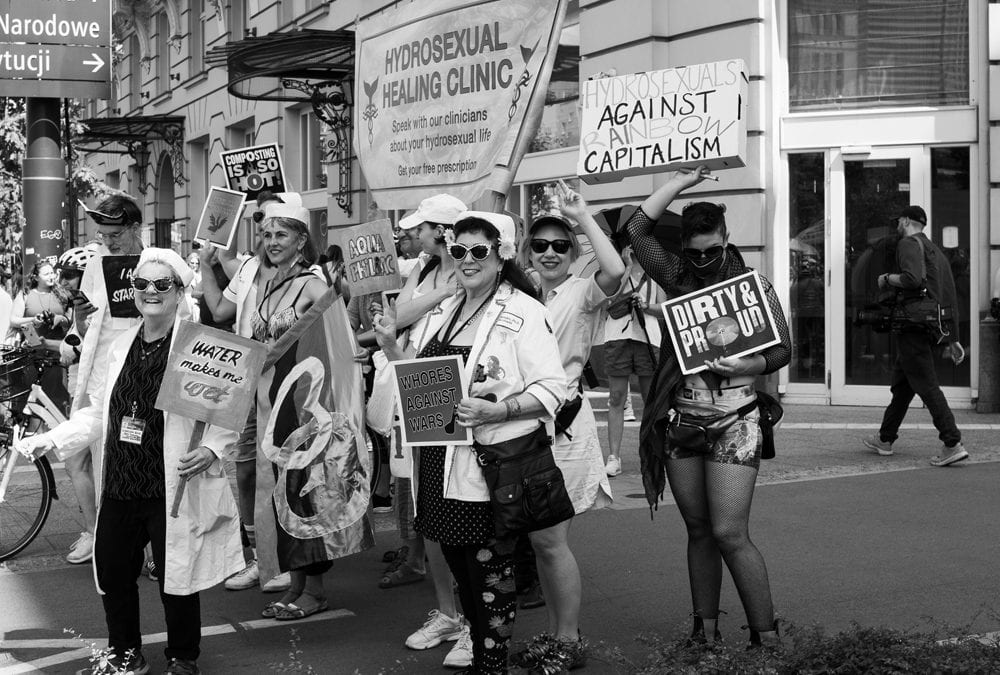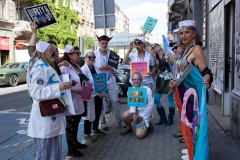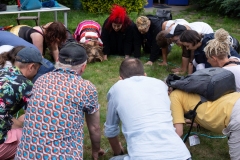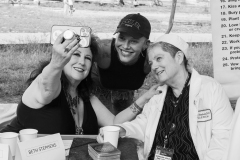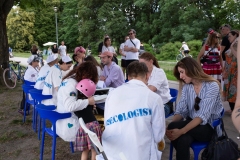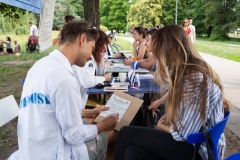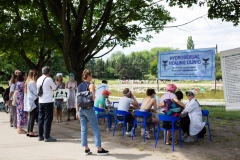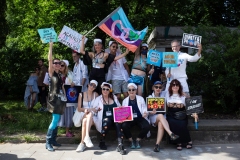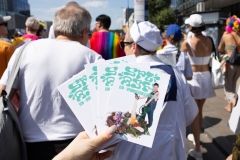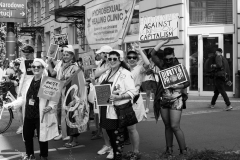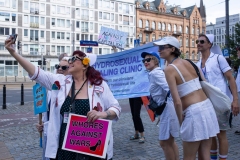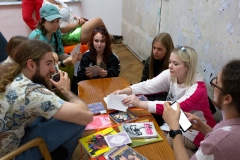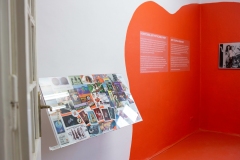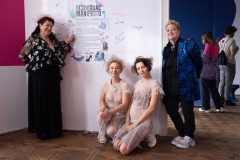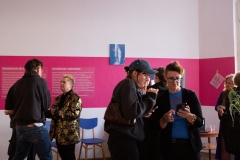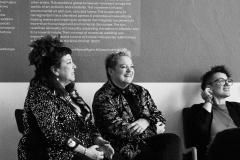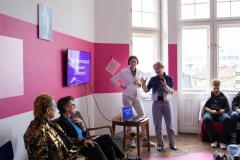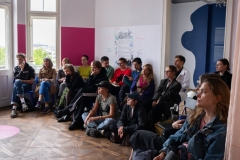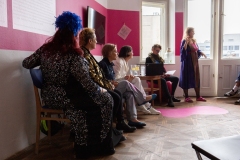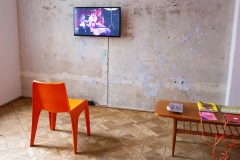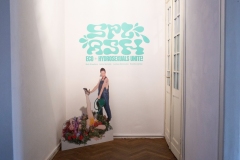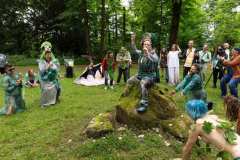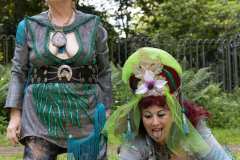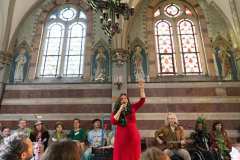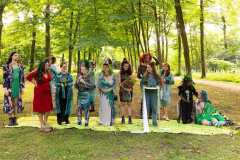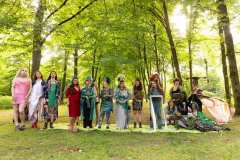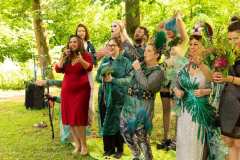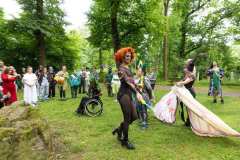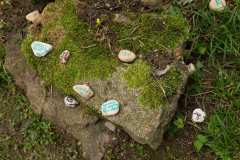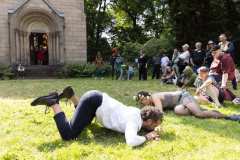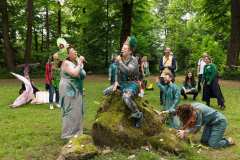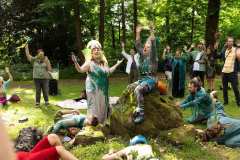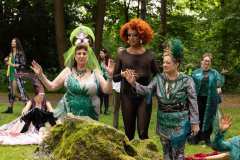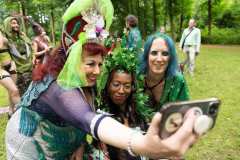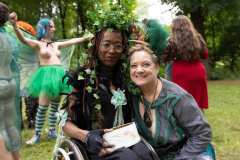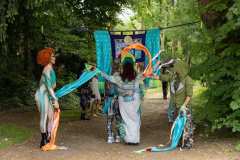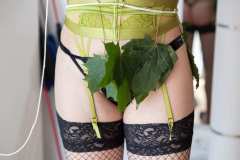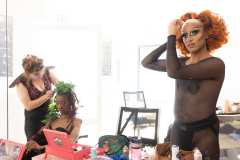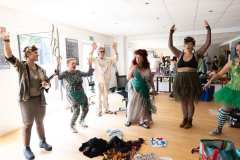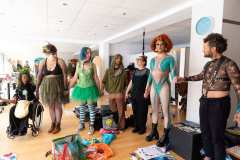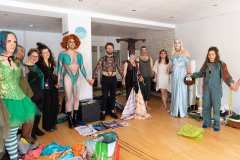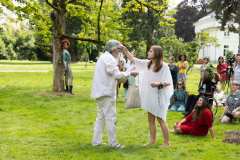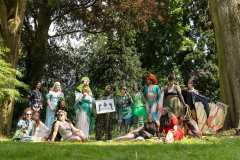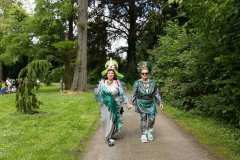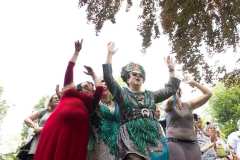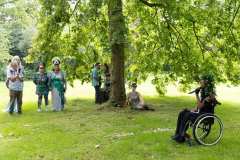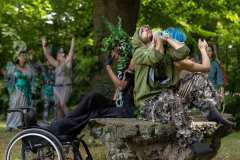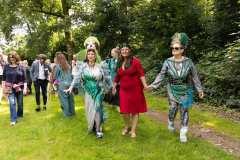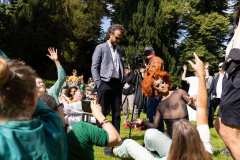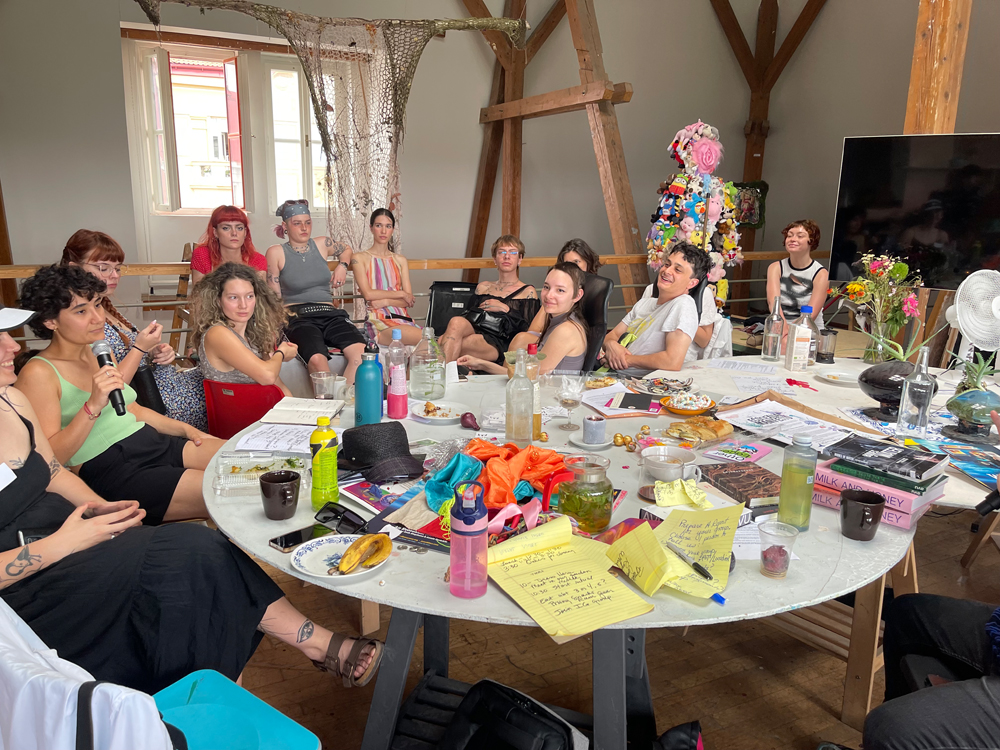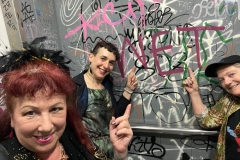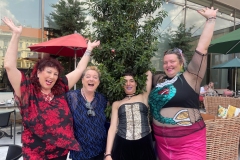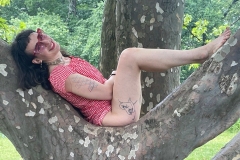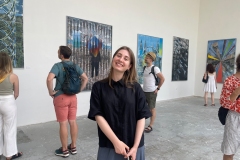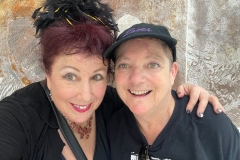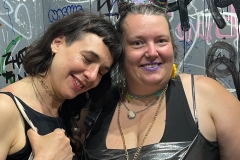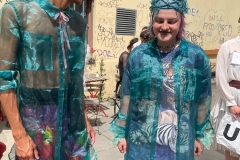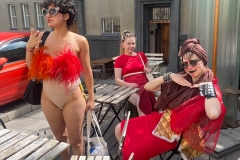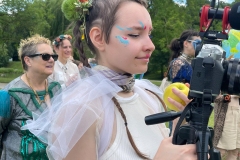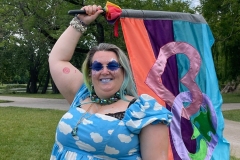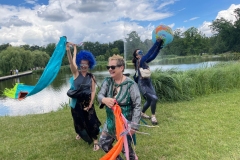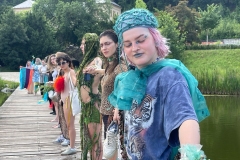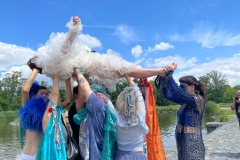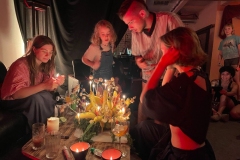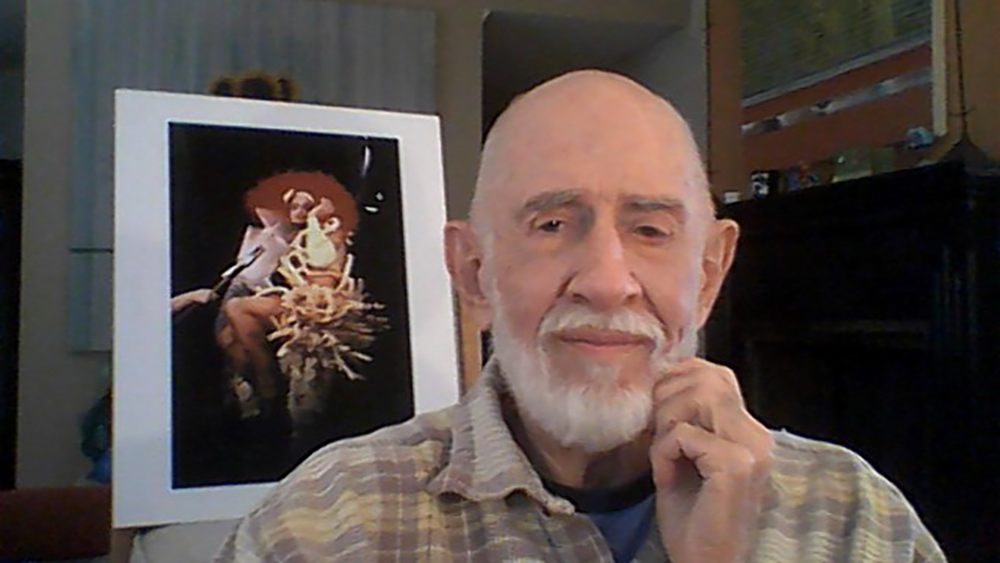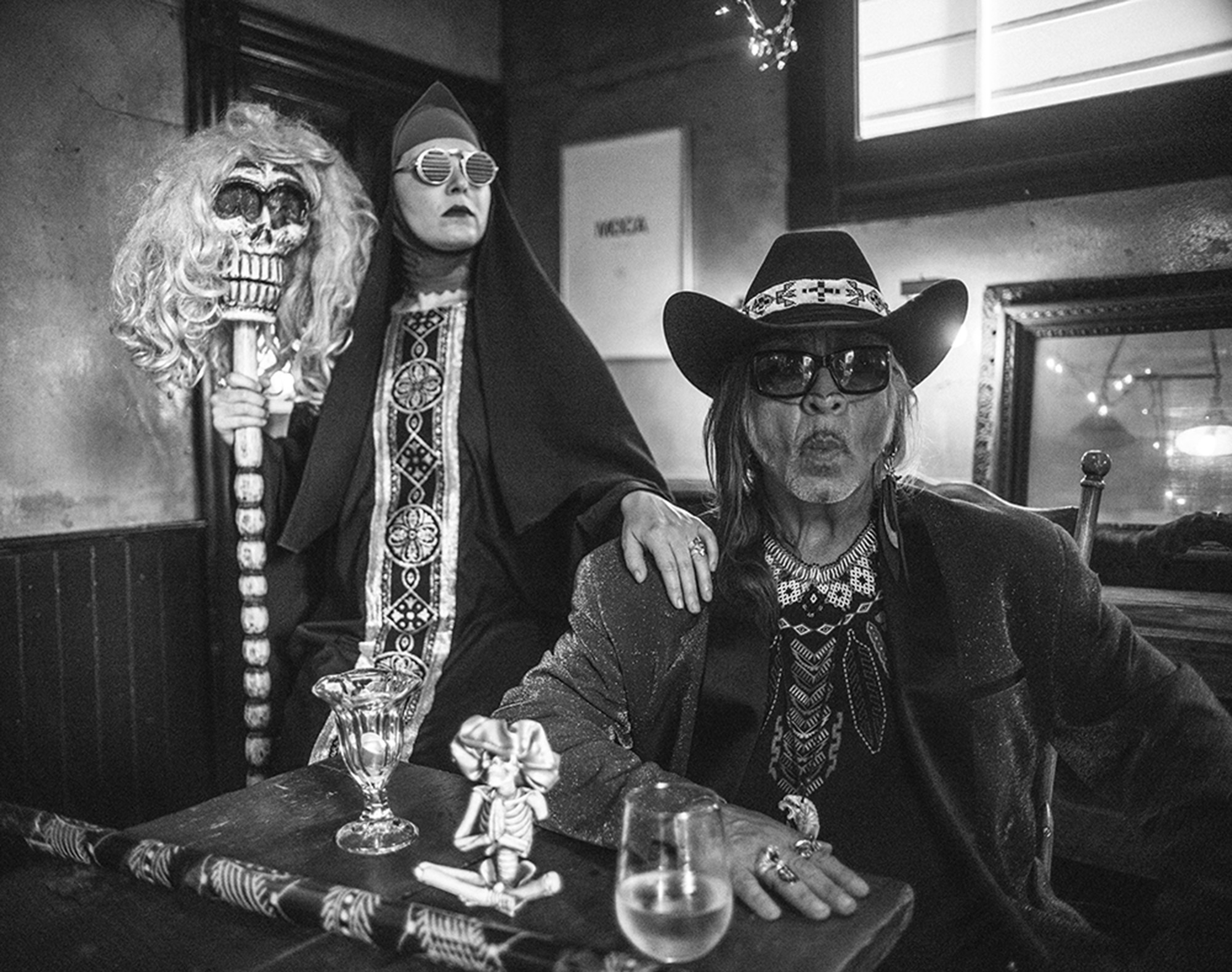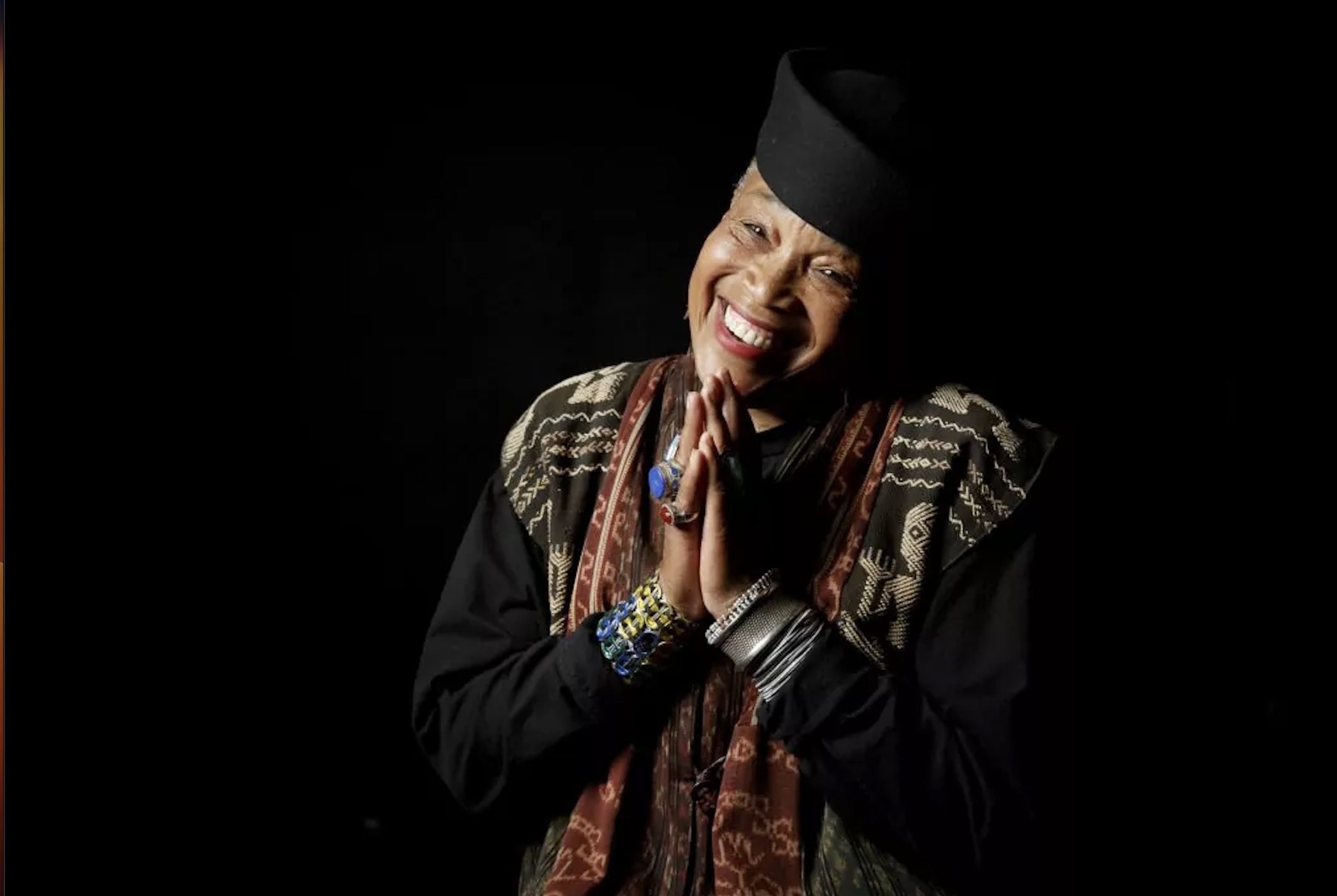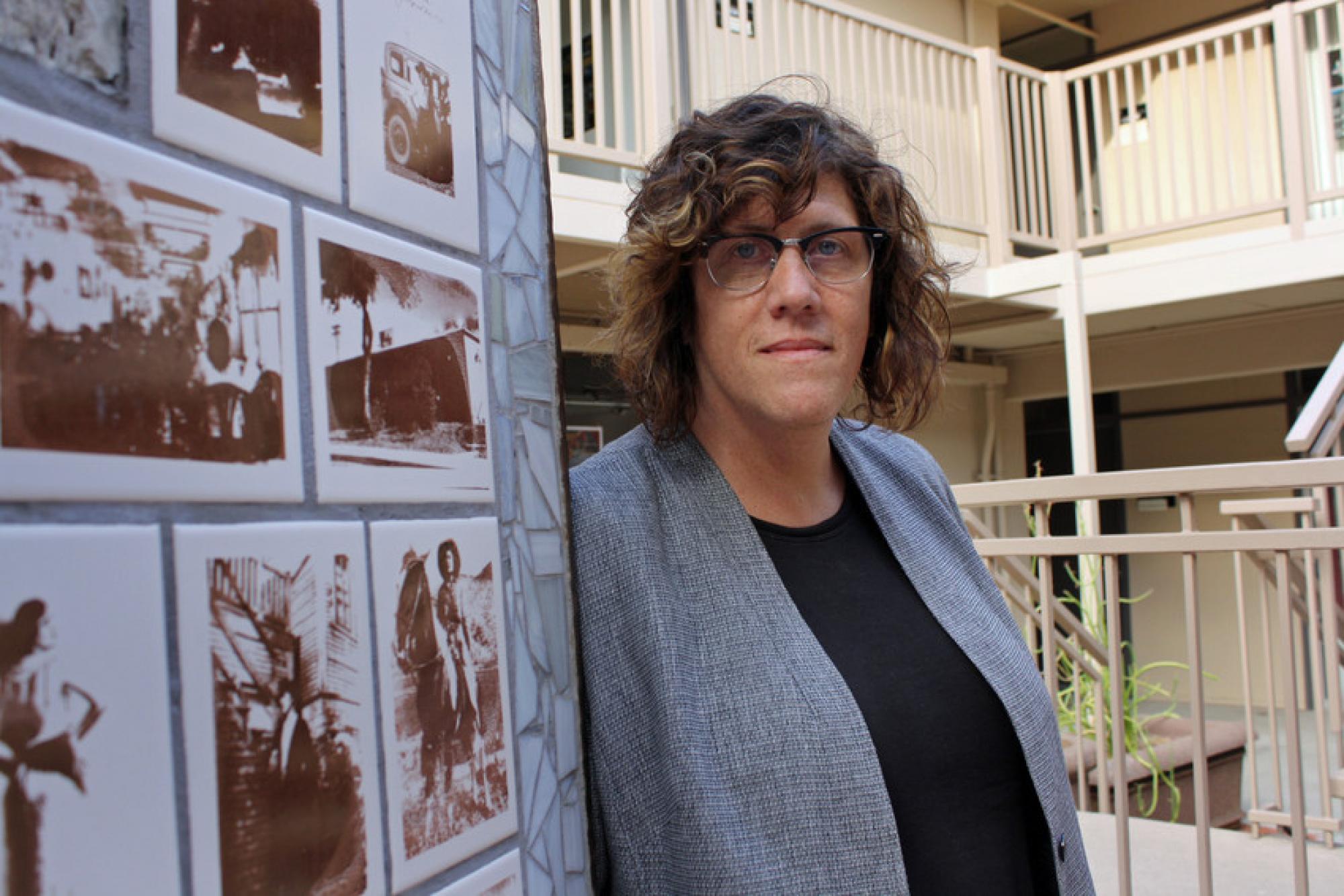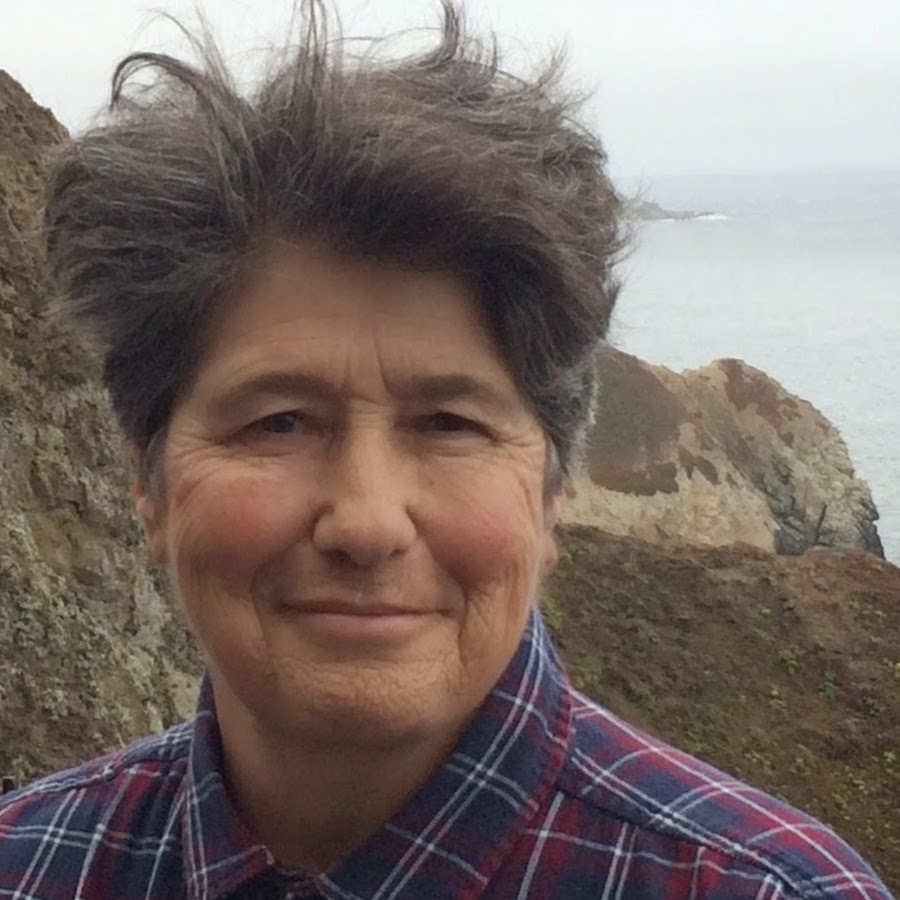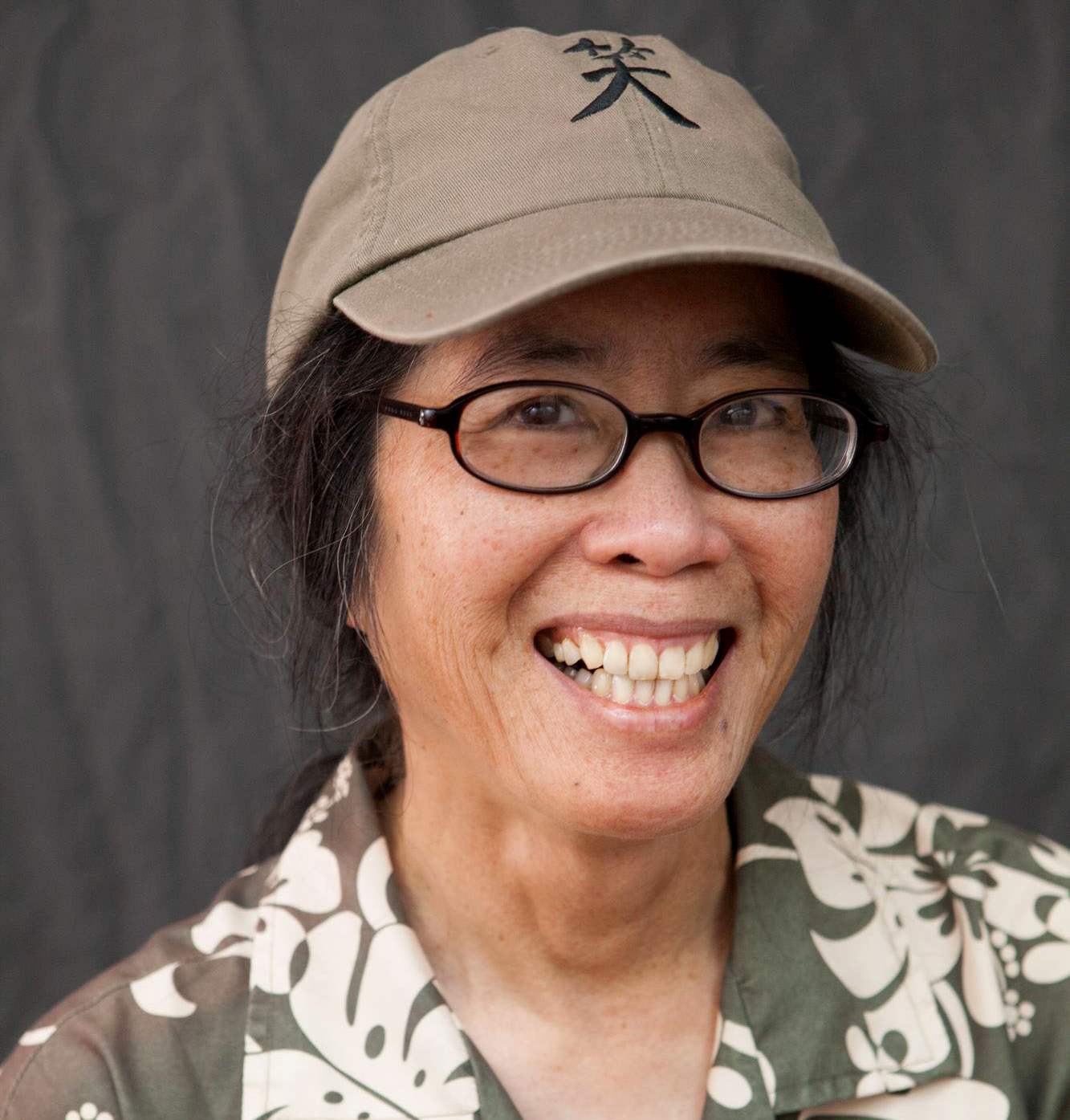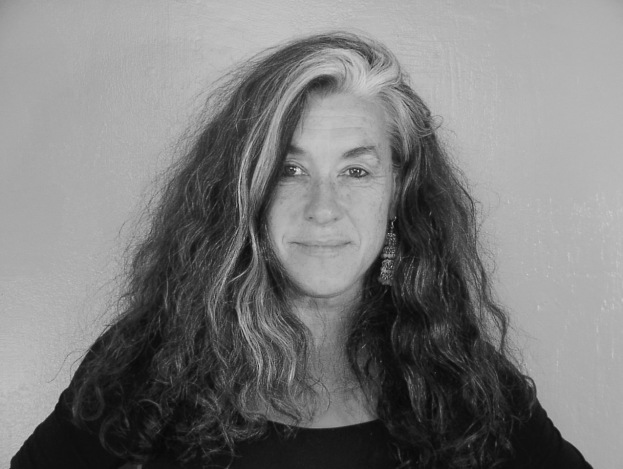Author Archive: Julie Rogge
Salzburg International Summer Academy of Fine Art
Salzburg International Summer Academy of Fine Art
Exploring the Earth as Lover; New Approaches to Environmental Art, Theory & Activism
Salzburg, Austria
July 31, 2023 - August 13, 2023
We’ll be teaching an in-person 2-week course in a castle! It will be Interdisciplinary; Art, Performance Art, Community Building, Theory, Praxis.
We are creating a gathering of artists, academics, sex workers, sexologists, healers, environmental activists, nature fetishists, gardeners, media makers, therapists, activists, eco-feminists, educators, (r)evolutionaries, critters and other entities from diverse aspects of life to celebrate, proclaim, challenge, debate, perform, create and stimulate our senses. Bringing our environmental concerns and diverse knowledges together, we’ll learn about what’s happening in environmental art, sexecology and ecosex theory and practice.
More details to be announced soon at www.summeracademy.at/en/
Warsaw Exhibition: Splash
The Park As Lover: A Walking Ritual
Düsseldorf, Germany | June 22, 2024
The Park as Lover, in the Lantz’sch Park (the People’s Park) in Düsseldorf, Germany where we will explore and honor the park by walking in and around it. Eventually we will come to a sacred grove, where we will hold a participatory commitment ritual for the park, the forest, and for peace on Earth. Many friends from the Buga Festival will join us there, as well as Joy Brook Fairfield (our director) and amazing author, Dr. Mithu M. Sanyal. Beekeeper and Theater Director Luke Dixon will be there too. This performance ritual take place the afternoon of June 22, 2024, the first day of summer. More details to follow.
Location: Lantz’scher Skulpturenpark
What: Our piece will take the best parts of our eco-weddings and our eco-walking tours and spin them into a new form–the Ecosex Walking Ritual.
Who: An eco artist collective; Beth, Annie, Joy, 5 Mannheim-based artists, Luke Dixon (London bee-keeper& artist). K.Klang and team, and several local artists.
Intentions:
To generate love and appreciation for the Park (Earth) and each other.
To pollinate the ideas of Park (Earth) as lover
To nurture ourselves and each other.
To get ecosexy, have fun and heal the world!
The Plan: Parts of the Ritual Walk
Gathering (welcome audience, ambient performances, do the eco name tags…)
Opening scene and introductions to the team with Beth & Annie and the group
Go on the Walk with stops for artist’s performance rituals along the way
Climax is a (simple) wedding ritual with vows to love and honor the Earth, rings, kiss
Strong finale with the group
Photos by Lydia Daniller
Workshop in Prague
Greg Day
Greg Day
Greg Day is an artist, activist and cultural equity advocate. The camera has been an integral part of his journey in America and Europe for over half a century.
As a photographer and cultural anthropologist, Day has documented some of the most important cultural milieus and events of our time, including: The Civil Rights and Anti-War Movements in the South, early genderqueer performance artists and Greenwich Village luminaries in New York, African American life on the Gullah/Geechee Coast, the LGBT Rights Movement, California's cultural diversity and activism and Berlin's new architecture and queer art scene.
Greg: I am an artist, activist and cultural equity advocate. The camera has been an integral part of my journey in America and Europe for over half a century. As an artist and cultural anthropologist, I have documented some of the most important cultural milieus and events of our time, including: The Civil Rights and Anti-War Movements in the South, genderqueer performance artists and Greenwich Village luminaries in New York, African American life on the Gullah/Geechee Coast, the LGBT Rights Movement, California's cultural diversity and activism and Berlin's new architecture and Queer art scene.
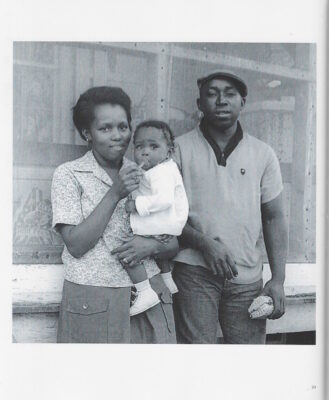
Civil Rights Image © Greg Day
B&A: After we cover that amazing history we’ll move on to how you ended up in San Francisco and what you did here. How did you grow up? You became a social justice warrior and a very political artist. Were your parents Unitarian or Quaker or something like that?
GD: No, my mother was a secretary from Wisconsin and my father became an attorney from Alabama. They met in Washington D.C. under F.D.R.'s national job program where the government allocated a certain number of federal jobs for each state. My mother won the lottery in Madison, WI and went to Washington D.C.. My parents were not religious. My father was agnostic and my mother was raised Catholic, but hated it. When I came out to my mother, I was in my twenties and she said, “I knew you were gay since you were 4 years old. I don't care if you're gay. Just don't let the neighbors know.” I said, “What did you think when I married Kate Young, my former wife?” She said, “We thought that was really nice.”
I have a Polish immigrant grandfather who hated Poland and the Catholic Church. He married the daughter of German and Polish immigrants in Milwaukee. I come from a family of very outspoken adventurous, outside the box people, who are difficult and argumentative about their rights. My father taught me how to cross barriers. My grandfather was a carpenter and country school teacher. He and my father were workers on the first dam that F.D.R. built in the Tennessee Valley, the Joe Wheeler Dam. Vera Mahala Armstrong, my grandmother, was a descendant of survivors of the Trail of Tears. They were from Alabama so I spent my childhood there. Then my father’s career led him to Washington. We moved there between my junior and senior years of high school. I graduated from high school in Silver Springs, MD.
My father's family in Alabama was mixed race, although they passed as white. They were Native American, Appalachian, outsider people. My dad was outspoken and he raised me to be that way. My parents supported my being an artist from an early age,
In the late 1960s and early 1970s, I was an anthropology and photography student at Georgia State University in downtown Atlanta. Atlanta was a whirlwind of student activism, anti-war protests, civil rights marches. Dr. King's Southern Leadership Conference organization was located there. I went to a lot of demonstrations. I used photography to be a part of these activities and to document them. I wanted to make photographs like Dorothea Lange, documentary photography with a social justice agenda. I took the first course in African American culture offered there, by folklorist Mary Arnold Twining. She had completed field research on the Sea Islands of Georgia and South Carolina and took us there on field trips.
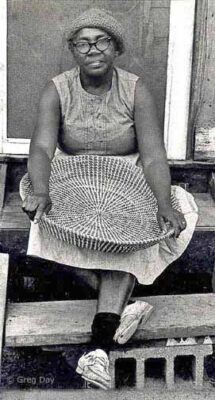
Basketmaker Mary Jane Manigault at her home in Hamlin Beach, SC, 1974.© Greg Day
On these field trips we went to the Gullah Geechee Coast’s basket-making community. On Highway I7, I met Mary Jane Manigault, the community’s matriarch and cultural broker. She was a very well-known basket-maker. I asked if I could take her picture, which is standard there— you buy a basket and then you can take a picture of the basket-maker. She said, “sure, go ahead”, and when I put the camera up to my eye she said, “I know what you're doing with that camera.” I put the camera down. I thought I had offended her. I said, “what do you mean?” She said, “you're waiting for your mind to turn on it.” “When you start out on a basket, you think you're gonna make a certain type, and while you're making it, suddenly the wall of the basket has turned in another direction, so I let my mind go with it. I never know what kind of basket I'm going to get until the end. But I know it's going to be great because I'm following my good mind.” She used her intuition, and that helped her become one of the most famous basket-makers in the United States. She was invited to the White House, and received a grant from the NEH. She was really extraordinary. Besides the basket-makers, I met African-American women quilters and the visionary artist Nellie Mae Rowe.
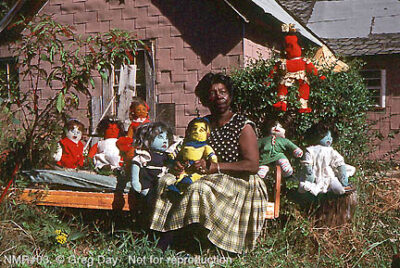
Mrs. Nellie Mae Rowe with her 'doll children'. Vinings, Georgia, 1978. © Greg Day
The Mt. Pleasant basket-makers make many things by hand, yet they are very contemporary. In this community everyone is involved in art production. Their process of making art is in the moment, improvisational, spontaneous, and without a lot of planning. They rely on dreams and being present in the moment These are the same principles that show up in every aspect of their life; what they were gonna wear in the morning; who they're gonna be... They changed my entire conception and practice of photography: their art process and their way of dealing with the world became mine.
Kate Young and I were both accepted in Rutgers University's Anthropology Graduate program. After we finished our coursework, we moved to Manhattan and lived in Greenwich Village. The city was bankrupt and rent was cheap. In the Village and Chelsea. I discovered a full-blown, underground queer art scene— writers, actors, performance artists — in the streets, clubs and on the piers. Here I met Stephen Varble, Ruth Truth, and Warhol Factory stars, Taylor Mead, Jackie Curtis and Mario Mondelli, The Hot Peaches performance group, Agosto Machado, playwright Doric Wilson, performance pioneer Jack Smith, and Divine. Once again, my camera provided access and I began to document the LGBTQ+ community.
In 1978, I moved to San Francisco as part of a Rainbow Migration that brought thousands of Queers to San Francisco and California. I had a teaching job lined up at San Francisco State. When I arrived, the governor had eliminated the budget and I didn't have a job. But I had my camera, and I became a member of the gay press. With my Advocate magazine press pass, I could go anywhere in San Francisco without an invitation. All I had to do was flash that press pass.
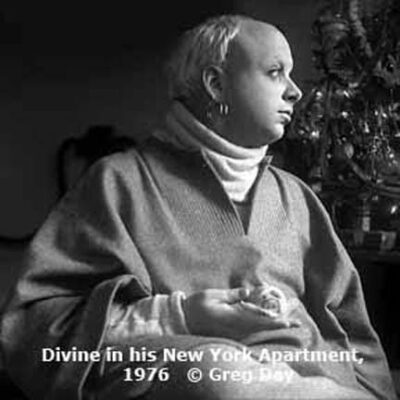
In 1978, I went to my first Pride Parade in San Francisco. Thirty artists made flags and every flagpole had a different design. I thought “What a fantastic art installation!” There were three large rainbow flags made by Lynn Segarblom (aka Fairie Rainbow Argyle) and James McNamara. Gilbert Baker served as a co-chair of the Pride flag committee with Lynn. In the years that followed he would promote the rainbow flag as an international symbol of our movement.
I went to the Parade Committee meeting and there was a huge fight between women, artists, people of color, and the white male Parade Co-chair who had invited Ronald Reagan to speak. I photographed this historic meeting where the Committee voted to include women and people of color on the stage. But then the Parade leadership refused to do it.
During the Parade, as a member of the press, I was admitted to the area behind the main stage on the Polk Street steps of City Hall. The lesbian comic, Robin Tyler, and a huge group of women and their supporters rushed forward, pushed through the fence and reached the stage. Meanwhile, the Parade’s security told me I could not photograph what was happening.
I was flabbergasted that I was censored and was so angry I couldn't sleep. The gay press, with the exception of the Bay Times, was misogynist and racist. I had the only photographs of the demonstration. So, I made the editors of the gay papers sign an agreement that they would mention that the Parade Committee ejected me from the press area for taking the pictures. I went to the next parade meeting, and criticized the Committee for failing to support freedom of the press. Somebody made a motion to remove the male co-chair from the parade. Then somebody got up and nominated me. I was so angry that I said OK– and I was elected.
The first motion we made was to change the name of the Pride Parade from “Gay Freedom Day” to “Lesbian/Gay Freedom Day.” Most of the new Parade Committee was made up of artists. My co-chair was Barbara Cameron, a Lakota Sioux whose writing was published in Cherrie Moraga’s This Bridge Called My Back. Then the new committee proceeded to change the rules of the parade to require that every subcommittee had to have a minimum of 50% women. We agreed to make a good faith effort that by 1983, 30% of the committee chairs would be people of color.
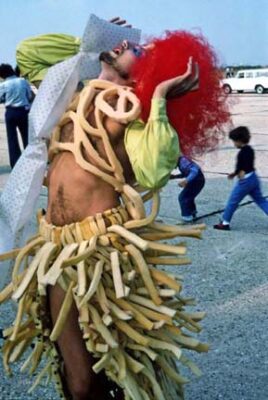
Gender Queer performance artist Stephen Varble at the New York Avant Garde Festival, 1975. © Greg Day
We decided to invite Tom Robinson, a popular gay English rock star to participate in the upcoming Parade. His song, “Glad to be Gay!” was very popular. We were worried that the U.S. Immigration Service would stop him at the border. Somebody said, “Call attorney Mary Dunlap,” Mary arrived at the Parade office our office and said “They are violating your constitutional rights as American citizens to have collegiality with people from other countries. You should sue them.” Barbara Cameron and I looked at each other and said “Yes, let's do it!
We had a court date 10 days before the Parade. We sued the U.S. Attorney General and the U.S. Immigration Service and the hearing was held before Judge Aguilar, a Mexican American judge. Mary Dunlap won the case, and for the 10 days prior to the Parade, Northern California was the only place a queer person could enter the United States. We organized a big demonstration at the airport when Tom Robinson entered the country. That was my start in San Francisco politics.

SF Mayor Dianne Feinstein at the Memorial March for slain Supervisor Harvey Milk and Mayor George Moscone, 1979. © Greg Day
At the end of the 1981 Parade, motorcycle police attacked the crowd. We caught it all on video. For the first time Barbara Cameron and I met with Dianne Feinstein, who to her credit, felt her job as Mayor was to meet with everybody. Even though many LGBTQ people didn't like her and thought that she was too old-fashioned and conservative, I appreciated her fearlessness. We argued that we paid the cops’ salaries and they had attacked us. Feinstein had become Mayor because a former police officer had assassinated Mayor George Moscone and Supervisor Harvey Milk. She told us she would work on it. This was my first introduction to Mayor Feinstein and it opened a doorway to local politics.
Soon I became an officer of the Stonewall Democrats. Then Jeff Jones, recruited me to become the Issues Chair of the Alice B. Toklas Lesbian/Gay Democratic Club. The Alice Club in those days was much more radical than it had been before. Mr. Jones was the Treasurer and was also writing grants for artists and arts organizations. The Arts. Randy Stallings was President, Connie O’Connor was the past president, Sal Rosselli was the Vice President.
One of my boyfriends was on the Mayor’s Lesbian/Gay Advisory Committee. One morning, he said to me, “You complain all the time about Dianne and you're getting nowhere. You should be on her Advisory Committee. Maybe she'll listen to and learn from you.” Three days later I started attending the group’s monthly meeting with the Mayor. There were about 40 people, mostly gay male realtors and lawyers and also activists like Pat Norman and Konstantin Berlandt.
Around this time the White Panthers, a group of gun enthusiasts, launched a campaign to recall Mayor Feinstein. Dianne had just vetoed the first Domestic Partners ordinance passed by the Board of Supervisors The White Panthers found a willing group of angry gay people on Castro Street who signed the recall petition.
The Alice B. Toklas Lesbian/Gay Democratic Club was close with Dianne because the Harvey Milk Lesbian/Gay Democratic Club had never supported her until the run-off election of 1979, when the choice was Feinstein or Supervisor Quentin Kopp, the most conservative member of the Board.
Dianne needed the endorsement of the Alice Club, the largest Club in San Francisco’s LGBTQ Community. I was the Chair of the Issues Committee and also on its Executive Committee. The Alice leadership decided to ask for a meeting with the Mayor. Once she accepted, Jeff Jones convinced us to think about what funding items we could ask her to support. Everyone on the Committee had ideas and when the list was put together, each of us took responsibility for asking for one item.
I just want to give you a picture here of the Alice Club’s ability to see the politics of the situation. When we met for lunch with the Mayor at an upstairs private room in a restaurant near City Hall, we asked for everything: money to support AIDS education and prevention campaigns: funding for the recently formed San Francisco AIDS Foundation; support for the Rape Crisis Center; a battered women’s shelter; funding for the Women’s Philharmonic; the Lesbian Rights Project; a contract with a Tenderloin Hotel to serve homeless people with AIDS; support for Community United Against Violence (CUAV). I’m sure I’m forgetting something…
JJ: Yes you are! We asked Dianne to appoint you to the Citizens Advisory Committee of the Community Development Block Grant Program.
GD: Yes. At the meeting, Dianne Feinstein understood that she would have to deliver on at least some of these items to insure the Club's would vote “no” against the recall. To our surprise the Mayor agreed to everything! There was only one exception: she refused to march with Alice in the upcoming Gay Pride Parade. She worried that if she did, 1000 drag queens would dress up as Dianne and march behind her. The Mayor received an unanimous endorsement from Alice.
Soon afterwards the Mayor appointed my boyfriend to the Community Development Committee that recommended how she should allocate San Francisco’s Community Development Block Grant that annually amounted to approximately $26,000,000.
At that time, the only City funds awarded to the LGBTQ community were for mental health, probably because most earlier city officials secretly thought we were mentally ill, if not crazy.
I read in the SF Chronicle that the Housing and Urban Development Department of the Federal Government had asked the Mayor to form a new Citizens Advisory Committee since the one currently in existence had conflicts of interest. This announcement happened two weeks before the annual deadline to appropriate $26,000,000 to the City’s non-profits.
That same day I received a call from Jeff Jones who asked me to talk to my boyfriend who had just been removed from the Citizens Advisory Committee, and get him to recommend me to the Mayor as his replacement. I said, “why would I want to be on that committee?” Jones replied, “That committee hands out $26,000,000 dollars every year and the LGBTQ Community doesn’t get any of it.”
So, I joined this committee of 16 people; 8 men and 8 women. There were 2 straight white people and me, a white queer; the other 13 members were people of color. All of us were newly appointed. The Chair was the head of San Francisco’s NAACP. We had one week to review 400+ applications and recommend how the Mayor should allocate the $26,000,000. It was crazy.
Dianne said the arts were not included in this category and that existing groups should be cut by 10%. Immediately there was a huge fight between the Latino and Black communities. To resolve this problem, we put together a multicultural coalition of the Committee’s Asian, Latino, African American, Native American members. We cut every large group by 5% to fund new programs in under-served communities.
The Committee decided to interview the groups seeking first-time funding. One of them was a consortium of arts groups including the San Francisco Mime Troupe, the S.F. Ethnic Dance Festival, Theatre Rhinoceros, the Women’s Philharmonic and the Lorraine Hansberry Theater. When Marie Acosta of the Mime Troupe was testifying, the only white straight guy on the Committee called her a “Latina bitch.” When the Committee was meeting at 5 o'clock, the same unhinged nutcase started yelling that he would crack my faggot head, I was a “cock-sucking son of a bitch” and that queers were destroying San Francisco.” The guy physically attacked me but was restrained by other Committee members.
At the Committee meeting I said, we won’t get anywhere with this kind of person on our committee and we only have one week. Some woman made a motion asking the Mayor to remove him. I voted for that! Once the meeting was finished, I went home and soon received a phone call from Chuck Forester the Mayor’s gay assistant who asked “Have you talked to the press yet?” I hadn’t. Then Dianne came on the line and said “Oh, this is so terrible. I can't believe this happened.” So I asked her to get rid of the man and replace him with Barbara Cameron. I said, Barbara is a peacemaker and would be its first Native American and first lesbian on this committee. Dianne said “Consider it done.”
But before she hung up, she asked me, “What’s this arts stuff?” Before politics, my life was always in the arts. Not mainstream artists, but women and people of color, as I said earlier, I studied and worked with the Gullah Geechee people and I was a photographer. The arts are where I have always been comfortable. I explained to the Mayor that the Consortium was a coalition of 5 different arts organizations from the African American, Latinx, Asian American, Gay and Women’s communities and the recommended allocation was not a large amount. She said, “All right, just do it!”
GD: I was very polite with Dianne. I talked to her in an empathetic way. When it came time for the vote at Alice, it was really a tempest. We we're meeting in the old Swedish American Hall on Market Street. It was packed. Dianne was there to make her speech. Then we presented the Chair’s Issues Report. I got up and I said, “Dianne has agreed to do the following things, but she has never delivered, and I urge a 30 day wait until she does.” She heard that. It was a spectacle. Over 450 people voted and Dianne won.
JJ: And we walked off with all the money. That was the ironic part!
GD: About 2 months later we had the first meeting of the new fiscal year. It was time to elect the Chair. The current Chair tended to cut women off when they were speaking, and women made up half the committee. He was nominated and then Barbara Cameron nominated me. I looked at her like, you want me to run against the president of the NAACP? All 8 women voted for me and I voted for myself so I became the Chair.
As the Chairman of the Citizens Advisory Committee, I was able to open the door to additional city dollars being directed to the LGBTQ community and having Barbara Cameron on the committee was one of the reasons we succeeded. For example, Barbara advocated for the Women’s Building of the Bay Area, which for some reason the Mayor hated. Barbara and all the other female committee members allocated $400,000 to reduce the Women’s Building’s outstanding mortgage balance.
Let me point out that at that time, Dianne was the first elected female mayor of a major American city. Behind her tough facade was a very empathetic person. She listened and learned something from the community members she interacted with. I remember saying to her, “Dianne, I hope you will remember our runaway and throw-away children who are selling their bodies on Polk Street to survive.” This was how the Larkin Street Youth Center was funded. The gay community’s relationship with Dianne deepened as AIDS spread. She became the leading voice of American cities whose public health systems were being overrun with AIDS patients who had no insurance and no income.
GD: So, Dianne expanded her administration when she ran for reelection to include former opponents and activists from the Alice Club, and many other people. I served on many different committees; the adolescent AIDS advisory committee; the Children's and Families Council. I became the President of Coleman Advocates for Children and Youth, an independent multi-issue advocacy group.
But I want to go back before I leave anything out here. Mr. Jones kept writing grants to the Citizens’ Advisory Committee. Not just for the LGBTQ, but for many underserved communities like the Russian Senior Services, Women Incorporated and the Buddhist Refugee Resettlement Services, a group dealing with the Southeast Asian boat people. He would alert me to the application, and I advocated for them and they got on the docket. I was… what’s it called…?
JJ: …A channel.
GD: Many in the queer community were insulted by Dianne’s attempt to “clean up” San Francisco. She had grown up in a very prosperous family in a Pacific Heights mansion, and her father was a prominent doctor. She went to the Cathedral Girls School, a very posh private school. For some unknown reason, while gays were having sex in every public park in town, she decided to go on the warpath against the Mitchell Brothers, who ran the largest straight adult entertainment sex club in town. In response, the Mitchell Brothers financed an independent sex film that they screened at their venue for the pleasure of their patrons.
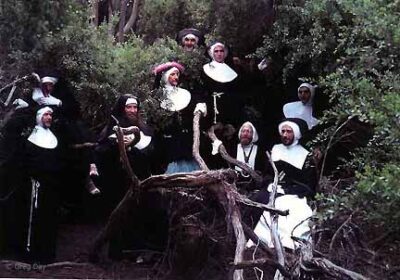
Sisters of Perpetual Indulgence © Greg Day
I went to the event they held to make their case against the city which was attended by a lot of people like Herb Caen, one of the iconic journalists upholding old San Francisco’s reputation. The Mitchell Brothers screened the film. The story was set in their movie theater and there was exact look alike of Dianne Feinstein, and Police Chief Con Murphy sitting in the front row. In uniform, Con Murphy reached into his briefcase and pulled out a dildo shaped like a cable car. The Dianne character spread her legs and as he put it in her vagina, she lit up. While the Mitchel Brothers’ film is showing, in the back of the actual screening room, there was this really loud laugh, and it turned out to be Police Commissioner Jo Daley, Dianne’s appointee. She was drunk as a skunk and was quoted in the Chronicle saying, “That's the funniest thing I've ever seen.”
I'm saying all this because Dianne Feinstein became a national hero. Once a U.S. Senator, she campaigned for gays in the military, and became the leading national voice for all things related to AIDS. Many times, she was the only voice and she stood her ground in supporting LGBTQ rights. Not only that, she provided more funding for AIDS advocacy than any other U.S. elected official. Dianne also became the number one advocate against guns in the country. She introduced and passed a national law outlawing the possession of automatic weapons. This law reduced mass shootings and lasted for 10 years until George Bush let it lapse without a fight.
So what else is on your list here, Jeff?
JJ: Well, there's several other things. But since we’re sitting here with Annie Sprinkle, a goddess of porn, would you talk about your history in the porn industry?
GD: Oh, I would love that. You know, it's so rare to have porn be discussed in the context of queer history unless you’re talking with other sex workers.
Well, when I moved here, I had a job lined up at San Francisco State University but then it fell through. I had to survive. I had my camera, so I became an event and portrait photographer. I also hung out with my artist friends. Early on I got a job photographing the parties at The Trocadero Transfer. These events were really elaborate. They had a designer and they spent lots of money decorating the venue. They hired me because I didn't do hard drugs, only a little marijuana. The previous photographer of their holiday party did not get one image in focus because the owner of the club put so many drugs up his nose. There was a lot of sex at these big events. This was the real Barbary Coast San Francisco. But the club was in Chapter 11.
I had a friend who did photographic stills for porn companies. I got hired to photograph box covers for gay porn. I also had a lot of requests from people to do portraits of them for their online profiles. There was a lot of sex everywhere and I went to a lot of sex parties. I started writing profiles, and then I became a contributing editor to several publications including “Drummer” and “Alternate” magazines. I also worked for “Hot House Video”. It was both a personal and professional pleasure.
But when the AIDS epidemic came along, sex became a danger and the scene became mostly obituaries. I stopped doing my erotic work. Then I was diagnosed with HIV. I joined the very first study in 1983. This is an important part of my history. I am a survivor. One of the few. My reason for survival, I guess, is to tell the story of those who are not here. For a long time, I felt that was my job.
Then I went to work for the Shanti Project as the Community Education Director. Shanti Project is a San Francisco non-profit human resources agency that helped people with AIDS very early on. I was in charge of all the training videos, as well as the monthly newsletter. So all of my photography, even some of my commercial portraits, had an activist agenda. These were images of our community taken from within, an immersive research methodology within anthropology. I had learned from the basket-makers that only the native knows best. As a photographer, I began to allow the subject to direct my shoot. I would give up control. I tried to change the dynamic so that it’s not a photographer and a subject. It’s people talking to each other through the camera. That's what it's all about.
Same with my erotic stuff that I created with my crew of cohorts in San Francisco. It was about presenting a queer aesthetic, a queer viewpoint of life. This aesthetic didn’t exist in our childhoods, or in much of our adult lives.
After my AIDS diagnosis, doctors told me I would have full-blown AIDS within 3 years and that would be it. But then after 3 years, nothing happened. So I decided that I would make as much change as I could in the short time I had left. It turns out the doctors were wrong. I think I am a mutant. About 5% of people of European ancestry have some inherited immunity related to the plagues, like the Black Plague, of the Middle Ages. So I thought, I've got to go back into the BDSM and fetish sex worlds and celebrate the sexuality of the survivors. Many of us who were HIV-positive started celebrating queer sex again, safely.
I got involved in porn. I worked with “Hothouse Video”. My photo models were people I met on the street or in my daily life. In 1995, Rosa Von Praunheim, a celebrated German filmmaker, came to San Francisco to make a documentary about 100 years of queer history. He had a big budget from the “ARTA TV” and a film crew. After his premiere of “Transexual Menace” at the Castro Theater, I asked if he'd been to any San Francisco sex clubs like Blow Buddies. He hadn't, so I said I’d take him there. He said, "We go tonight!"
Rosa had a large film crew and shot 40 hours of video in San Francisco for a 1-hour documentary. A year later, Rosa called from Berlin and said, "Darling, we'll have an exhibit of your photos. Come to Berlin for the Homo 2000 Festival celebrating the 100 birthday of ‘Magnus Hirshfield's Committee on the Science of Sexuality’; we will pay for your flight and accommodations. I will send somebody to the airport to pick you up.”
The show of my photos was at the “Akademie der Kunste”, which has been a Berlin art center for over 300 years. At my opening, Rosa introduced me as a famous world-renowned photographer from San Francisco. There was a huge crowd with lots of press. Rosa gave me a big kiss, and he told the audience, “Darling, your work is about nature. Cocks and trees. It's all about nature.”
In Berlin I spent two weeks staying at Rosa's apartment. When I came back to San Francisco, Tom Ammiano, who was President of the Board of Supervisors, told me he had the same great experience in Berlin. San Francisco felt like a hick town compared to Berlin. This experience made me reevaluate my ideas about art. Berlin opened the door, and the world got bigger and bigger from my European art experience.
In New York, on Thanksgiving weekend in 1995, I met Rick Karp at the Lure leather bar. We hit it off and went back to the hotel where he was staying. The next day he’s putting on his angora sweater and I told him he could be a porn star, he was a natural. A year later, he called me and said, “I'm coming out to San Francisco and I want you to introduce me to the porn industry.”
At the airport Rick didn't look like the same person: He was covered with new tattoos by a famous artist, his hair was cut short and he was buff from working out. Hot House Video hired me immediately to do a shoot of him and they also hired him as the star in his first film. They brought me on the set to serve as a fluffer. It was really a big film. There were over 20 porn stars featured! Cole Tucker (Rick’s stage name) was introduced to the porn world!
After that, I did 2 erotic books, both published in Berlin by Volker Johnson, thanks to Rosa. In these books were landscapes, portraits, fisting, golden showers. bondage, flagellation and oral sex. I asked Volker, “How will you get it past US Customs?” Barnes and Noble ordered the book at a German book fair and placed it in bookstores throughout the US. Because they were published in Europe and had tasteful covers, it was seen as art and that is how the books got through customs.
In 2000 my mother, who had moved to San Francisco to be near me, had a stroke that left her unable to walk She was in assisted living which was the only place I could house her. She wasn’t happy. Eventually I asked my friend, Jeff Jones what he would do in my position. He said, “you are spending over $30,000 a year on rent and both of you are unhappy. Your mother and you should buy a house in Palm Springs and you should move there. Then your mother can live out her days and you will own a house.” My mother loved everything about this idea. She was thrilled. So that’s what we did.
Some friends of mine from San Francisco had moved to Palm Springs to retire. They invited me down. It was winter with snow on the mountains and absolutely gorgeous. At the time that I left San Francisco, the dot.com bust was about to happen. The entire United States still has remnants of this diaspora of evicted San Franciscans.
My porn star buddy Rick was working as a realtor at Coldwell Banker in Palm Springs. On the first day of our search, I found the house I wanted and bought it. It was all serendipitous. My mother lived the last 5 years of her life with me in Palm Springs and it was a gift to both of us.
JJ: Okay, now I want to talk to you about the Queer Cultural Center (QCC), which you were a founder of. What do you think the impact of the Queer Cultural Center has been?
GD: Each of us who founded the QCC had a desire to present our art as a portrait of our community’s diversity, whether we were a person of color, a woman, or a white cis man.
JJ: When I wrote my first report about the boards and staff of the major arts institutions, you said to me, “Well, what about the queers?” So when I did my follow up study on arts funding at Grants For The Arts (GFTA) I compiled the statistics for people of color, women and queers.
GD: At the time, the mid-1980s, the City’s queer community was primarily white and male. People of color and lesbians were increasingly moving to the East Bay. White Gay men were the demographic majority in San Francisco’s LGBTQ community. The queer community struggled to include women and people of color. Creating the Queer Cultural Center was our dream.
QCC’s by-laws required that the majority of our board were women and people of color. We didn't just add more activists, we added brokers, and artists who were activists for cultural equity. It was fun to be part of this. Putting the National Queer Arts Festival together and making it balanced and equitable, was a labor-intensive job. Every one of us was involved. Ours was a working board.
JJ: Yeah, because we had no money. Not yet. The first grant that Queer Cultural Center got was from the California Arts Council’s Multicultural Advancement Program. They were awarding 30 grants of $2,000 a year for 3 years. The program’s Director, a straight Latina, said to me, “If people of color are the majority of your board, QCC is eligible to apply and you should.” We had originally inserted this particular language into our by-laws to give our organization credibility with the increasing number of people of color who were entering the philanthropic field. They were not sure they wanted to fund queers. But if you have a majority of queer people of color on your board, then they perceive your organization in a different way.
When we interviewed Pam Peniston, an African American lesbian, for the position of Artistic Director we were talking about the alliance-building that happened with the Community Development Block Grant Consortium (CDBG) of 1983. We succeeded because we built alliances with people of color. The first CDBG Consortium included Quentin Easter who was queer and African American, Elizabeth Min who was a queer Asian, Marie Acosta a mixed-race Latina/Native American, Alan Estes, a queer white man and Bruce Davis, the straight white Director of the Ethnic Dance Festival. We operated as a multi-racial lobby group; we sent selected combinations of people capable of addressing the interests of each Supervisor.
GD: We found some of the most talented, capable people in these communities. For a long time, I was totally enthralled by black women artists and their influence on me was huge.
JJ: Remember Adrienne Fuzee, the black dyke curator who was one of the original Board members of QCC and who died soon after we started QCC?
GD: Yeah, I loved her. Every government agency, every arts organization has to find a person like her; a queer person of color with a strong artistic vision.
JJ: That's why Pam Peniston was the artistic director of QCC. Whenever her position was threatened, I stood by her at all costs. She was the key to our funding. She was the face of QCC and she enabled us to secure any number of grants. By 2010, QCC was one of the first LGBTQ arts organization to be funded by the National Endowment for the Arts. One of Pam’s artist friends started working at the Hewlett Foundation, and suddenly QCC was funded there as well.
GD: But you know, I have not seen Annie and Beth’s live performances but I would love to see them sometime.
B&A: We’ll have to do something in Palm Springs. We're doing work about loving the Earth, environmental justice and ecosexuality. These days we are Fluxus-inspired, queer environmental activists. We are curious about preserving your archive. Has your archive been placed yet? Where?
GD: I have such a huge archive that it's going to go to several different places. I'm working on that. I don't have a place for my erotic work except for the Leather Archive in Chicago and possibly the “One Archives” in Los Angeles. I had an exhibit recently at LA’s One Gallery. I am also negotiating with Atlanta’s High Museum about purchasing my collection of baskets and photographs of the Gullah communities of the Sea Islands taken in the early 1970s.
Annie: We have so much in common that I'm surprised we haven't met before. I lived in lower Manhattan in the 70s to early 90s. I was also briefly a fluffer! I had sex on the piers. I also went to gay men’s orgy bars at the Mineshaft, the Tryst and the Toilet. I had quite the leather wardrobe. I am a photographer too. I majored in photography at the School of Visual Arts in Manhattan. I shot for all the sex magazines, including gay men's magazines. I was the woman who shot straight men for gay men.
GD: New York, in ‘75 or ‘76, was wild and radical, but still you could be sent to Rikers Island or be given a lobotomy if you practiced queer sex. We were still living under archaic laws. In 1976, I visited a boyfriend who retired from the U.S. Navy and went home to San Francisco. I learned that being gay was not only legal in San Francisco, but it was also important. To anybody living in the rest of America, regardless of your background, this was a shock. So I thought I have to get to San Francisco.
Most of us couldn't come out in our hometown or to our family, because we would have lost our jobs or our children. We could have been listed on a police profile. People moved from small towns to New York or Chicago. In the seventies, and there was a huge move from the East Coast to San Francisco and California. Ever since the Gold Rush, almost 150 years ago, San Francisco has thought of itself as the most important place in the world, when it is really just a village. You could put San Francisco in one neighborhood in Los Angeles. San Francisco is so incestuous and introverted that it believes it has invented everything and that, of course, is not true.
After the recession in 2008, I moved into West Hollywood and then East Hollywood for 12 years. In one month in LA, I met my partner of 15 years, Gordon Pollack, a fellow artist.
Mr. Jones created a following of art groupies, who worked collectively. Jeff created the California LGBTQ Arts Alliance, a statewide network of non-profit arts orgs and individual artists. The grant was challenged by artists in Southern California for under representation. As a former QCC Board Member living in Southern CA they signed me up to expand the original network. Mr. Jones said to me “I'm sure there are some other queer arts groups in LA. Let’s sign them up to create a network.” But in L.A. there are 7 queer choruses and an orchestra and all women's groups. L.A. had Harry Hay and the radical faeries, and the Mattachine Society before anything happened in San Francisco.
JJ: The Daughters of Bilitis founded by Del Martin and Phyllis Lyon preceded them.
GD: Los Angeles built queers into their economy from the start, because art is the number one business there-- a trillion-dollar industry. The art industry of LA has 5 times the economy of the Bay Area, including San Francisco. In one year I recruited 35 different organizations into the statewide queer Arts Alliance, funded by the California Arts Council. Nobody had connected them before. So they all said “sign us up.”
The Fowler Museum’s publicity person there was a very talented young woman who joined. The Hammer Museum joined. The Autry National Museum of the West joined. I discovered that Queers ran many of these organizations and served as the publicity and development directors of the Getty and many others. No one in LA ever said “no” to me. But in San Francisco, that's the first word out of their mouth. We'll have to think about it, the committee didn't give you a high enough score, we don’t know if you qualify. It’s business.
I have to admit that Mr. Jones educated me about the power of money. He had a theory about LA funding. The Alliance held a series of public meetings, one at “Highways”, one at the “Macha Theater” in West Hollywood, a lesbian theater company. People came and listened, but they didn't say anything, because they thought that they were already in the pipeline, but they were not. There still was no cultural equity. I retired as director of the statewide Alliance five years ago. Dante Alencastre, a film maker documenting trans gender activism, became the new director.
LA County adopted an ordinance about cultural equity that they learned about from San Francisco. Now cultural equity is required by the City and the County of Los Angeles. Los Angeles County has a 5-member Board of Supervisors and each of them has twice as many constituents than a US congressperson. The decisions they make affect everything in the country. Talk about cultural diversity. There are entire cities of Nigerians, suburbs of Ethiopians or Koreans. It's just like really off the chart. There’s nothing like it. The Bay Area is tiny in comparison. People get the arts in LA. There's money. Money and work.
B&A: Thank you for all you have done for queer arts, Greg.
JJ: You've been a very entertaining interview subject. I didn't have to say much. I could just let you talk. That's what my mentor Carlos Villa taught me. “Just let them talk!”
Guillermo Gómez-Peña
Guillermo Gómez-Peña
Featured Photo at top of page: Geloy Concepción, 2023.
Beth Stephens & Annie Sprinkle: How are you doing today?
Guillermo Gómez Peña: We’re doing well. We just got back to San Francisco after a three week tour in Texas. Emma will join us to help me answer a few of the more complicated questions, especially when it comes to funding. The more philosophical and anecdotal ones I’ll answer myself.
Emma Tramposch: Hello!
GGP: We’ve prepared ourselves for today with myriad notes. Your questions were very challenging. They forced us to open up the Pandora's box of memory. I love them, because they are very much in tune with our current research on living archives. I am really proud and happy to be a part of this archive. Thank you for including us. Before we begin, I want to take a moment to dedicate our interview to the memory of Lordres Portillo.
B&A: We are very, very lucky to have you.
GGP: We’re all in the process of working with our living archives. It’s paradoxical. We did a long interview with a Vietnamese historian recently where we had to answer some really tough questions about what we mean by ‘living archives.’ Essentially everything we own here in our San Francisco house, and our Mexico City house, in the Minnesota Street Project, in our suitcases— it’s all part of our living archives. The archives for performance studies and performance artists are very different from the archives of a writer or a visual artist. They include costumes, props, and objects in the house that are evidence of past performances and have been recycled into everyday life. What we do here at home or in your house is part of the living archives. It's complex.
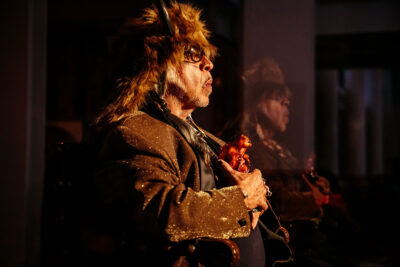
St. Joseph's Art Society performance, 2024. Photo credit: Vita Hewitt
B&A: Were you happy with the recent performance you did and we got to be in, at St. Joseph’s Art Society here in San Francisco?
GGP: Out of all the large scale projects La Pocha Nostra has done in San Francisco, this might be my favorite. The collection of individuals and the beauty against the stormy times. Three hundred people attended on a Wednesday night, in a time in which San Francisco is not entirely back. It was a testimony to the artists who worked with us. It was a beautiful project and it filled us with happiness. We are ready to reconvene next year.
B&A: It was definitely a love fest. High art.
ET: I spent most of my time mingling, eavesdropping and observing the audience. The event meant a lot to a lot of people.
B&A: It was a humongous ritual to mourn the state of the world and come together as people.
JJ: Could you please introduce yourself?
GGP: I am a nomadic artist.I transit between cities and countries; between forms and languages. My job is to cross borders and empower others to do it as well. I follow my compass, the mandate of my DNA. My professional ID is that of a performance artist, which means I suffer from a permanent crisis of professional identity. At times I am a reverse anthropologist and cultural detective; other times an experimental linguist, a radical pedagogue, a poetic journalist, but always: an artivist. I use non- traditional languages to express my social and political concerns. I identify with the term “artist citizen”.
B&A: Wonderful. Could we have some background on who you were before you came to San Francisco? Where were you born and what kind of family did you have growing up? Do you have memories of your high school years?
GGP: I was born in 1955, a year after you, Anita. I was born Guillermo Lino Liberio Gómez-Peña in Mexico City on September 23rd at exactly 12:00 pm. I remember that my bizarre intensity shocked my father. At a very early age, I had a very, may we call it, “performative personality,” and intense gaze. Like Lady Gaga says, I was “born this way.” My father was a gallant indigenous looking sportsman, civil engineer, and experimental architect who devoted his life to bringing electricity to the Mexican countryside, putting food on our table, and playing jai alai. He built the house we have in Mexico City. My adored mother fundraised for social causes and was the irrefutable nerve center of the family. Since my father was always on the road, the household was a matriarchal heaven. The women in my household loved when I sang ranchero in my tiny mariachi outfit.
I remember elementary school, playing guitar and futbol, traveling constantly to the Mexican countryside with my family, and secretly cross-dressing with my mother’s clothes and wigs. When Emita and I revisited those photos, I asked myself, “Who would ever imagine that that lovely middle class Catholic kid would one day become the seditious Mexterminator?” What caused this dramatic change? Performance art or the immigrant experience? Was it San Francisco? I don’t know…But I do remember that the visits to Mexico City of my US relatives, would instill in me a desire to come north, specifically to California, which I saw as the land of permanent reinvention.
B&A: Were there any artists, musicians, performers that inspired you when you were young?
GGP: Ever since I was a teenager, Mexican artist Felipe Ehrenberg was my "conceptual godfather." He transformed me into a performance artist. "Poetic cartographer" and “neologist” were the words he used. It's crystal clear to me that Felipe (Rest in Power) is still the most important experimental artist in Mexico and one of the most important in the Americas. For more than 50 years, he contributed with tenacity to the continuous expansion of the territory of art. We are here thanks to artists like him. He taught my generation to locate ourselves confidently in the Global South and in the so-called “third world” within the first world, including Chicanismo. He taught us the importance for Latin American artists to engage in the project of tracing our artistic and intellectual genealogy away from the cultural centers of Europe and the US. This is a very important idea. These other histories of experimental art are rarely acknowledged in the continuing Eurocentric biases of ‘official’ art history. I would argue this still persists and San Francisco is no exception. But we’ll get to that later.
A&B: When and how did you come to California?
GGP: My family has been migrating to California since the late 1800’s. We saw the “north” as an extension of our own household. More concretely, in 1978 I received a scholarship to study at the California Institute of Arts (Cal Arts) in LA. That year, I remember crossing the US-Mexico border in search of artistic fresh air and my lost Chicano family.
In my first trips to California as a young artist, I suddenly became brown. I was white in Mexico, but in the US I was a “wetback,” a “beaner,” a “greaser.” I ignored the implications of these words. I began my process of Chicano-ization with the unsolicited help of the Los Angeles police, who beat me to a pulp. But that’s another story.
I remember my first first conscious site-specific performances. I did a photo shoot outside of an INS detention center and I walked from Tijuana to the California Institute of Arts (in Valencia) in two and a half days. My head was covered with gauze. I was wearing my father’s suit and carrying a briefcase containing my passport, assorted talismans and a diary. Since then, crossing the US-Mexico border has been my primal ritual of artistic inspiration. I have crossed the border by foot, car, and airplane. I cross it in my dreams and writings. The feeling of crossing a border is liberating to me.
I crossed the border to confront nationalism and xenophobia with words, images, and ideas. I called my “weapons” performance art. The art world became my hideout & office. 23 years later, I became a dual citizen. It was only logical for a citizen of duality like me to certify the existence of my other self. But I am getting too philosophical, Anita, let’s get back to your questions!
JJ: I feel like we’re getting a private performance here.
B&A: We are!
Out of everywhere in the world, why did you end up here in San Francisco?
GGP: Comadres, you are forcing me to open up another pandora’s box of personal memories! But I want to begin to dance with my personal demons. Firstly, I should say that there has always been a historical cultural corridor that begins in Mexico City, moves through Tijuana, San Diego, and LA, and ends in San Francisco. Many of the luminaries in the Chicano movement did that trek.
I followed that corridor. I came here like many of my contemporaries, in search of a myth: San Francisco’s artistic openness, queerness, experimental spirit, conceptual chicanismo. I was very attracted by its bohemia. My work at the time was, fortunately, well received and I could perform any of my multiple identities in public here. That was liberating for me. But my fascination with San Francisco actually began during the summer of love in 1967. I was in San Francisco on a family trip with my mother and cousins, visiting relatives and staying on Lombard street.
As a 12 year old, I witnessed some of the many marches that summer and they completely flipped me out - I saw hippies, nude bodies, rock bands, inhaled the fog of marijuana- I mean, the experience was a full immersion into the city’s zeitgeist. I remember one day I went to buy my first rock and roll album, as a 12 year old, with my mom. In my broken English I asked the record shop guy to give me “the best music of the time”. He handed me a bunch of albums by Eric Burdon & the Animals, Janice Joplin, Jimmy Hendrix, Jefferson Airplane, The Doors. They all traveled back with me to Mexico.
The seeds for my return were planted during this initial, formative visit to SF, where I discovered the strong mythology of the city as a destination for radicals and as the original source of the protest and free speech movements that we are seeing now in their latest chapters in our universities, where students are protesting the mistreatment of Palestinians. SF was also a permissive setting with a confluence of a myriad cultures from Asia, Europe, and Latin America. That blew my mind. I remember we visited City Lights Bookstore on that trip, not knowing that they would eventually become my publishers.
To me, San Francisco was the city of tender demons and horny angels. Why the hell did we all end up here? But let’s not get entangled in a spiderweb of nostalgia. Next question please.
B&A: Once you moved here more long term, how did you become engaged in the San Francisco local arts community?
GGP: San Francisco’s Mission District has hosted and nurtured my madness for 39 (0r was it 30?) years.This wonderful barrio was so creative. So full of contradictions. It is the ultimate bohemian den. I revel in my longtime love for this hood. It’s been the stage for my art, my love, my friendships, and my escapades into forbidden territories, both on the streets and inside my psyche. It’s my personal laboratory for permanent existential reinvention. I’m here. I’ve written, performed, danced on fire and ice, loved my jaina, cried inconsolably, gotten drunk out of my mind and flesh, laughed, debated, demonstrated, escaped eviction and despair, confronted the cops, the demons of gentrification and the “alt right’ and neonazis crashing my dive bars here.
And after all these years, I still cannot solve certain mysteries: How come the Mission is sunnier and warmer than the rest of the city? Is it a Latino thing? Is it the heat generated by 700 taquerias? What is the source of this chemical, social, sexual, political and artistic stimulus? What draws people here? What social demons force them out or kill them? Are we seduced by the promise of bohemia in a country of restricted imagination, in an era of constrained freedoms? Are we then seeking freedom of the imagination, attracted by the mythical possibility of reinventing ourselves overnight? Of exercising all the selves and identities we wish to become without having to confront conformity every step of the way? Are we part of the ongoing wave of international exiles escaping failed revolutions and wars, from Salvador to Baghdad to Tijuana to Ukraine? Si? No? Maybe?
I didn’t know that the ultimate “Universal barrio” of the Mission would become a Bohemian theme Park for conservative techies and obnoxious “hipsters”. It’s unsettling!
A&B: Did you have formal training in your art practice?
GGP: Emma helped me research and remember this. From 1974-1978, I studied at the Universidad Nacional Autónoma de México (UNAM) in Mexico City and received a Licenciatura/Bachelor of Arts in Latin American Literature with a focus in linguistics. Then, after moving to the US, I continued my studies at the California Institute of the Arts (CalArts) from 1979-1982, earning both a Bachelor of Arts in Art Practice and an MFA in Post-Studio Art. But enough about my CV, next thorny question please.
JJ: Which LGBTQ and or BIPOC artists influenced you the most? Were they in San Francisco too?
GGP: The first gender-complex arts collectives that come to mind are ACT UP and Queer Nation. I became acquainted with them in the early 90’s in Los Angeles. If I'm not mistaken, ACT UP provided access to new therapies and argued that radical care and medication must be everyone's right. Queer Nation was an LGBTQ activist organization founded in New York City at the time. It was created by HIV/AIDS activists from ACT UP. The original founders of this amazing organizations were outraged at the escalation of anti-gay violence on the streets and prejudice in arts and media. I admired the group’s confrontational tactics, their slogans, and practices of calling out injustices and corrupt politicians. Silence = Death is still so pertinent to this day. I was also highly influenced by queer artists of my generation like David Wojnarowicz, John Fleck, Tim Miller and Ron Athey to name a few. They taught me to be bold and uncompromising, and my Chicano colleagues confirmed that call to action. I was groomed by them and I was groomed by the Chicano movement. I was very lucky.
JJ: Did you feel there was an LGBTQ arts community when you arrived in SF?
GGP: Contraband is the first group that comes to mind, with Sara Shelton Mann, Keith Henessey, Jess Curtis, et al. They were our first doppelganger troupe in San Francisco, and when they disbanded, Sara joined La Pocha Nostra on the road for 3 years.
JJ: Oh, really? Did she dance with you? Or do performance art?
GGP: We really pushed the limits to create spoken choreographies, and plastic stationary advances. She was out of her territory, and she loved it. We loved her contributions.
JJ: What venues did you feel the most at home in?
GGP: This is a tough one. We presented work throughout the city at countless art spaces over the years, and I do believe that every corner in the city is a utopian/dystopian space and every space in our own neighborhood is a potential performance space.
But the “venue” I feel the most at home in is my studio, our Casa Museo, here in the Mission. My home here in the Mission connects my life as an artist with a cityscape, the larger Chicano experience and with all humility, with the international performance art world. For over 30 years, this loft has been a demilitarized ‘free zone,’ a bohemian den, where original art parties, performance salons & artistic & political discussions have taken place. These events, attended by rebel artists, activists, intellectuals and dandies and are tied to the San Pancho bohemian tradition of radical hospitality and deviant behavior. The campaign of Green Party candidate “Krissy Keiffer for Congress” was launched in our living room. A local TV station called it “The Smithsonian of the Barrio.”
Now, in the late 90’s, the rampant gentrification of the Mission put our neighborhood in permanent danger of becoming a bohemian theme park, or the headquarters of the tech industry. Then pandemia arrived and the tech industry fled the city, leaving it in ruins. We are now attempting to bring it back. More recently, during the 2020 lockdown, this site became our survivalist art bunker and zoom broadcasting barrio station for our podcasts and virtual performances. In short, my live/work space continues to be my longest durational performance installation & conceptual zone.
B&A: We’ve seen some of the best performances of our lives in your home.
JJ: You were connected to Galeria de la Raza for so many years. Could you talk a little about that? Did you have a mentor there?
GGP: My formal relationship with Galeria de la Raza began in 1984. My troupe at the time, the Border Arts Workshop, was born at Galeria at precisely the same time Culture Clash was founded. Since then, I was an active member, curator, collaborator and advocate of many Galeria administrations.
In 2010, La Pocha Nostra was formally invited to move into Galeria’s Studio 24 at the corner because it would be “mutually beneficial to both organizations.” We were looking for an anchor in the Latino Mission and Galeria wanted La Pocha’s international scope and connections to Latinx experimental artists within and beyond SF. So, for 7 years, we occupied the corner space of Galeria.
During those years, we co-presented dozens of exciting public events including workshops, performance and spoken word salons and talks pairing local and international artists. Studio 24 at the corner of 24th & Bryant was our ongoing rehearsal, brainstorming, workshop and archival space. Then one day, we got evicted. It broke my heart.
JJ: Before we leave this topic, could we talk about Rene? 1984 was right before he got fired. Do you remember that?
GGP: I thought that was the end of the world for me. This ties into the question you asked, about my mentors. Rene was one of them. I had many… Rene Yanez, Amalia Mesa Bains, Yolanda Lopez, Susan Lacey and Esther Hernadez to name a few. Amalia taught me an unforgettable lesson. She said to me one day, "Gomez-Peña, if you are offered a mic, don’t give it back.” Those were the words of a true Chicana leader. Rene, of course, was the godfather of the Mission. For over 40 years, he helped make this a city where subversion, creativity, and irreverence were not only “tolerated” but celebrated, where the politics went far to the left of everywhere else in the US. That was the San Francisco he showed me in 1981 when I first met him and the one that welcomed me back in the mid 90s.
This was the place where anyone could come to live out their alternative dreams, where artists and visionaries filled the cafes, a sanctuary city where migrants, outsiders, subversives and deviants could find refuge, including me and all of our close friends. It provided the perfect setting for La Pocha Nostra to emerge and thrive.
JJ: Rene did that for so many people. Culture Clash was Marga Gomez, Monica Palacios.. there were 6 original members, right? Rene was one of the first artists of color to get funded by the city of San Francisco, way back there in the late 70s, early 80s. That’s when I first ran into him. You could tell he had great ideas about once a minute. I think it was Renee who introduced us to each other originally. Or maybe Marie Acosta? I remember that you were staying in my house here and performing in Festival 2000. Did you get paid for that? Or did you get ripped off like most people?
GGP: My financial memory is not in great shape. I don’t know.
JJ: That's how we got the Cultural Equity Grants Program. I think it was Marie Acosta who introduced me to you at the Mexican Museum. Another awesome connection is that the head of the California Arts Council was the director of Highways Performance Space. That organization produced so much.
GGP: I'm very proud to say that that was my generation of performance artists in Los Angeles. The Hittite Empire, Dang Guan and so many other artists like Marcus Kulianasario who twisted the arm of Susanna Dakin to make it a performance space.
XX: That was quite a group of people. Keith Antar Mason, Sherry Rabino, the pioneers of the cyberats movement. It was a convergence of amazing minds.
JJ: You were so identified with Rene in San Francisco and with Highways in L.A.. Two really vibrant organizations.
GGP: My dear Jeff, I was so lucky.
JJ: You're credited as one of the founding members of Highways. I ended up being the grant writer somehow, believe it or not.
I remember that after Rene was fired, I would see him everywhere passing out pamphlets. He got hired by Jack Davis to be the janitor. Can you imagine? One of the most brilliant curators in town got hired to be a janitor. And yet he was thankful.
B&A: Guillermo, what was your first big artistic breakthrough?
GGP: It happened in the Tijuana/San Diego region. In 1984 I formed “The Border Arts Workshop”(BAW/TAF) with a bunch of visual, performance and conceptual artists, a bi-national arts collective involving Chicano, Mexican and Anglo artists. Our objective was to explore US-Mexico relations and border issues using a mix of performance, video, and experimental poetry. I remember proclaiming the border region "a laboratory for social and aesthetic experimentation," and proposing "the artist as a social thinker and bi-national diplomat." Our public relations with law enforcement really sucked.
But I remember similar activist groups forming in other parts of the country, including the Guerrilla Girls, Group Material, ACT UP and the Los Angeles Poverty Department. Performance, political activism and community concerns were completely intertwined in the spirit of the times.
In this context, BAW/TAF’s strictly artistic activities helped protect our backs and legitimize our more activist work and get us out of jail. So in addition to binational art shows, publications, radio programs, town meetings and films, we organized performances right on the borderline, where the U.S. meets Mexico in the Pacific, literally performing for audiences in both countries. When the border patrol got too close, we crossed to the Mexican side. During certain performances, we invited our audiences to cross "illegally" to the other side. We exchanged food and art, caressed and kissed "illegally" across the border fence, and confronted the border patrol in costume. We were protected by the presence of journalist friends and video cameras. The political implications of the site and the symbolic weight of these actions garnering us immediate attention from the international media. These were the origins of the border arts movement and what I consider my early “breakthrough”.
JJ: That was how many years before you got the MacArthur Genius grant?
GGP: Probably 10? The Borderers workshop was founded in 1984, and the MacArthur was in 1991.
JJ: How did government funding impact your career?
GGP: I cede the word to my dear colleague Emma Tramposch, La Pocha Nostra’s Executive Director and Curator of the Living Archives. She has been the holder of the Pocha Nostra House for at least 15 years and is our internal historian on this topic.
ET: I’m happy to help fill in some details. Since La Pocha Nostra is also a non-profit as well as an arts collective many kinds of funding have impacted GP’s career and the organization’s chronology. From the government funding side we are grateful recipients of local, state and national funders including the San Francisco Arts Commission, Grants for the Arts, the California Arts Council, NALAC and the NEA. Over the years these funders have supported not only the realization of many performance projects but also with operating expenses related to keeping the lights on and capacity building. La Pocha Nostra also has multiple progressive non-governmental foundations to thank too. But I know the question was about government funding. It’s certainly been a helpful boost over the years.
B&A: I have to ask, what were your first encounters with queer arts organizations?
GGP: That’s an impossible question. I have only ever worked with or collaborated with Queer-identified or queer friendly arts organizations. If they aren’t gender- or race- complex, we simply don’t work with them. Period! We’ve made a few missteps with places we thought were more inclusive and paid for it. But that’s the subject of another book titled “The Touring Misadventures of La Pocha Nostra…in a Post-Democratic Era.” Soon to be published by a random house.
B&A: Any random house! You crack us up.
What unique contribution do you think you made to the City’s queer and or BIPOC arts history?
JJ: You performed in the National Queer Arts Festival. I still have the poster on my wall.
B&A: Plus you have contributed greatly to our ecosexual movement. You oversaw our Ecosex Pride contingent in the SF Pride parade once. And co-authored our Ecosex Manifesto 2.0.
ET: La Pocha Nocha was founded in 1993 Los Angeles by three BIPOC artists with the explicit goal of gaining access to public and private grants that non-white artists rarely seemed to get. The original thinking was that by founding an organization dedicated to creating work that put BIPOC people at its center, this would both lessen their marginalization and - as a non-profit organization – give us greater access to funding that was usually reserved for “mainstream” artists.
At the time, and I believe still to this day, LPN has been a pioneer in the field. For 35+ years, alongside a roster of national and international touring, LPN has maintained an artistic foothold and base of operations in San Francisco’s Mission District. Here, we have presented several large scale participatory performances (like the Mexterminator Project, in 1997), solos, keynotes, site specific performances and pedagogical intensives at many spaces including SOMArts, Galería de la Raza, Mission Cultural Center, Brava Theater, Fort Mason Center and the SF Arts Commission Gallery. LPN has also presented countless site-specific pieces commenting on themes pertinent to local audiences such as El Corazon de la Misión (2007), a participatory “bus tour” of the neighborhood and The Phantom Mariachi (2016), an interactive performance piece commenting on gentrification and the displacement of artists and marginalized communities.
B&A: Iconic! We have experienced both of those pieces and they were absolutely fantastic and inspiring.
Which arts discipline would you say best describes your practice?
GGP: Well, like you two, I’ve always created my own artworld. In 1993 when we formed La Pocha Nostra, the objective was “to create an interdisciplinary association of rebel artists interested in collaboration.” We were inspired by Zapatismo, and our collaborative model of “concentric and overlapping circles” has functioned as a means to create “ephemeral communities” of like-minded artists in different cities and countries.
The Spanglish neologism "Pocha Nostra'' loosely translates to "our impurities'' or the "cartel of cultural bastards or traitors." It reveals our attitude towards art and society: interracial, poly-post-neo-gender, ultra-retro-experimental, trans/national, or a remix of all of the above.... During all these years we’ve created pedagogical experiments, artivism, books, digital art, and large performance events involving dozens, hundreds of artists and curators. We live across several countries and languages. Sometimes we are strategic insiders in the art world, like tonight; other times outsiders by will.
Ahora, why do we still use performance as a matrix? What interests me the most about performance is its ability to connect the bodies of the artist and the audience with the civic sphere in real time. I think of the human body as a metaphor for the body politic; and the space where the performance or workshop takes place as a metaphor for the social body. We believe in the pedagogical dimension of performance. It provides a portal for liberation.
Nowadays, freedom is a loaded term. But performance artists share a relentless search for freedom. The freedom to be able to move between various territories: art, activism, experimental sexuality, popular culture, journalism, new technologies, etc. Even within the territory of art, performance art does not recognize borders. I can be a visual artist, poet, theater artist, producer, installation and video artist at the same time. People even called me a “vernacular philosopher.”
B&A: We mop, we cook, we clean the space… It never ends.
Do you perceive different evolutionary stages in your career?
GGP: I’ll give it a try, broadly. These are my “periods”. First, my Mexican period, meaning, the time in my life prior to migrating to the US in 1978. Then, my “border arts period” while I was living in the Tijuana/San Diego area including Los Angeles (when I was studying in CalArts). Those were my formative years. I also lived in New York for 3 and a half years in the early 90s and my art was connected to the multicultural debates at the time, mainly the politics of display and the troubling representations of Otherness in mainstream museums… And since 94, I call this my San Francisco period, a site specific body of work always created in dialogue with the local arts community. I’m beginning to sound a bit pedantic, but the question is such. I also have many other bloody periods.
B&A: Do you feel “otherized”? How and by whom?
GGP: Being Mexican in Southern California meant waking up every day and, as an act of will against all circumstances, deciding to continue being Mexican. Whether we liked it or not, we became part of a culture of resistance. Looking "Mexican" or speaking Spanish in public was in itself an act of political defiance. Our position vis-à-vis the dominant culture of California was paradoxical. We were everywhere and nowhere. We were the largest "minority" in the state and at the same time, the least represented in the power hierarchies; we constituted the backbone of the economy at the same time we were perceived as the monstrous specter in the Anglo-Saxon imagination. More paradoxes: We built the romantic backdrop of California with its favorite cuisine and music, and at the same time we posed a fear of epic proportions: Godzilla with a mariachi hat!
If it had not been for Chicanos and other American Latinos I probably would have died of loneliness, nostalgia and invisibility. Chicanos showed me a different way of seeing myself as an artist and as a citizen. Through them I discovered that my art could be the ideal medium to explore and reinvent my multiple and changing identities (something that would have been unthinkable in Mexico at that time). One of the basics of our work has been precisely to answer this question.
JJ: How do your artworks reflect the eras in which they were produced?
GGP: I firmly believe the role of the artist is to actively engage citizens and local arts communities in the larger debates of our times. I think of collaboration as a form of radical citizenship. I collaborate with performers, photographers, filmmakers, choreographers, musicians and poets, and utilize audience interaction as artistic strategies to illustrate my ideas across national borders, race, gender and generations. It sounds heavy but we’ve been doing it for almost 40 years and we’re good at it. My projects involve acts of citizen diplomacy and strategies to create communities of "rebel artists” devoted to erasing the borders between art and politics, practice and theory, artist and spectator.
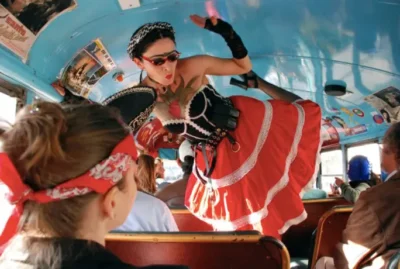
El Corazón de la Misión: Violeta Luna aboard El Corazón de la Misión bus, 2008. Photo credit: Katia Fuentes
I want to talk briefly about a project that Emma mentioned earlier, my 2007 interactive bus tour projec,t “El Corazon de la Mission” because it’s important for this archive project. The “art bus” was decorated inside and outside by local artists. Passengers on The Mission Tour were invited to participate in a Mexican “processional,” as if they too were personas on a parade float. In a way they were "eavesdropping" on the neighborhood, using the windows of “the Mexican Bus” as a safe vantage point to watch the street…and they were also eavesdropping on my own artistic mind. For the duration of the tour, people on the street became involuntary performance artists on the stage of the rapidly changing neighborhood, immersed in a traveling poetic/performative journey across a mythical bohemian Mission…Pocha Nostra members were also performing live on the streets. I was the tour guide, and my poetry was the itinerary.
That’s one of our favorite SF based projects, ever.
B&A: Yeah, it’s one of our favorites too.
JJ: I liked that one a lot myself. But the one I remember most is the Mexterminator. That was probably your largest project in San Francisco, if I’m not mistaken. It was operatic. I was the grant writer for Jack Davis, so I wrote the grants for that too. That was a really challenging, in-your-face kind of work.
B&A: Does your art address social justice issues? Which ones and why?
GGP: The idea of creating work that gives voice to those who feel like they have no voice – no ability to affect policies and systems that denigrate their quality of life - has been central to LPN’s creative practice. The consideration of diversity and inclusiveness and attempting through our art to change systemic injustice and inequity is a part of every project we undertake, without even mentioning it. We view artists as citizens of the world whose role is to employ art to achieve social justice.
ET: La Pocha Nostra is committed to so-called “artistic excellence,” but we’re equally committed to pursuing social justice for all the people of San Francisco and the cities we tour, especially those disenfranchised people who routinely have had little or no experience of equity or inclusion. Lately we are committed to our living archives and making them accessible for generations to come. La Pocha Nostra’s living archives are a powerful testimony of a lifetime of artistic border crossings and troublemaking in many directions and cultural contexts. The collection is “American” in the largest sense of the word, but also includes documentation of work done internationally, especially in Latin America. The nerve center of our Living Archives is here in SF. So that’s kind of a circular way of answering your question.
B&A: The way that you support your community is phenomenal. In this alienated post-COVID era, that kind of support for your friends is so important. I remember you brought Rene over here to our house when he was trying to fight his eviction and that was so moving to us. The performances at your home are so beautiful, and a whole range of people are always welcome there, from young artists to old friends. It’s beautiful how you hold your community. I think that’s a real social justice issue too. It’s a lost vision of radical hospitality that you don’t often see anymore. This city is so fragmented now, but we still support each other here. It just doesn’t feel competitive.
GGP: Yes, I agree with you Annie.
JJ: But you know, back before the Arts Commission started giving out money to people of color and queers, it was very competitive. Everyone competed with each other and it was very cutthroat. When we started the Queer Arts Festival, we wanted to show people how much further we could go if we worked together rather than competing with each other. When the SFAC committed to having specific money for POC and queers, it really made that possible. But it just wasn’t true before 1992. If you were a Latino arts organization, you were seen as a challenger to Galleria. That’s the way people thought.
But then we got the funds to empower communities of color and queers, and that was just unheard of. California’s Proposition 209 says that you cannot use race to decide anything. Well, that’s exactly what we did with the Cultural Equity Grants Program, and nobody has challenged it. I don’t know why. They could’ve thrown us out after a month. I think a lot of it had to do with Grants for the Arts’ terrible reputation for being racist.
It’s interesting, too, that you used the phrase “artistic excellence”, which is a term that many people who opposed diversity also used. The diversity and inclusion people won and artistic excellence has gone down the drain. People don’t get funded anymore because they’re doing great artistic work. Now you get funded because you know how to answer the questions on the grant.
B&A: Interesting perspectives, Jeff.
Guillermo what motivated you to advocate for diversity as an artist? What was your role in transforming the SF arts community? Don’t be modest.
GP: Emita, please help me. I don’t like to talk about my own achievements.
ET: La Pocha Nostra’s mission is to create performances that speak to the lives of our region’s Chicanx/Latinx and all people designated as “other” throughout the world. We accomplish our mission by providing an artistic home for a loose network of rebel artists from various disciplines, generations, and ethnic backgrounds whose common denominator is our desire to cross and erase dangerous artificial borders between art and politics, practice and theory, artist and spectator.
By creating work that speaks to the Bay Area’s diverse Latinx communities, which have historically been (and continue to be) economically disenfranchised and underserved, our programs bring to light issues faced by all people designated as “other” (than white, male, English-speaking, straight, Christian and of European descent). We think deeply about what content will “cross borders” – that is to say, we care about cultures and communities other than our own and desire to understand them on their own terms.
Our projects offer audiences the opportunity to be not merely spectators but to interact with performers and each other as performances unfold. We consider ourselves rebel artists, by which we mean we believe that many things that separate people are artificial borders constructed by people/groups/political parties who benefit from divisiveness. As citizen artists, we believe it’s our responsibility to cross these borders.
JJ: Can you tell us about your involvement with organizations like the California Arts Council and SFAC Cultural Equity Grants program? Do you think that these groups contributed to the diversification of the national arts community?
ET: I can help elaborate here. Over the course of GP’s career as a working artist he has received funding from CAC and SFAC for individual projects & performance work and La Pocha Nostra has also received capacity building grants. Most recently from SFAC, GP and LPN were the recipients of the 2023 Artistic Legacy Award honoring over 30 years of artistic leadership. This helped fund the recent extraordinary event that Annie and Beth were involved in at St. Joseph’s. We are grateful for these funds, of course, but I am not sure how I can comment exactly on how these funders have directly impacted the diversification of the national arts scene as a whole... We certainly hope it is true that there has been a significant increase in funding and prioritizing for BIPOC and LGBTQ artists. We also hope that the review panels are equally as diverse and knowledgeable since they are critical to the outcome of an application's funding.
JJ: Personally, I think it’s time for a total reanalysis of the peer review process. Now it’s just like playing roulette. We have these panels of young people who just showed up to San Francisco who are now deciding how millions of dollars get spent in the arts. They don’t know who you are, or who Annie Sprinkle is. They don’t know anything. It almost feels like I would much rather have the Arts Commission making the decisions instead of these amateurs who come in and are getting on-the-job training while deciding the fate of numerous artists in the process.
Emma: I totally agree. I think the whole system needs to change.
JJ: Foundations are better off in this regard because they’re not pulling in random panelists, and they’re doing research. Their staff are being paid to do this and they do a good job. Previously, they only funded white people because they were afraid that their boards would get bent out of shape if they funded amateur artists or folklorists or whatever.
B&A: Reverend Billy, who just opened for Neil Young last night, was talking with us about artistic excellence versus community also. He had to pick the fifteen best singers to go on this tour and they weren’t necessarily the best community members and he said a lot of feelings got hurt. So it’s a balance. These aren’t opposite things. Hopefully you can have both.
JJ: What have the biggest challenges been to this diversification in the arts? Who pushed back? Why? What prejudices or challenges did you face? Is there as much pushback now as in the earlier decades? Stories please.
GGP: From 2012 to 2015, I wrote obsessively on the dangers of the ultimate “creative city,” the much-touted “post-gentrification era” and what it meant to be a foreigner in my own neighborhood waiting for an inevitable eviction notice. During this time, my own troupe was evicted from our infamous 24th street studio in the Mission District of San Francisco. My obsessions were also driven by what some may describe as philosophical or material anxieties. In both cases, I ask a similar question: how do I wait? Or should I even continue to wait?
But we endured and decided to remain here. Sometimes I felt like the last standing Mexican artist in the Mission. More recently pandemia and confinement, and the tragic death of George Floyd shifted the conversation, and cultural institutions were forced to look inward and reflect on their systemic colonial and racist practices. Now, have they done it? They are all now talking about “social justice” as the word of the month. But are they walking the walk? This is a topic for another conversation..
B&A: How important have grant writers been to this change? Could this move towards diversity have happened without the diversity grants for artists?
ET: I see grant writers as providing the invaluable connective tissue between an artist's ideas and goals and access to a funding source. Since “grant-ese” as we call it internally is such a specific language, grant writers need to be magicians in adapting artistic concepts into pointed grant language that will resonate with a panel or funding body and succinctly describe a project. Yes, I personally believe a “sea change” of diversity would happen regardless. But that funding for artists is vital, and it can assist in realizing a whole artistic trajectory and funding should increase each year.
B&A: Did Jeff write grants for you? What do you think his role was in this sea change?
GGP: We see Jeff Jones as the orchestra conductor of all the non-main stream organizations in the city. Period. His contribution to a “sea change” cannot be overstated enough. We can testify to the importance of his grant writing for organizations like the Galeria de la Raza, Dance Mission, Cultural Odyssey and many others and also for the guidance role he has offered for LPN and many others. He has raised over 100 million dollars for BIPOC and GLBTQ artists in San Francisco. Which has no doubt made for a more equitable and interesting art scene in the Bay Area. He deserves all the medals from the goddesses of the funding world, or at the very least a gorgeous, permanent artist made bronze statue or mural in city hall. Jeff es un chingon!
JJ: Well, I don’t need accolades because I’ve met so many fabulous people. They are my life.
B&A: What was the art scene like in the 70 to the 90s compared to now?
GP: With pandemia and confinement, we were forced to redefine time and space and reconsider body-based art practice. Remember those days? We lost our live audience, our main source of energy. And in the absence of human contact and political certainties, we were 'zooming’ everyday, and dreaming a lot, trying to artistically survive by performing an illusion of “live art,” online, a contradiction in terms.
In 2020 and 2021, my colleagues and I had a myriad of questions. What exactly was performance art in times of triple pandemia and generalized paranoia? If everything we loved; – international touring, crossing borders, working in community, in proximity to other bodies and if we couldn’t do it anymore, how could we possibly reinvent ourselves to bear this perceived impossibility? How could we “embody” our artistic practice on/OFF line or on zoom? Could our wounded bodies and frail minds crossover into Siberia? It was heavy.
Now, in the current political landscape–the culture of pervasive fear, the new social restrictions on sexuality, and the prohibition of the debates on war, imposed by academia and the media, we are presented with more challenges when teaching and presenting performance. A new elliptic culture of euphemisms and circumventions is affecting our aesthetic choices (consciously and subconsciously). The new question is, how can we exercise our full citizenship through performance? How can we continue to talk back to power and fight for freedom in a setting of hyper-conservatism and puritanical discourse coming from the far right and the liberal left? These concerns simply did not exist 10 years ago, or earlier.
B&A: Gay marriage was legalized almost ten years ago and everyone shrugged. But now we’re back at “don’t say gay” and anti-LGBT legislation is being introduced all across the country. It’s pretty disastrous. Abortion rights, civil rights, the fact that librarians in 17 states can now be charged with a felony if they check out the wrong book or that doctors can be jailed for performing abortions.
JJ: I remember that before Michelle Tea left town, the last grant I wrote for her was for the first Drag Queen Story Hour, and it got funded. Now people think “oh my god, they’re grooming children to be queers!” But it wasn’t even for straight kids. It was for children of queer people or even kids of straight parents who didn’t want them to inherit a culture of homophobia. That’s why it was founded, to guarantee that these children would not be brought up with homophobia and sexism and racism as their only options. And look at what they’re doing now. Nazis are assembling outside libraries where something as innocent as that is going on.
B&A: Do you think the future will be more diverse? Or could all of this progress be erased?
GGP: I am afraid that the city will incur the same historical mistake. To hand the city yet again to another tech industry, say AI or biotech…instead of emphasizing the importance of funding arts and culture as the key to bring back the spirit of the city. If I were a politician, I would appoint a board of artists and writers to oversee the so-called return of San Francisco. People tell me…dream Mad Mex.
Now the challenge for arts funders in a city which is almost 16 percent Latinx is to purposely fund Latinx art, which we notice has fallen off the table in the last decade. After all these years, the only visible remaining Latinx organizations in the city (that I’m aware of) are the Mission Cultural Center, the new Galeria de la Raza, Accion Latina and La Pocha Nostra. It breaks your heart.
We wish to convince funders to truly invest in the Latinx communities and believe they have become invisibilized. Why does the contemporary US look towards Asia, Black America and Europe but not as much towards Latin America? We think this is one of the many forces behind why Latinx working artists have had to leave the city.
JJ: In the last two years, the city put out the Dreamkeeper Initiative, in which they poured 2-4 million dollars in the black arts community. Now that community has about 4 or 5 stable groups doing good work. But the Latino arts community is still a mess and there are twice as many Latinos as there are blacks in San Francisco. Mayor Breed is ripe to do something for the arts in the Latino community. But at the same time, the city is about to pull the plug out of the Mexican Museum.
JJ: Well, the Mexican Museum has been an absolute mess.
B&A: Are there any final thoughts you want to convey in this oral history archive?
GGP: Our intellectual and artistic elders have been abandoned by society. No one is listening to them. Very few young artists are actually working with them. What if all artists chose an elder from their communities to adopt? Once a week they could spend time with their adopted elder, listen to their stories, take them for a walk or a drive to a place of their choice, document carefully their opinions, listen to their new compositions, help them choreograph their latest illusion, organize their archives, and of course in the process, help them make their living spaces more pleasant and vibrant by bringing other artists to talk to them. We can also extend this service to artists who have been impaired by illness and even to the homeless in your street.
In general we also see a new pandemia emerging that has to do with mental health and feel it is important to address this in the arts.
B&A: That’s very true. Wonderful ideas.
Before we go, and as you reflect on your contributions to the arts and the challenges you’ve overcome, do you have any advice or insights to offer to emerging BIPOC and LGBTQ artists who are navigating their own artistic journeys?
GGP: Be clear minded and uncompromising. The times are extremely delicate and dangerous. Art can be one of our possible salvations.
Thank you, Jeff, Beth and Annie, for your work on this project. It’s an important one. Okay, love you. Goodbye.
Rhodessa Jones
Rhodessa Jones
Is a dancer, theater performer, teacher, and co-artistic director of the San Francisco performance company Cultural Odyssey (with Idris Ackamoor). In 1989, on the basis of material developed while conducting classes at the San Francisco County Jail, Rhodessa Jones created “Big Butt Girls, Hard Headed Women,” a performance piece based on the lives of the incarcerated women she encountered.
During the work's creation, Jones and jail officials were made aware of issues that were specific to female inmates, such as guilt, depression, and self-loathing, which arose in response to feelings of failure in the face of community. These issues directly contribute to recidivism among female offenders. Based on this observation, Jones founded THE MEDEA PROJECT: THEATER FOR INCARCERATED WOMEN to explore whether an arts-based approach could help reduce the numbers of women returning to jail.
Beth Stephens & Annie Sprinkle: Hi Rhodessa. we have a nonprofit called E.A.R.T.H. Lab SF. We do environmental art through an ecosexual and environmental justice lens. We got a grant from the San Francisco Arts Commission to interview 10 important artists like you.
So in a nutshell, we're recording the history of GLBTQ and BIPOC artists and activists who changed things in a big way in the 70s, 80s, and 90s. On June 1st, 2024 we'll present our findings at the Main Branch of the San Francisco Public Library and launch this archive online. Beth has been a professor at UC Santa Cruz for 30+years.
RJ: Is that where Angela Davis is?
B&A: Yes! She's retired, but she still comes to events about social justice.
RJ: Hi Jeff. How are you?
Jeff Jones: Hi Rhodessa, I'm doing well.
Let's start. We can begin the interview with some background on where you grew up and how you got to San Francisco.
RJ: I was born in Florida. My mother and father were migrant farmworkers and they got their first agricultural contract the year that I was born, in 1948. My dad gathered some people together, got a couple of vehicles, and we drove from our home in Florida all the way up to New Jersey, picking fruits and vegetables. We were gone for 5, 6, even 7 months a year. After a point, my mother decided we had to stop because she wanted us to have a better education than she and my dad had received. So we ended up living in upstate New York outside of Rochester, NY. We settled in a little town called Wayland; I graduated from high school there.
I fell in love with Riley, a crazy Irishman. We met in Rochester and ended up going to Costa Rica because we wanted to leave the United States. We had some friends in Bogotá, but when we got to the border in Colombia, they wouldn't let us into the country because we were hippies and we didn't have any money. I had my kid with me, she was 9. My kid was born when I was 16 years old and I was still in high school.
We had been living in Costa Rica and my daughter got really ill. I had friends in Palo Alto, California and they sent me the money so I could come to California to take care of her. She had gotten some bad bug. She was really sick with a high fever. I always tell people it was jungle fever. We had to travel from Costa Rica back to LA and then up to Palo Alto. We moved to San Francisco in 1973 or 74.
B&A: We were reading about how you supported yourself while you raised your kid. Would it be possible for you to talk a little bit about that?
RJ: Sure. I was dancing with a company called Tumbleweed, which was a women's dance company here in San Francisco. All of the dancers who were performing and making art were also dancing nude at night. When I got word of it, I thought I could do that. I'd been an artist's model and nudity was nothing to me. They wouldn't hire me in North Beach, because they didn’t hire black girls then in North Beach. So I ended up going to the Tenderloin. There I met a great couple, who had set up Fantasies in the Flesh. They thought I was so cute, and I had my wig and great legs and they said, “Sugar, you can work here with us.” They didn't want me to wear my Donna Summer wig. They were saying, “Oh, you are so much more beautiful, so much more dignified, without your Donna Summer wig.” And I said, “Girls, this ain’t about no dignity down here.”
We had a great time. The place was owned by a guy named Al Brown, who kind of fed on young black women. I liked to read. One night I was reading Shogun and I put the book down to go on stage. James Clavel the author of Shogun just happened to be at the club. When I come off, Al says, “Which one of you bitches is reading Shogun?” I said, “I'm reading it.” He said, “Well, this is the author.” Mr Clavel offered me his autograph but I said, “No thanks darling. I have your book. I don't need your autograph.”
It was an interesting time. I started to flex my femininity and my feminine politics. The management didn't feel responsible to clean up the club, instructing the dancers to do it. They felt like we were naked, dancing, and that we should clean up. One night, a woman was lying on stage, turning around and a mouse ran across her body. She freaked out. We all freaked out.
Al said, “Well, clean the place up.” I said, “Oh, no, no, no; secretaries do not clean up offices, Sir.” He had decided I was a cop. I said honey, “I'm many things, but I'm not a cop.” And, he said, “I got my eye on you, Lily.” And the women were curious as to who I was because I had an opinion and that was out of character.
This was an incredible time in San Francisco. But after the assassinations at City Hall, I remember being afraid. The peep-show booths at Fantasies in the Flesh had two sections. I sat behind a window and customers on the other side would put in coins and the curtain would open. I would just sit there with my legs open, you know, because I figured that's what they wanted to see. Later, I wrote a performance piece entitled, The Legend of Lily Overstreet; it was about nude dancing in America.
The big questions for me were what do men want from women and what do women want from men? And why do sex and race make such interesting bedfellows? These are the questions that I posted in my journal as I started to write Legend of Lily Overstreet. There was a young black guy whose job was to clean the cum off of the windows. At first he thought he was gonna get to peek at naked women. I said, “No, no, honey, this is a job.” And he and I started talking and it turns out he went to San Francisco State. He brought in books by Franz Fanon, books about race and culture. He and I started talking about life and dreams. I saw him opening his eyes to the fact that this was just “a job”.
I wasn’t a bimbo; I wasn’t sex crazed- I was working. I remember once while I was working, I would play Mose Alison’s music. A guy came in and said, “Who's playing this music?” And I said, “I am. You're Mose Alison!” And he asked incredulously, “you can see me??” And then he just left. Once Richard Pryor came in and in Richard Pryor fashion, he tucked money into all the windows treating all the customers. He left quickly as well.
I told my family what I was doing. I said, “I'm dancing nude downtown”. My father ordered my brother to “go see what's happening with Rho. See if she's okay.” So one night I looked up and my little brother was looking at me in the window like, “Oh my god.” And he leaves quickly because I'm his big sister. But he reported to my dad that I was safe. I was just dancing, I felt loved and cared for. I wasn't judged.
I was judged by the black women in the San Francisco community. They thought I could do it, but I shouldn’t talk about it. Every woman was so politically invested, that they were disappointed in me. I said, “Honey, I got it so I will flaunt it.” I had a lot of fun. I was outrageous and ahead of my time.
B&A: What years were those, when you worked in the Tenderloin.
RJ: Mayor Moscone was assassinated in 1978. One of the fears that I had was that somebody would go on a shooting spree and they would come in and shoot all the nude girls sitting behind the glass. That's how freaky it was.
We were told, inevitably, we were gonna get busted. So every night I had my fur coat. Sure enough, the raid happened and the police didn't really let us put on clothes, but I had my fur coat.
At Fantasies in the Flesh, we would take turns managing. On this particular night, a young blonde girl confessed to me that she was only 15. I said, “oh shit!” The police were kicking down the door and she and I both were trying to run. You couldn't escape into the alley, so we were arrested and taken to the police station and had to stay there all night until Al came and bailed us out.
I met some amazing people. I think a lot about the hookers, the women who were “in the life”, and the kind of men they attracted. I remember there was an old black man who was probably in his late seventies and his wife had died. He was lonely so he would come down and see me. I'd have my feet up on the glass and he would put his hands on the glass where my feet were and act as if he was rubbing my feet and tell me all about his wife. He would come in often and look at me and talk to me.
Then there was a young sailor from Iowa, a young white corn-fed boy, with big blue eyes and pink cheeks. He had never ever seen a naked black woman before. He and his friends all came in together and they’re all looking at me. I said, “No, y'all gotta keep putting the money in the slot.” So this kid comes back later, alone and he says, “You sure are pretty. You’re just about the prettiest woman I've ever seen.” I said, “Thank you, but you gotta put more money in the slot.”
B&A: Do you think any of the skills you learned working at that club in the Tenderloin helped you in your art career? How did your life as a sex worker translate to your role as a creator of theater?
RJ: Well, other than shaking my nude body, I wasn't interested in being a sex worker. I loved the very interesting exchange of energies. I paid attention to all that stuff. I just took it into the realm of art making. Cause it's all art. It's artwork.
B&A: Performance art for sure. How long did you do sex work? How do you feel now about having done that work?
RJ: I started dancing nude at 30, and I worked in that business for probably 5, 6, 7 years. I'm proud of myself. I benefited from having been a nude dancer and I think I freed some younger people. They think they wanna get down and dirty and I'm like, “honey, if you have great sex with somebody, that's wonderful, but it's not your full life. Don't get caught up in throwing it all in one pile.” I think I've learned how to be honest and clear about so many things because of the journey I've taken.
Beth: There are so many artists who’ve done sex work here in San Francisco. Michelle Tea, Carol Queen, Madison Young, who is our chosen daughter. There are so many people who became artists because they learned something about sex, or performance or care.
JJ: Back to Rhodessa. When I arrived here, you were performing in a church over on Market Street.
RJ: It was the Eureka Theater. I had evolved and wanted to put a show on stage.
B&A: Your show was The Legend of Lily Overstreet. Was that your stage name?
RJ: Yes, that was my dancer name, “Lily Overstreet” from New Orleans.
JJ: So, my question is, why did you stage this work in the gay community?
RJ: Well they found me. Some nights my audiences were all just gay boys from the Castro who'd be sitting there. The gay guys were great to me. There was a bookstore in the Castro called “Does your Mother Know You're Here?” That was a song that I had created for the show. I don't know what the chemistry was but the place would be full of gay men and it would sell out. That’s one way dancing helped my career— I learned this queer language. “Oh stop. Quit. You better work!” I mean, I heard this stuff through the men who were out in the audience. They were so encouraging.
B&A: Was it a solo performance?
RJ: Yes. I wanted to be seen. I wanted to be heard. I wrote everything myself. The most popular black actress at the time was Cicely Tyson, who had done Miss Jane Pittman. I wanted my show to be out front. I already had some notoriety in the dance world because I was so strong, outrageous and courageous.
Simultaneously, I was also performing with Tumbleweed, the dance company. We carried each other using contact improvisation. We danced naked. We did rope work, flipping and hanging upside down. Tumbleweed had some notoriety and the country was just opening up.
B&A: The one-woman show was a particularly new American art form. Dramatic soloists.
RJ: Yes. Now in my work with incarcerated women, I tell them, “tell the truth and shame the devil. Practice Revolution.”
I was trying to find my way and doing my show gave me a place. My brother Bill T. Jones, the choreographer, used to joke that we were incredible exhibitionists. We knew that we were more attractive than most people and we wanted the art world to make room for us to do our art.
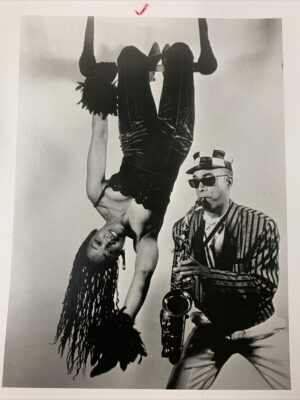 B&A: When did you get involved with Idris Ackamoor and Cultural Odyssey?
B&A: When did you get involved with Idris Ackamoor and Cultural Odyssey?
RJ: The late 1970s, early 1980s, I met Idris Ackamoor. We immediately had a connection. He liked my spunk and my drive. People had this idea that I was a man-eater. I really wasn't. I was just independent and Idris recognized this. We talked for almost a year before we got serious and sexually involved. We had already toured Europe and one day he told me to quit my day job to be artists full time.
JJ: Okay, so we're now up to 1981, 82 or so. Cultural Odyssey was the first black arts group that became a nonprofit that I'm aware of except for Wajumbe. So you two were the only nonprofits in the black community involved with Grants for the Arts except for the African American Historical Society.
RJ: The thing I really admired about Idris Ackamoor was that he just had no problem stepping up to the person we were working with and asking for the money. He'd say, “okay man, when do we get paid?” I still think he's one of the most amazing business artists that I know. He wasn't afraid of asking for what was his. He was very honorable and he would make deals. But you better come through.
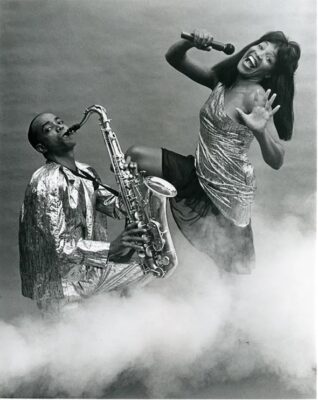 I remember being in Berlin with Cecil Brown, the writer. I was doing some nude work in Berlin and this crazy woman came to the club. She was taking us over to her house for dinner, but then she pulled out a gun. Cecil said, “Whoa, what the hell?” And she said, “Do YOU have a gun?” I think the goddamn gun went off.
I remember being in Berlin with Cecil Brown, the writer. I was doing some nude work in Berlin and this crazy woman came to the club. She was taking us over to her house for dinner, but then she pulled out a gun. Cecil said, “Whoa, what the hell?” And she said, “Do YOU have a gun?” I think the goddamn gun went off.
I'm so glad that Cecil and Idris stayed with me because she wanted me to go with her, but I don't know what that would have been like. You know, Idris is not a huge guy, but don't mess with him. He will run through you with his anger and his indignation; I’ve seen him turn into a stiletto. He's not a gangster but he can go there.
Idris and I weren’t even aware of it at first, that I was now a part of Cultural Odyssey. We were writing grants. We were going to meetings. We were going to things set up by the NEA because it was the way to the funding. You had to know how to raise money and we knew that we had the stories. We took the Legend of Lily Overstreet and created a whole score. From there, Keith Haring did the sets for it, because he was a friend of my brother Bill. We just liked to be seen. We wanted to be honored for what we did.
JJ: I remember Cultural Odyssey as the only contemporary arts group in the black community that wasn’t afraid to really be who you were, back there in the mid-1980s. You were not a historical society; you were contemporary artists. At that time the only person in the Latino community like that was René Yañez.
RJ: Yes, exactly.
JJ: So, in 1985, when I did my first report about City arts funding, I found that the black community got less than 1% of city funding, Latinos got less than 1%, and the queers got less than 1% and the Asians got almost 2%. Collectively, we got 5%. That was where things were in 1985.
RJ: Well, we're still up against the Ballet and the Opera right?. They are still getting most of the money.
JJ: If I remember correctly, you started the Medea Project around this time. Could you talk a bit about the Medea Project?
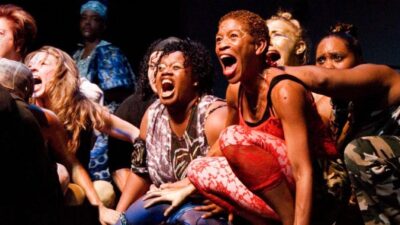 RJ: Well, The California Arts Council awarded the Sheriff’s Department a grant to hire me as a resident artist in the Women’s jail. My job was to go into the jails and teach aerobics to incarcerated women. Looking back, I realize that they just didn't know what else to do with all of these women in jail.
RJ: Well, The California Arts Council awarded the Sheriff’s Department a grant to hire me as a resident artist in the Women’s jail. My job was to go into the jails and teach aerobics to incarcerated women. Looking back, I realize that they just didn't know what else to do with all of these women in jail.
So they thought, “Well, Rhodessa Jones looks like them and she can teach them aerobics.” They were largely black women incarcerated because of crack cocaine. I started going to the Hall of Justice on Bryant Street. The women were not interested in exercising. They would look at me like, “Bitch, please.” And I would respond by doing cartwheels and handstands.
I was turning 42 or 43 years old and I started talking about my daughter who just got married. I talked about being a grandma, and these women were like, “Who the hell is this?” And then one woman asked, “Can we just talk?” And I said, “Yes. As long as we agree that everybody's story is valid. Everybody has a right to her story. And everything we say stays here.”
Then we began trading stories of how these women arrived in jail and became who they were. After a while, it wasn't just black women. It became more multicultural and diverse, a snapshot of San Francisco. The women were eager to share the circle. Michael Hennessey, the sheriff of San Francisco county became aware of what was happening with the work that I did in the jail.
My first time being in the jails, there was a young black woman who decided she was gonna challenge me. She said, “Wanna play basketball?” While I was attempting to create a space where we as a group of women would do some movement and some talking and some dancing, she wouldn't put the basketball down. She was dribbling. I thought, “this is my right of passage. If I don't make this happen, I am nothing in this place.”
The other women were like, “Why don’t you stop, Deborah?” And she's dribbling and catching the ball and finally I had these two little angels on my shoulders, a little black angel and a white angel. And the little black angel said, “You go and snatch that ball from that bitch.” And I did it! I went out and I grabbed the ball.
I said, “let me tell you something. I'm going home at noon. They pay me to be here. You're in lockdown. Who's smarter?” And she started whining about jive ass black girls from fancy schools and I said, “Call it what you want honey, they're paying me and the deputies are watching to see if I’m ok and if I can handle it.” Then I said, “Deborah, are we okay?” All of a sudden she's like, “Ummmm, we're okay.” Today, she’s still doing okay. All this got back to Sheriff Hennessey. And then I met Sean Reynolds, who became my mentor.
JJ: At this time, I was Mike Hennessey’s grant writer. I had heard about Shawn Reynolds, technically a social worker, and about you, I recall her saying to me “These women need more than aerobics!”
RJ: I had two brothers who were cops. My brother Steve in San Francisco and my brother Gus in the East Bay. They turned me on to the welfare fund that cops have for when they need a break, or when they're gonna party. I told Hennessey that I wanted to put the women prisoners on public stages.
He said, “Well, tell me how we're gonna do it.” He was kind of amused. I told him the City has these funds where we can pay the cops overtime to take the women out under guard. He was just fascinated. I had done my homework. My plan was to take the women from the jail to the theaters under guard.
I taught drama, I taught writing, I taught everything inside. I wanted the chains to be removed from them. But I made the cast—both the prisoners and the professional actresses-- enter the stage accompanied by uniformed sheriff deputies. Sheriff Hennessey showed up to every opening night with his father, sometimes with his wife. Then I knew to invite this guy up on stage. He was the man. He just loved that.
JJ: I worked in his campaign the first year I came here. So when he became sheriff, I stayed in touch with him and I also knew several of the people in the Sheriff's Department from politics. One was Connie O’ Connor and another was Louise Minick. All three of us were on the Executive Committee of the Alice B.Toklas Democratic Club. Also at this point, my grant writing partner was Ellen Gavin. I think Ellen was producing the Medea project.
RJ: Yes.
JJ: It all fit together because it was a very small community. We all knew each other then. It's bigger now. Things don’t happen the same way because there are too many people.
Beth: Oh, it's still a pretty small world, Jeff. Not as small as it used to be, but it is. The problem is there’s some infighting in the art world and the pool of money is not growing.
RJ: Ellen’s in LA now, right? She’s on the California Arts Council.
JJ: Yes, the CAC. Recently, we seem to be talking frequently. Moving on… So the Medea Project basically pre-figured reality TV. The white people in the audience were listening to Black women telling stories that were totally foreign and unimaginable to white people.
RJ: Yes, and in the beginning, I had some pretty heavy hitters. They helped me to ground the words and get women to stand up straight and tell the truth. We had a lot of fun. Shawn Reynolds came in and she told the women she was a lesbian. And the women said, “Can we say that?” and Shawn said “If you're a lesbian, then yes.”
You could see women flowering. Wow, it was a new day. They didn’t have to hide, and I was just so grateful. Amy Meuller, a friend of Ellen’s who used to be with the Playwrights Festival worked with me for a while too. We had a great time. We grew and we were able to feed each other all of these ideas through experimental theater.
I think that's what gave women, and men, the room to speak their own truths. And that's San Francisco. It was Martha Graham who said, “People from California believe anything is possible” That was a thought that I carried around inside of me for a long time; I'm from California and I can make this happen.
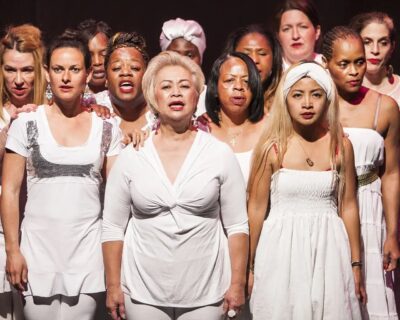 JJ: The first Medea Project production was Reality is just Outside the Window. Your solo show Big Butt Girls, Hard-headed Women was also about incarcerated women. You were doing something very different than everyone else in the theater world. Medea wasn’t just a solo performance. It was a reality-based performance featuring both professional actors and prisoners. The weird thing was that the audience couldn't always tell who was a prisoner and who was a professional actor.
JJ: The first Medea Project production was Reality is just Outside the Window. Your solo show Big Butt Girls, Hard-headed Women was also about incarcerated women. You were doing something very different than everyone else in the theater world. Medea wasn’t just a solo performance. It was a reality-based performance featuring both professional actors and prisoners. The weird thing was that the audience couldn't always tell who was a prisoner and who was a professional actor.
RJ: That was a running joke for us, trying to figure out who's the convict and who's not. All I would say to the women is that when we move on stage, we’ve got to move like an army. If people that knew some of the women from the streets got word about the show, they would come and they wanted to try to rap. That's why I always sat in the theater. I never let them just run their mouths.
Jack Carpenter, the Technical Producer everyone used at that time, said to me, “Rhodessa, you have to stay with this process because when you're upfront, they are so focused.” I'm glad that I was able to manipulate the whole thing and give the women a focus.
It was like giving them eyeballs saying, “Come on, stay with me and we can talk about anything.” I remember one piece that a girl wrote. It was all about, “Hey baby. How much to fuck?” She had been a prostitute on the streets and she wrote this great little jingle about fucking and sucking and how much it cost. She asked me, “Can we say it?” I said, “We're gonna say the whole thing.” I guess it was experimental. But it was time for more people in our community to speak their truths.
JJ: Then if we move forward to 1989, I was writing all these grants for your piece entitled, I Think It's Gonna Work Out Fine.
RJ: Oh yeah, the Ike and Tina Turner show. That was a duet with a musical score. Again, it was so original in how we did it.
JJ: Right before the show opened there was the Loma Prieta earthquake. You were staging this production at the Valencia Rose right? It really became the gay performance space. I wrote the first grants for that building also in 1983 I think. It was Tom Ammiano’s brainchild, along with Hank Wilson and Ron Lanza.
But back to the show. It sold out almost all the time. How were you thinking about that work? Did you see yourself as Tina Turner?
RJ: We just thought it would be a great piece to put on. Ed Bullins wrote it and Brian Freeman directed us. I remember Tina Turner was writing her book and all of a sudden Tina left Ike and it was big news. It was a perfect piece for Idris and me. Idris was a little nervous because people got him confused with Ike and were sometimes rude to him because he played the Ike character so well. But it was a lot of fun because it was fresh and bold. And it was fun working with Brian and Ed and having a band. It was timely. I had great legs, so I could do it.
That's one of those pieces I am so proud of having been able to pull off. We did it everywhere,—in Chicago, New York at La Mama, around Europe. We had to remind Europeans that Tina Turner was a real person, cause everybody just wanted me to sing and strut my stuff on the stage. Nobody was interested in Tina’s personal story in Europe. They were interested in her only as a performer.
JJ: Did Pam Peniston have anything to do with Medea?
RJ: Not on the first Medea. We started working together on Perfect Courage, a production that was the opening night show for Festival 2000. Pam and I are still working together on the Medea piece that we're doing in the Bayview.
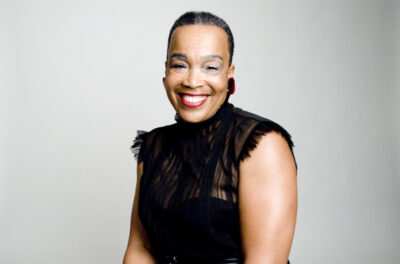 B&A: When is that piece going to be up, Rhodessa?
B&A: When is that piece going to be up, Rhodessa?
RJ: We're gonna do a workshop performance on June 14th. Then we're gonna move to Brava and continue to build on it.
JJ: Great. So let’s return to Festival 2000.
RJ: Yeah, Perfect Courage opened the Festival. We didn't know all the behind-the-scenes stuff that was going on about lack of money. But I think we got paid. There were people that didn't get paid. It was a great idea but it fell through the cracks.
Whatever happened to Lenny Sloan? They brought him in as the Director of Festival 2000, right? I think he moved to New Orleans. I was so proud to be a part of the planning committee for Festival 2000. But then to find out that behind the scenes, there was no money? That was drama. But I still had a lot of fun.
I just had dinner with Brian Freeman 2 or 3 weeks ago: he did Perfect Courage with us. I often tell him that Coleman Domingo is getting all this coverage for Bayard Ruskin but Brian Freeman is the person that introduced the community to who Ruskin was.
JJ: So, going back into the history, it was Festival 2000 that got us the cultural equity grants program. That's where it came from.
RJ: You know more about the backstory than me because you and Idris talked a lot about that. But I'm glad we did it. Cultural Equity is not a bad thing. We deserve it, damn it.
JJ: Yeah, when I look back on Festival 2000, I thought it was great that Grants For the Arts had thousands of dollars that they could spend on anything. They spent $35,000 to put a car in that little outside space between the Opera House and the veterans building because some car company was sponsoring some opera production. I think Grants For the Arts spent $35,000 on that. But when it came time to bail out the people who got screwed at Festival 2000, suddenly there was no money. Money for the opera or ballet, but not for anyone else. Even though it took us two years, Festival 2000 launched the Task Force that resulted in the Cultural Equity Grants program.
RJ: Wow, Jeff, I have to give you your props. You were wheeling and dealing, baby, and a lot of people didn't like seeing you coming because you were gonna let them have it. That was one of the things the artists talked about; That you were a bit more than just a grant writer. You had your flag and your bully club and all that other stuff too. I applaud you for that. I really do. I love the history of how you did it. You're making me remember things that I'd for sure forgotten.
JJ: And you’re still out there. Lily Overstreet showed again 20 years after the first one.
B&A: Oh, yeah. At Fort Mason, right?
RJ: Yes, and it was outrageous. Yeah, Lily had turned 50. It was Lily's 50th birthday party.
B&A: When's Lily turning 75? You could have another party.
RJ: Well, I'm 75 now, so let me give it some thought.
JJ:. I'm gonna be 80 soon and, I hope, I’m every bit as obnoxious as I used to be.
RJ: Yeah, you really are the classic old pain in the ass and that's what we need.
B&A: So, after that, you continued doing the Medea Project, right?
RJ: Yeah, well, all these women would not let it die. I got invited all over the world; Egypt, South Africa, the Caribbean. We were down south. We were in New York. We were everywhere. When I was in South Africa, I actually built a whole company of African women in jail. The Medea Project was very malleable, and just right on time as a piece of artwork.
B&A: So how did you become a resident artist at Yale and Dartmouth and all these other places?
RJ: Well, I was one of the early people doing art as social change. Also, I was from California, where there was this idea that you could really create artwork rooted in politics. I think that's what it was. I had a great time at Yale. They didn't know what to do with me because I didn't have a ton of letters after my name. But the students loved me. I got them to write. How do I do what I do?
I have a chair right now at Cornell. I'm able to bring members of the Medea Project to teach; Angela Wilson and Felicia Scads, the ex-offenders. They teach the project now and I just sit and witness it. But to answer your question, I think that I helped give birth to the idea of artists creating social change. So when I go to colleges and universities there are all these students who are interested in talking about that and being a part of it.
B&A: So you’ve had a good experience working with universities?
RJ: I've worked at Yale and Cornell. I was fascinated that they wanted me to come and talk about my work and my life. People are telling me now, “You ought to go back to the university.” I go back when they invite me and they pay me well. I’ll do a residency and spend a week working with the students. For my next residency at New York’s Hamilton College, the students will develop a performance piece about gun violence.
B&A: Now at New York University there is a program where you can get a Masters in Theater & Social Change. That's clearly something that came from your work.
RJ: Yes. Was it at the University of Michigan or Pittsburgh that had prisons attached to the campuses? Cornell has a prison project. You can go into the prisons while you're there and that's been a pretty amazing thing to be a part of too. But it's still largely men, not women.
Beth: Rhodessa, we’ve gotta get you down to UC Santa Cruz where there is an Institute for Arts and Sciences. It’s all prison abolitionist programming. Plus I started a program in the Art Department called the Environmental Art and Social Practice Program.
RJ: Oh, that'd be great. Maybe I can bring my crew and we can work with the students to make a performance. I’d really like to make that happen.
B&A: That'd be beautiful. I’m curious to know, back in the day, what theaters and what kinds of spaces did you feel most comfortable working in? What artists were you going to see?
RJ: Well, you know, in my early youth, my sisters and I were girly girls, very influenced by Motown. We used to sneak in and perform at this bowling alley in Rochester NY because we weren’t old enough to be in a bar. My mother had been a singer in a gospel group, so singing and dancing were the early things in my life. Every holiday, Christmas, Easter, Thanksgiving, you were expected to put on a show. That's how I cut my teeth.
Then, of course, after I moved to San Francisco, I was raising my kid in Potrero Hill and took performing for granted. Then Teresa Dickinson, the founder of Tumbleweed, asked me if I could come and dance with the company. All of a sudden I was back into modern dance and contact improvisation with these women. So that's where I met Mangrove and John La Fan and Robert Henry Johnson.
Yes, these were the people that I was interacting with all the time, and my brother Bill, and his partner Arnie Zane. I was going to New York and seeing them and going to La Mama. That was just some crazy stuff going down. But I liked it.
B&A: You told the funniest damn story about Bonnie Ora Sherk when you went to New York in your bus.
RJ: Oh, Bonnie. What a trip the Farm was, huh? The Farm was part of shaping my consciousness because it was a performance space and a farm located at Potrero and 26th street in the Mission.
So back to your question about what shaped me. There were all these ideas coming down about what theater could be and what you could manifest through stage work. And I had a children's company. We did political theater. I worked with the Mime Troupe too for a while. I did love that.
B&A: Did you ever perform at Glide Church in the Tenderloin?
RJ: The Medea Project and I have performed at Glide Church; we created a piece based on bits and pieces of classical literature. I used to love Janice Mirikitani. Janice was really kind to me and a great poet. She would ask me to come to her poetry reading and I'd go. I got my PhD at the edge of the world. I was looking at everything.
B&A: What venues did you go to here in San Francisco in the 70s and 80s. What was your home theater?
RJ: I remember performing at The Art Institute in San Francisco, we were invited there often. The Eureka Theater was another venue that I worked at a lot. Like I said, I was a hippie chick before I was a performance artist. So I loved working at outdoor venues. When I was working with my brother Bill T Jones and Arnie Zane, I remember Peter Coyote asked us, “What's the Jones company? A band of junkies?” And we said, “Oh no, we're family.” I learned early that the stage was this incredible space to share energy from, or to protest. But theater kind of found me. I didn’t go around looking for it.
JJ: The Eureka Theater where you performed Lily Overstreet had as its Artistic Director --Tony Taccone; Later, he commissioned Tony Kushner to write Angels in America and the Eureka premiered it in San Francisco.
RJ: I auditioned for late night with Julie Hebert. She really liked me. Julie was really the key to me being there at all.
B&A: You also performed at Brava Theatre. Now you're at the Bayview Opera House.
RJ: Yes I am at the Bayview Opera House right now, it's great to be back and funded by Black on Both Sides for Life on the Swerve. But Brava has been the Medea Project’s home in San Francisco for a long time.
JJ: In addition to your long history of creating new, innovative and experimental work, Cultural Odyssey worked so well that you both have a retirement package, and that’s rare for a small-to-midsize non-profit arts company.
RJ: Yeah, we do. I've already bought a house in Houston, Texas. It’s a 5-bedroom house with a swimming pool. It was only $400,000. My granddaughter, my daughter, and my great grandson are living there now. I like that area. But nothing compares to the Bay Area in a lot of ways.
B&A: What do you see yourself doing in the future? Do you think you're ever going to retire?
RJ: Well, I always say that I am, but I am actually working on a book. The book is titled, Nudging the Memories. It’s a handbook about how I make theater with “other” populations and I'm only halfway through but it's becoming a collection of my own stories as well as the stories of the women that I work with. My sister and I are also working on something entitled Just Outside of Babylon. It's about living in America, coming out of a migrant family. So I have those two projects happening.
I might go back and make my own documentary of the Medea Project, just to see the people in the group that have grown immensely like Angela Wilson. She runs the women's unit with the sheriff’s department and I met her in jail. She was a addict and now she runs this program and she's getting her degree at SF State.
B&A: How many brothers and sisters did you have?
RJ: 12 brothers and sisters.
B&A: Wow. So, our last question is, as you reflect on your contributions and challenges, what advice or insights would you offer to emerging BIPOC and/or LGBTQ artists who are beginning to navigate their artistic journeys?
RJ: To the people dreaming or being hesitant, I would say, “take some deep breaths, and follow your own heart.” Because that's a hard one. People say, “oh my God, be careful.” But this is all we got. I have grown into my heart, and I trust her. I trust her more than anyone. Yeah, you're gonna get knocked down a few times. That's gonna happen. But trust your own instincts. Trust your heart. There are people who need to hear your stories. Practice revolution.
And don't be afraid to write it down. Lily Overstreet really grew out of the fact that I took a little journal to work with me when I worked at the Tenderloin peep-shows. I'd never done that before. So much was going on. Later I'd go back to this journal and I'd have a lot of things that made sense and a lot that didn’t make any sense at all. But I chronicled my own experience and I think that's a very good tool to be able to hone in and call your own.
Annie: As I'm approaching 70, I'm thinking about the mistakes I made. They always say, “oh, don't be afraid to make mistakes.” But then you’re 70 and you go, “fuck, I made a lot of fucking mistakes.” Do you feel that way?
RJ: Yeah. You look back and you go, “Wow, what was I thinking?” I wish that I had been more careful with my kid who’s a tad wounded by things that I said or did or by the people I exposed her to.
I always tell people I pulled this life out of my ass. There was no school to attend to be an exemplary new dancer. You have to trust in creative survival. Everything that you're handed is a jewel of some sort. Trust it. I am a creative survivalist. I've taken what the world gave me and I've made it work for me.
I think I surprised my daughter, because I have no problem saying, “I hope you can forgive me.” I think she looks at me sometimes and thinks, “You're my mom. What does that mean?” My daughter is so much like my mother. She carries a big stick. My mother would say, “I'm not your friend, I'm your mother.” Okay, but do you have to roar so loud? All in all theater saved my life. If not for theater I’d be a bitch with a very bad attitude, or dead.
B&A: Thank you so much Rhodessa. Thank you for your life’s work, from the peep-show to the theater, to the prison work, to the teaching and to the work you’re doing now.
RJ: Thank you so much. I enjoyed this. It was a walk down memory lane. Thank you, Jeff. It was really interesting. Alrighty. I'll talk to you later. Bye-bye.
Susan Stryker
Susan Stryker
In demand as a public intellectual, Susan Stryker’s historical research, theoretical writings, media-making, activism, and academic field-building activities have helped shape the conversation on trans issues and history since the early 1990s.
Living in in San Francisco Stryker retired in 2020 from the University of Arizona as Professor of Gender and Women's Studies. Since then she has held the Distinguished Visiting Adjunct Professor appointment at Stanford University's Michelle Clayman Institute for Gender Research. She is also Director of the TEN:TACLES Initiative (Transgender Educational Network: Theory in Action for Creativity, Liberation, Empowerment and Service), funded through a $1.5 million grant from the Mellon Foundation's Higher Learning Program. This program brings trans-oriented humanities and cultural studies scholarship to bear on practices of social transformation. Stryker has authored several books on queer and trans history and culture, including Gay by the Bay: a History of Queer Culture in the San Francisco Bay Area and Transgender History: The Roots of Today's Revolution.
Beth Stephens & Annie Sprinkle: Welcome. Welcome. Welcome.
Susan Stryker: Thank you. Thank you. Thank you. Good to be here.
Jeff Jones: Hi Susan. Let's start with your life before you moved to San Francisco.
SS: I did not grow up in a family that prioritized engaging with art. Most of my access was books, film, television and music, things that I found through mass culture growing up mostly in southwest Oklahoma. The things that spoke to me then about gender were Bugs Bunny cartoons, seeing the Warhol superstars on late night TV talk shows, Lou Reed in his Walk on the Wild Side phase. Then it was Bowie on the Midnight Special doing the Ziggy Stardust character. And then Prince. Those were the things available to me that allowed me to see some representation of trans-ish-ness being connected to some positive sense of culture, something cool.
JJ: Where did you grow up in Oklahoma?
SS: Lawton. My dad was in the Army, field artillery. We were stationed half the time at nearby Fort Sill, the field artillery training center, and half the time on other Army bases in Texas, Hawaii, Germany. I was in Oklahoma during high school, and got a great scholarship to the University of Oklahoma, so I went there for my undergrad.
B&A: Where in Germany were you?
SS: We lived in Dachau, on the grounds of the former concentration camp. When the Allies liberated the camp, they turned much of it into a US Army base, from 1945 to 1971. Then it became housing for Olympic athletes during the 1972 Munich Olympics, and then the training academy of the Bavarian State Police. When I go back to Germany nowadays, it’s mostly to Berlin.
B&A: So do you speak German?
SS: I used to, but now it's really rusty. Besides living there, I've had ten years of formal classroom-based instruction in German from grade school through college. But since I don't use it, I kind of forget it.
JJ: When did you move to San Francisco?
SS: I was accepted into UC-Berkeley’s Ph.D. program in United States History in 1983. I was spending a lot of time in San Francisco by the mid-1980s, and working here by the early 1990s. I finally moved into the City proper in 2002.
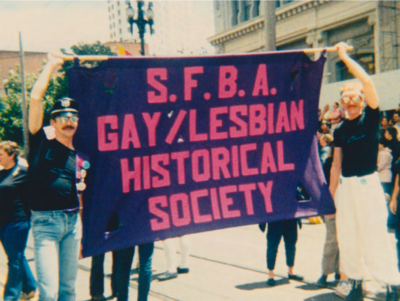 JJ: What year did you become the director of the GLBT Historical Society?
JJ: What year did you become the director of the GLBT Historical Society?
B&A: AKA the “Queer Smithsonian.” Formerly the Gay and Lesbian Historical Society of Northern California. Which now also has a museum, which is very cool.
SS: In January 1999. I served until November 2003, one month shy of five years. But I started volunteering at the organization in 1991; I joined the Board in ‘92. Then I became the first paid Executive Director in ‘99.
JJ: Allan Bérubé was one of the founders of the GLBT Historical Society. He subsequently won a MacArthur “Genius” Fellowship for publishing Coming Out Under Fire, a history exploring why San Francisco became the center of LGBTQ rights during the 1970s. Bérubé said it was because of the number of dishonorably discharged military personnel who were released here following the conclusion of World War II. Many of them chose to stay in San Francisco rather than returning to their home towns. Was Allan on the Board when you joined the Historical Society, or after?
SS: I knew Allan from late 1980s forward, through my grad school friend Sharon Ullman, also one of the founders of the GLBT Historical Society. He wasn’t on the Board when I was on the Board, but he rented a room in the archive to store his WWII project papers, and he was around all the time. Allan was a really important role model for me. We’d go out for burritos. He really took the time to teach me how to be an independent, community-based queer scholar. He moved to New York in the mid-1990s and had a place in Liberty, upstate New York, in the Catskills. He died in 2007, well after my time as director.
JJ: I haven't really been able to put together in one place all the information I have accumulated over the years about the transgender arts community. So I'd like to know how you remember some of the things that I remember. The first time I remember encountering a trans artist, they were somebody who was starting Tranny Fest.
SS: Shawna Virago and Christopher Lee started that.
JJ: I know Shawna’s still around. Whatever happened to Christopher?
SS: He chose his own exit time in 2012.
Annie: My film, Linda/Les & Annie–the first F2M Love Story, screened in that first Trans Film Fest. Or maybe it was the second one. Alex Austin co-founded it in 1997 with Christopher Lee. In 2003 Shawna Virago became Artistic Director.
SS: I remember that a little differently. I guess we could go to the archive and figure it out. Definitely 1997. Definitely Christopher Lee. Alex definitely had their finger in lots of pies. I remember Alex helping Tranny Fest in many ways, like, drafting their articles of incorporation. But I think Shawna was involved from the get-go. Maybe not with a title, but certainly involved.
B&A: The Trans Film Fest was every other year at the start, then due to popular demand, it became annual.
SS: There was also a London International Transgender Film Festival, which I know was in 1997, because I was there—it was the first time I’d left the country since my gender-transition, and I had to get a new passport. There was also a trans film festival in Montreal that year, Counting Past Two.
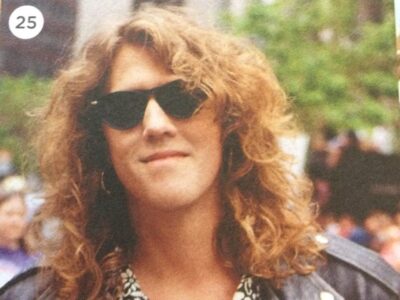 B&A: According to Wikipedia, Tranny Fest became the San Francisco Transgender Film Festival, and it was the world’s first trans Film Festival. And we were there! Memories are full.
B&A: According to Wikipedia, Tranny Fest became the San Francisco Transgender Film Festival, and it was the world’s first trans Film Festival. And we were there! Memories are full.
SS: I really think there were three “first” trans film festivals—SF, London, Montreal—but I’d be happy to stand corrected! Eventually the London Festival moved to Amsterdam, and morphed into the Trans Screen Festival.
JJ: Around the time, I first ran into Shawna Virago, who was the Grand Marshal of the 2001 S.F. Pride Parade. Why do you think that happened?
SS: First, it was about damn time for some trans representation there. But also, because Shawna and Chris were very proactive and campaigned hard to become the Parade’s co-Grand Marshals. At all the events they attended, they promoted themselves and recruited supporters to vote for them. They were just activating their networks, passing out fliers, and talking themselves up to queer community organizations. It was a full-court press.
My own involvement in the queer community started in the leather community. I was publicly transitioning and coming out around 1990, ‘91, ‘92, in the period right around Queer Nation. I’d been part of the leather scene, on the down low, since ’88 or ’89. When I was coming out, the T had not yet been added as a separate initial to LGB, but that was starting to change.
My own take on that moment was that LGBT was the neo-liberal accommodation of queerness: just adding more letters to the alphabet soup, not destabilizing the categories through which heteronormativity reproduced itself. In the early 1990s, none of the larger LGB organizations really acknowledged trans people. By 1995, several of the larger organizations were starting to change their names to LGBT. That was the year the Pride Parade became the LGBT Pride Parade
But the trans community still felt very marginalized within the LGBT non-profit cultural sector. There were not a lot of T-inclusive institutions until the later 1990s. Then the change was pretty rapid. Not only was I Executive Director of the Historical Society, but Prado Gomez became the Executive Director at Proyecto Contra SIDA por Vida, the HIV prevention agency in the Mission. He had come up through Brava for Women in the Arts, where my partner Mimi worked, and was a protégé of Cherrie Moraga and Ellen Gavin.
There was money from the Horizons Foundation around that time to pay for Executive Director support and professional development and life coaching, for leaders in the LGBT non-profit sector. I remember meeting other trans people who were involved in nonprofit work through my involvement there. I feel like that's when I was first starting to get plugged into some of the work that you were doing, Jeff, with grant writing for the arts. That’s when you came onto my radar screen.
The other people who I thought were super central to trans arts and cultural production stuff in the ‘90s were Jordy Jones, who soon joined the QCC Board, and Stafford. I know the three of you know both of them. The club that they used to host, Club Confidential, was a major event that brought in all kinds of performers. It was the place to see and be seen in Trans SanFrisco back in the 1990s. Monika Treut profiled the club in her film Gendernauts, about the trans community in San Francisco. Then she did the follow-up film Genderation, that Annie and Beth were involved in. Gendernauts came out in 1999, Genderation in 2021. Sandy Stone was featured in both, as was I.
Annie: For Gendernauts Monica filmed me on my Sausalito houseboat. I wasn’t a trans person but had trans lovers. It was a wonderful film that really captures the late 90s in San Francisco.
Beth: Genderation is a really great film too. It revisits the main subjects of Gendernauts and where they are now. It addresses aging in the trans community.
SS: So yes, the late 90s was the moment when I think trans moved a little bit to the foreground in the nonprofit arts community.
JJ: As an aside, let me mention how the “B” entered LGBT. In 1984, I was the co-chair of the Mobilization Against AIDS with Bisexual activist Maggie Rubinstein. It was during the early years of AIDS when there were no tests for HIV. Maggie kept insisting that bisexuals had to be thought of as part of the Queer community because bisexuals were the channel through which AIDS was being transferred into the straight community.
Annie: I remember there was a lot of resistance to adding the B back then.
JJ: So finally, everyone just said, okay, now we'll be the LGB community. That was 1985 because that’s when my partner died of AIDS. Soon afterwards I decided that after four years of AIDS work, I had paid my dues and I could return to the arts world. It was pure denial, but it worked. But I could not recall when LGB changed to LGBT.
SS: The Pride Parade added the T in 1995.
JJ: I originally thought you had said something about Q being the umbrella that everybody could fit under. But a lot of people did not agree with that.
SS: Right. Which is why I think it became LGBT.
JJ: The first time I had to get up in front of a public audience and say “I’m here representing the lesbian, gay, bisexual and transgender community” I knew I would never do that again. It felt linguistically terrible; it only sowed confusion and led to the proliferation of LGBTIAQQ+ and it didn't say anything.
SS: The word salad has no nutritional value.
JJ: That's it. It just did not register. I didn’t know how we would pass that on, but we did: to queer.
SS: Honestly, I think it went the other way. The lesbian and gay establishment was, as we would say today, very cis-normative and gender binary. First it was a purportedly all-inclusive “gay,” then lesbians got almost-equal billing, then occasionally there was an awkward, in parentheses, “B”. Trans was just not on anybody's radar screen at the time when those moves were being made.
There has always been a trans intersection with gay life broadly defined—thinking of homosexuality as a gender “inversion,” butch and femme, drag performance. But trans life began intersecting with gay and lesbian community politics in San Francisco in new ways around the time of Queer Nation and ACT UP. To combat AIDS you needed to get past the sexual identity politics that tried to cast it as “gay cancer.” You needed to talk about risk factors and transmission vectors and vulnerable communities such as those once labeled the “4-H”’s: hemophiliacs, Haitians, hookers and hard drug users.
That was the context in which the old epithet “queer” took on new meaning, naming the unlikely coalition of affected constituencies in the AIDS crisis, and pushing back on sexual identity labels as being the most salient thing. “Queer” kind of meant “everybody affected by AIDS who's pissed off at the government.”
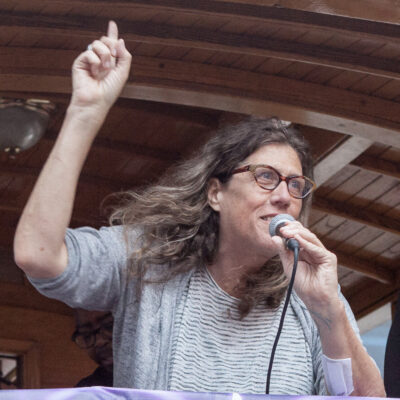 The wave of trans activism that started in the ‘90s in San Francisco, and later fueled a wave of cultural production, came out of that sensibility. It was a way of meeting the moment with regard to the impact of AIDS—trans women of color engaged in survival sex work had the highest infection rates of any demographic—as well as contesting the historic relationship between trans life and an often transphobic cis-gay and cis-lesbian community.
The wave of trans activism that started in the ‘90s in San Francisco, and later fueled a wave of cultural production, came out of that sensibility. It was a way of meeting the moment with regard to the impact of AIDS—trans women of color engaged in survival sex work had the highest infection rates of any demographic—as well as contesting the historic relationship between trans life and an often transphobic cis-gay and cis-lesbian community.
When I was involved with Transgender Nation, which began as a Queer Nation affinity group, I remember making the rounds of public forums and membership meetings at the existing gay and lesbian and AIDS groups, and calling the question: are you queer, meaning broadly anti-homonormative, or are you a special interest group for people who share your identity? Are you in favor of the coalition of all the perverts who are marginalized by the current organization of power, or are you in it to win it only for people like yourself? That’s what was at stake in the question of trans inclusion in the early ‘90s.
Ultimately, a trans demand for a queer coalitional politics was watered down into a tepid tacking-on of a T to LGB, and a half-assed version of inclusion. It was like you could drop the T any time if you had trouble pronouncing it.
B&A: Wasn’t Kate Bornstein performing around San Francisco earlier?
SS: Yeah. She was slightly ahead of the curve. She’d been in Philly, I think, and came out to SF right on the cusp of things starting to get interesting here for trans. Did you ever meet Kate?
JJ: I didn’t, no. Adele Prandini, who was the Director of Theater Rhino often mentioned Kate to me, but I only met her after she had moved to New York when she performed in the National Queer Arts Festival around the Millennium.
SS: Kate was really important to me. Still is. I first came across her in Lily Burana's ‘zine, Taste of Latex, which had a feature on Kate when she was performing at Theatre Rhino. She was doing Hidden: A Gender, her first big play. It was just before I publicly transitioned, and I was like, huh, I guess it really is possible to be a trans lesbian—cool! So I immediately went to the show—which was also the first place I ever saw Vivian Justin Bond perform—and hit Kate up afterwards for a coffee date. It was when she was working on her book, Gender Outlaw.
She was a really important figure around town at the time. I also saw her perform at Josie's Juice Joint. I think Adele Prandini was Kate’s dramaturg.
JJ: The first really aggressive trans artist I met was Sean Dorsey. In 1996, Krissy Keefer and Ann Bluethenthal organized the Lesbian/Gay Dance Festival. When they stopped doing it after 5 years, Sean Dorsey told me he was going to start something in the dance world called Fresh Meat. At that point, QCC gave away about five $1000 commissions to artists per year, and we gave one to Sean. His first event was amazing: it was sold out and you couldn't get in. More than half the people on that program were not trans, but they were people of color.
Another one of the people from that time that I always remember was Lynn Breedlove.
SS: Yeah, I know Lynnee. We used their all-dyke-and-trans bike messenger service Lickity Split when I was ED at the Historical Society, and I later served on the board of Lynnee’s community ride-share non-profit, Homobiles. Their band Tribe 8 was awesome.
JJ: I never actually went to a Tribe 8 performance, but I heard about these events all the time.
SS: So, I remember I met Sean Dorsey in the very early days, maybe even before Fresh Meat. I think I first saw Sean as a guest performer at an academic conference. We wound up hanging out when I found out he was in San Francisco and was in an on-again off-again relationship at that time with Shawna Virago. I mentioned that just because I had already known Shawna for years, even before Sean came down from Vancouver. It was like, “Oh! You two are together. Cool! Oh, you're not together. Too bad. Oh, you're back together!” That at least was my memory of them back in the day. They were both very influential figures in the trans culture scene.
When Fresh Meat started, it was this really innovative, trans-centered, but not trans-exclusive performance series. I remember Storm Flores being connected with that early on. I thought the work I saw there was indeed really fresh. I also loved Lou, the work Sean developed based on the diaries of the pioneering gay transguy activist Lou Sullivan, performed by the Sean Dorsey Dance company. It was just brilliant.
I remember seeing Shawna Virago at LunaSea and elsewhere. Shawna was part of the fabric of trans life in San Francisco in the early, early nineties, well before Sean Dorsey arrived. At one point she was working at Community United Against Violence, and I was working at the GLBT Historical Society, which was in the same building at 973 Market Street, and we’d run into each other in the elevator all the time.
Now, Lynnee Breedlove, I remember hanging out back in the day at Red Dora’s Bearded Lady Truckstop Café on 14th Street in the Mission. Several Tribe 8 members had their day jobs at Red Dora's. I don't know if Lynnee actually worked there. But I know that Harry Dodge did. And I think Flipper. Red Dora’s was a dyke-centric genderqueer community and performance space that was a super important cross-over point between different scenes. The lesbian cartoonist Kris Kovick curated a performance series there. I co-curated my first art exhibition there, and did spoken word there a time or two. It was where Tribe 8 kind of held court. I would see Lynnee there all the time.
Annie: Oh! I always knew that place as just the Bearded Lady Café; it had a great little art show of drawings by Harry Dodge, who had drawn a series of anuses. I bought an anus. It was only $25 per anus.
SS: Tribe 8 was a lesbian punk band, but they had their alter ego side-project: Harry Dodge and the Dodge Brothers. It was all the same people, doing their drag king personae and performing country and western music instead of punk. They played regularly at Jordy Jones and Stafford’s Club Confidential, which those guys hosted once a month in a hotel on the fringes of the Tenderloin that had a totally sleazy dive bar on the ground floor. Trans folk would take it over and make it fabulous. It had a little stage where the Dodge Brothers would perform. I saw Veronica Klaus perform there, too.
Veronica was another big part of trans arts and performance culture in the ‘90s. When Jim Van Buskirk and I wrote Gay by the Bay: A History of Queer Culture in the San Francisco Bay Area, we hired Veronica to be the performer at the book launch party at the new Main Library in San Francisco. Jim was the Director of the Library’s James Hormel Center. The book launch party for Gay by the Bay was one of the first things that happened in that building once it opened; Veronica was there with a full band and just raised the roof.
JJ: So I remember that when Sean Dorsey arrived on the scene, right after that Michelle Tea started to appear in my life nonstop. Every place I went, Michelle Tea seemed to be there.
SS: Yeah, my first connection with Michelle goes back to Gay by the Bay, too. Jim and I had just published the book, and publicity was starting to roll out. It got a feature story on the cover of The Bay Times—Stafford and Jordy’s Service Station graphic design business did all their covers—and the story itself was written by this young dyke named Michelle Tea, newly arrived in San Francisco who was trying to figure out how to make a living as a writer and culture-worker. She became so central to so many things, and was super important to Sister Spit and Radar Productions, which put on the Queer Writers’ Series at the Main Library.
JJ: Don’t forget to add Transforming Community and Drag Queen Story Hour. So for 11 years Michelle Tea and her non-profit Radar Productions presented Queer Writers the library. There was a piece that QCC commissioned for the National Queer Arts Festival in 2005 called Transforming Community: Michelle Tea organized six trans writers to author and present a ten-minute piece. She had poets, she had Shawna Virago giving us a lecture, Rocco, Max Wolf Valerio, Julia Serano, Lynnee Breedlove and Marcus Renee Van, a Black F-to-M who went to Taiwan and was teaching English there. I remember going on the show’s opening night and it was just mind blowing. There were people in the audience who just screamed during the whole show. This free performance ran for 4 nights in June and was packed every evening.
This production presented 7 different views of what trans was about. That was the genius of Michelle Tea. She figured out how to present six different perspectives by Trans artists about various Trans topics and then it was her turn: she wrote about how Rocco’s transition impacted her. They were partners at the time. Going out in public with Rocco, who was now a man, Michelle noticed that her friends started treating her like someone in a straight relationship who was no longer a lesbian.
But going back just a little before that, do you remember the year when the Dyke March decided that they were not going to allow anyone except ‘real’ women to march in the parade?
SS: The way I remember it was you had to be a lesbian to march in the parade, and they were not exclusive of trans women who were lesbians. But they were saying, if you're one of our trans brothers, even if you've had connections to this community, we ask that you stand on the sidewalks and cheer us on. It wasn't that they were transphobic to trans women. They were saying it's a dyke march, so if you're not a dyke, then don't march. I marched in the very first one.
There was a complicated relationship between the Dyke March and the emergence of the Trans March, some controversy about porous and overlapping community boundaries, how you define who’s a what and who gets to decide. I don’t know all the details because I wasn’t centrally involved. But I did march in that first Trans March, too, and often spoke at the rallies in Dolores Park before the marches.
JJ: I was the grant writer for the Dyke March when those controversies were taking place. I remember the first Trans March and how nobody offered them any help. Word of mouth produced about 2000 people. That was really the first time that Trans visibility was heightened on Pride weekend: it was not a million people but it was not small either.
Here’s how I remember it: The Trans March emerged right after the controversy with the Dyke March. And after endless community discussions, and after the second Trans March, the Dyke March changed its position. Both events were held in Dolores Park on back-to-back Friday and Saturday: both needed a stage, security, sound systems, emergency medical services and insurance. Somehow, after the initial conflict they started working together. Before the third Trans March the two Marches figured out how to share their production costs. Since I worked for both Parades, I really didn't have an opinion; all I could do was point out how the money could be raised and spent, and how the two parades might consider sharing costs.
I remember the first time Fresh Meat got funded. It was at a community meeting and I noticed Kary Shulman was there. So I got up and gave a speech about how Grants for the Arts absolutely discriminated against lesbians. Someone in the audience said “What about trans artists?” I replied “none are funded.” I believe Sean Dorsey stood up and said “how can trans people get GFTA funds?” Kary said, send me a proposal; by next morning, one was delivered to her office.
At that time, I often wondered if anyone actually read the proposals I annually wrote to Grants for the Arts. The only person whose opinion mattered was the agency’s Director Kary Schulman. She alone would decide how much money you were getting, or if you were getting anything at all. She always gave the Dyke March the smallest grant her agency made and she never increased it. So when Schulman was publicly maneuvered into a position where she really couldn’t answer why her agency awarded no grants to the Trans community, I felt that getting her to fund trans artists was a major achievement. That was in 2005 or 2006.
All of these things were connected. I remember that at the time of the 2002 Dyke March, Michelle Tea wrote a really snarky article in the Bay Guardian titled “What is a Woman?” She asked who was going to inspect the genitalia of the marchers and what evidence would be acceptable since neither birth certificates nor driver's licenses could irrefutably answer the question.
Then Fresh Meat began and Sean became so central to moving the agenda forward. That process continues today. Sean just got some $100,000 grant from the New England Federation of the Arts to tour New England and the United States.
SS: This conversation has started things percolating in my memory. I’m remembering other trans art stuff back in the 1990s. One of the other major venues besides Red Dora’s was 848 Community Space. Loren Cameron, a really important trans photographer, had an exhibit there called “Our Vision, Our Voices.” So many people showed up for the opening that the venue said, “Could some of y'all please come back for a second showing, because we're at capacity, and the fire marshals are going to shut us down.” That was, to me, one of the major breakthrough moments in the public recognition of trans artists in San Francisco. I was on the discussion panel. It was me, Loren, Kate Bornstein, trans writer Jamison Green, and maybe Stephan Thorne who was a trans guy in the SFPD, maybe the poet Max Valerio, I can't quite remember.
Another place that was really important was The Lab. They held these conferences for a few years called The Illustrated Woman: Feminist Activism and the Arts. I'm not sure how many there were, at least three, but maybe more. When I started getting involved in the art scene here in SF it was really through the Illustrated Woman. I think it was the second conference in 1994, which was held at Yerba Buena.
I am not trained as an artist. I'm a historian by training. But because I was transitioning, there was no way in hell at that time I was going to get a job as a professor teaching U.S. history even though I had a Ph.D. from Berkeley. That was just a non-starter. I was trying to figure out what I was going to do, and how to make a living by any means necessary. I didn't have to worry about what I was going to do to make tenure. I could do whatever I wanted, because, like Janis sang, “freedom’s just another word for nothing left to lose.” I could write tranny porn, I could do performance art, I could be a rabble-rouser, and it wasn’t going to cost me anything extra.
I had a sense early in my life that I wanted to go into a creative field. Fiction. Film. But I played it safe. I’m from a working-class background and financial stability and upward mobility appealed to me. I do honestly love history, and thought becoming a history professor would offer me a nice secure middle-class life. When I was in college, I believed that if I could get into one of the top five history PhD programs, I'd have a good chance of getting a professor job in history. If I didn’t, I was just going to be a bartender and work on my novel or my screenplay. But I got into the top-ranked program at UC-Berkeley.
I was transitioning right as I was finishing up my doctorate, and since that meant I didn’t have a snowball's chance in hell of getting an academic job, I just threw caution to the winds.
I still did scholarship on the side—who knew it would eventually turn into my paycheck job!—but I also started doing spoken word stuff in club settings. I started curating a little bit. I started writing and publishing fiction, doing journalism.
I was running the speakers’ series for the GLBT Historical Society; I put together a program at Modern Times Bookstore when The Crying Game came out, that had an actor who played cross-gender roles, the president of Frameline’s Board, a Berkeley professor who specialized in Irish postcolonial studies, and me, presenting all these different angles on the film. An artist named Paula Levine was in the audience, and she recommended me to her friend Barbara DeGenevieve, a really influential photographer and mixed media artist then at San Jose State. Barbara was curating a panel called “Bad Girls” at The Lab’s Illustrated Woman conference. She invited me to present a Trans version of what it meant to be a bad girl. I became super close with Barbara, who was an amazing mentor and friend, and who supported a lot of trans artists. She eventually relocated to the School of the Art Institute at Chicago, where she worked until ovarian cancer took her out of this life.
I wrote a well-received piece called “The Surgeon Haunts My Dreams” to present at the Illustrated Woman conference. That put me on the map locally as somebody who could make art as well as do activism. The San Francisco art press was comparing me to the French feminist performance artist Orlan, which I admit I found quite flattering. I was starting to feel like I maybe could actually have a life as a trans creative instead of being a tweed jacket wearing, elbow patched, pipe smoking historian dude after all!
At that same conference I hooked up with the artist Kathy High, who hooked me up with the artist Shu Lea Cheang, who had just been commissioned by the Guggenheim to create its first-ever born-digital commission, called Brandon, about the Brandon Teena murder. Working on that with Shu Lea put me on the arts map in a totally different way. In hindsight, I’d have to say that the 1994 Illustrated Woman conference at The Lab was what launched whatever “arts career” I’ve managed to have.
B&A: We just hung out with Shu Lea in Austria. Such a great artist. Didn’t know she did stuff in San Francisco.
SS: Shu Lea is a global nomad who works everywhere and is very collaborative. She passed through San Francisco regularly. Jordy Jones did a lot of the graphic design on the parts of Brandon that I scripted. I worked with Shu Lea on Brandon-related projects in London and Amsterdam as well as San Francisco.
JJ: Who was running The Lab back then? Do you remember?
SS: The person that I worked with the most was Zoë Kroll. She was not the Director but she was the one I had the most interactions with at the Illustrated Woman conferences.
AB: Laura Brun was the director for quite a long time, I think. Then Elizabeth Beard became the director.
SS: Yes! Laura Brun.
JJ:. So what do you think about what's happened in the trans arts community here in San Francisco since like maybe 2008 or so?
SS: I don't know if I'm the right person to ask about that because around 2007, 2008 I started working out of town more. My academic career picked up—trans studies was becoming a thing, and I had achieved some profile based on some of my side-hustle scholarship, as well as the film Screaming Queens I made with my friend Victor Silverman about the Compton’s Cafeteria Riot which won an Emmy—and I started getting recruited for various professorships.
I was actually eager to move into a career that I thought had been denied to me at an earlier phase of life. I kept one foot on the ground here, and have always lived in the same house. My day jobs at universities were air commute jobs. I was in Vancouver, I was in Boston, I was in Bloomington, Indiana, and later I was in Tucson. So between 2007 and 2019 I was really not that plugged in to what was happening around here. But in general, it seemed to me that a lot more interesting trans arts was happening in New York and Los Angeles.
Trans cultural production was totally hitting the mainstream. Like Zackary Drucker directing things for the Duplass brothers that streamed on HBO. Or Sam Feder’s Disclosure on Netflix, or Joey Soloway’s Transparent on Amazon. Trans artists were being shown at the Whitney and the Tate, and winning MacArthur genius awards and the Turner Prize. To me it seemed that trans arts in San Francisco became more local and provincial: it might be good and have an interesting San Francisco flavor to it, but San Francisco wasn't where the bleeding edge of trans art was, either commercial arts or fine arts.
JJ: It seemed to me that there was a lot of Trans art right after the millennium but by 2010 that had sort of dispersed.
SS: That aligns with my sense of things. To me, it seemed a local trans art scene started to pick up in San Francisco in the early 1990s. By the end of the decade, it became something that was on other people's radars. After 2001, lots of trans artists were getting recognition, getting funded, getting reviewed. That was an interesting time. But then, to me at least, it felt like the scene plateaued. There were other places where trans artists started taking the game to the next level. I don’t see people in San Francisco doing that right now.
JJ: Yeah, I wonder if it had something to do with the total Manhattanization of the city when it became too expensive?
SS: I think that is a huge part of it. It became too expensive a place to be an arts incubator for emerging talent. Gentrification pushed a lot of people out. I remember when I was Executive Director at the Historical Society in 1999, we needed to move from 973 Market Street because our rent was going up 300% and we couldn't afford it. But before we could find another place, the bottom dropped out of the market, in 2001-02, when the Dot.com Boom became the Dot.com Bust. We were being shown places that were the worst gawd-awful examples of bad postmodern corporate architecture that reflected the “irrational exuberance” of capitalism at that time. We were able to move into a space that was both bigger and cheaper.
After 2012 or so, by the time Ed Lee became Mayor, my personal opinion is that the City just handed over the mid-Market area to the tech industry, and it drove everything out. From 2012 onward through COVID, I think from then it was just really, really hard for people to keep their feet on the ground here.
The San Francisco economy has not yet recovered from COVID. But I think that maybe this is the moment for young artists to move to San Francisco again, maybe get in on the ground floor of San Francisco’s next iteration. I think after a decade of being underwater in a swamp, we’re starting to see little green shoots of new possibilities poking their heads up here and there.
JJ: The city has to change. It can't exist with 10,000 people living on the streets. What’s really happening now is that San Francisco is becoming the international headquarters of the Artificial Intelligence industry. But the same types of people who were making more money than they knew what to do with in the late 1990s and early 2000s—the techies—are back in force.
If we think about all the people you've talked about here and all the people I've talked about, most of them are no longer here. They are somewhere else like Los Angeles or New York, right?
SS: Maybe. L.A. is where Michelle is.
JJ: And Ali Liebegott and Beth Pickens.
SS: I talked with Rocco Kayiatos and Amos Mac when they decided to discontinue publishing Original Plumbing because the Institute for LGBT Studies I was running at the University of Arizona was thinking of maybe acquiring that magazine and running it like an archive and a service learning project for the trans community. But that wound up not happening.
That was probably ten years ago, about 2014 or so. I've totally lost track of Rocco. I intersected with Amos around a film he was involved with, No Ordinary Man: The Billy Tipton Story, that was ultimately directed by Chase Joynt. I was a talking head in it. Amos had written the first treatment for that, and Chase came in and got it across the finish line. Yeah. Couldn't say where Rocco is.
JJ: I heard from him recently about a Trans retreat he’s organizing in Northern California. But by 2016 it didn’t feel like there were outstanding new artists showing up here. There were people from New York who were brought in and were doing some interesting things. But for the most part, they weren't from here. I think that's what made Fresh Meat seem so original originally.
SS: Fresh Meat started feeling less fresh to me than it did at first. After a while it started to feel to me like it was the same people there every year. That’s kind of to my point of feeling that by the 2010s, San Francisco was not where most of the most innovative trans work was coming from.
JJ: That may be true.
B&A: Did you have any sense that the Cultural Equity Grants Program has provided more support to queer and BIPOC artists here than in other cities? Jeff’s hypothesis is that the local cultural equity grants Program has influenced arts grantmakers throughout the country to push arts funding in the direction of diversity, equity and inclusion.
Beth: I'm thinking about what was happening in queer arts before our time, like during the 50s, 60s, 70s. You've talked about the Compton’s Cafeteria being the real launch of the gay rights movement, ahead of Stonewall. Were you aware of trans theater? There were probably a lot of trans people in the early drag shows. Right?
SS: Of course. A lot of the people we've been talking about are artists who self-consciously identify as transgender or transsexual, who make work as part of expressing a trans identity. “Transgender” as a socially salient identity category really started taking off in the early 1990s, and that moment of trans emergence was the moment of a self-styled “trans arts” scene.
But gender variance and gender-variant artists who might not think of themselves as trans in a contemporary sense, or even trans artists who made art that didn’t specifically revolve around expressing a trans identity, has a much longer, deeper, richer history. I’m thinking here of people like the Warhol superstars, like Candy Darling or Holly Woodlawn or Jackie Curtis. Or Greer Lankton's work. There has been an amazing amount of really brilliant cultural production around gender variance and non-normative expressions of gender that has retroactively been folded into something called “trans art” that first cohered under that name in the early ‘90s. The nonbinary surrealist Claude Cahun, for example.
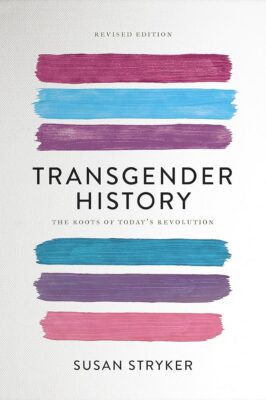 I’m thinking, too, of someone like Jayne County, once a drag queen from the South who hustled her way up to New York City doing sex work, became part of Charles Ludlam’s Theater of the Ridiculous, and became a major punk icon with her band Wayne County and the Electric Chairs before she transitioned. They had this amazing song called If You Don't Want to Fuck Me, Baby, Then Baby, Fuck Off. She brought this total, in-your-face punk sensibility to the work that she was doing. She titled her autobiography Man Enough to Be a Woman. She became a fixture at Max's Kansas City, and her style influenced everybody from the Dolls to Bowie to Lou Reed to Blondie. She was an incredibly seminal cultural figure. Is that “trans art” now? I think so. By the time the 1990s rolled around, a late-career Jayne County put out an album called Transgender Rock and Roll. And she paints. She has a really interesting outsider-artist style.
I’m thinking, too, of someone like Jayne County, once a drag queen from the South who hustled her way up to New York City doing sex work, became part of Charles Ludlam’s Theater of the Ridiculous, and became a major punk icon with her band Wayne County and the Electric Chairs before she transitioned. They had this amazing song called If You Don't Want to Fuck Me, Baby, Then Baby, Fuck Off. She brought this total, in-your-face punk sensibility to the work that she was doing. She titled her autobiography Man Enough to Be a Woman. She became a fixture at Max's Kansas City, and her style influenced everybody from the Dolls to Bowie to Lou Reed to Blondie. She was an incredibly seminal cultural figure. Is that “trans art” now? I think so. By the time the 1990s rolled around, a late-career Jayne County put out an album called Transgender Rock and Roll. And she paints. She has a really interesting outsider-artist style.
B&A: The history we are trying to collect is about the funding of artists; we’d like to know, what organizations, foundations, corporations, government grants, etc. were supportive of funding trans artists and culture back in the day? And which weren’t? Let’s give credit where credit is due.
JJ: Sean Dorsey’s Fresh Meat Productions was the pioneer test case that determined whether public funding would be available to trans artists. Sean broke new ground at the San Francisco Cultural Equity grants Program, and then moved on to the California Arts Council. Next was Grants for the Arts and finally, the National Endowment for the Arts. Sean succeeded because his work clearly achieved a level of artistic excellence that was undeniable. The only other successful trans art organizations I’m aware of are the San Francisco Transgender Film Festival and Peacock Rebellion in Oakland.
B&A: From your historical perspective, was San Francisco ever really a leader in trans culture?
SS: The Cockettes were totally brilliant. I would consider that trans. Or somebody like Steve Arnold, who directed Luminous Procuress and helped establish the whole midnight movie phenomenon. He started programming late-night avant-garde stuff at the Pagoda Palace in Chinatown before the Cockettes thought it would be a cool place to present their shows.
San Francisco in the sixties played a tremendous role in blowing open space for something that we might now call genderqueer or genderfuck, that kind of trashy, baroque, hippie, counterculture stuff. The Cockettes, the Angels of Light. San Francisco in the 1960s and 70s had a lot of cross-fertilization between different gender subcultures—street drag, drag club performance, hippies, punks, and high art—that laid a foundation for the queer scene in the 1980s and 1990s. People like Jerome Caja. San Francisco had cultural venues where radical experimentation with gender presentation and gender performance could take place, places like the 181 Club in the Tenderloin, a punk venue that used to be a drag bar.
B&A: Wonderful. Thanks Susan. One last question. What artists have inspired you?
SS: Well, that changes moment by moment. I’m always fangirling somebody new. I just saw the Kehinde Wiley show at the De Young and that rocked my socks off.
B&A: It was totally amazing.
SS: I've also been paying attention to Wangechi Mutu recently, I think she's brilliant. I had a chance to collaborate in a very minor way with Charlotte Prodger at the 2019 Venice Biennale, and obsessed about them for a while. I just find people I like and binge them for a bit and then move on when some new pretty thing catches my eye.
B&A: Thank you so much for your wisdom, information and sharing this piece of herstory.
SS: And thank you for the work that you do! And good luck on this project.
Adele Prandini
Adele Prandini
Adele Prandini has spent most of her life as a theater artist. For ten of those years she was Artistic Director at Theatre Rhinoceros.
Prior to that she was a founding member of It’s Just A Stage, a lesbian theater company that began in 1974 and continued producing original works through 1980. Adele has collaborated on numerous theater and dance productions with choreographer, Anne Bluethenthal. In addition to collaborating with Bluethenthal, she has had the opportunity to work with some seriously talented people among them Pam Peniston, Stephanie Johnson, Vola Ruben and Mary Guzman. She has been a recipient of Bay Area Theatre Critics Circle and Hollywood Drama-Logue awards. She was also the first artist recipient of the Lesbians of Achievement, Vision and Action (LAVA Award) presented by Bay Area Career Women.
Adele has always carried a camera around. Since her retirement she has turned her attention to photographing the natural world.
AP: Jeff, you were at the center of this wonderful wheel of creativity and were involved with many Queer arts organization in the Bay Area. Your finger was on the pulse of everybody’s work. You are the ideal prism to re-experience and re-witness this history. It would be a gift to everybody, a gift to Bay Area history, not to mention the great gift it would be to the arts community to have it filtered through your experience
JJ: In 1981 I remember being interviewed by Allan Estes, who was Theatre Rhino’s founder and Artistic Director. He put two lines of cocaine on his desk, lit up a big joint and said, “Okay, what can you do for me?” I thought: That’s a great opening line!
Allan was really the embodiment of the manic gay energy of that time: he was about 25 years old, and he was somewhat political. In 1978 he had already convinced Harvey Milk to help Theatre Rhinoceros to secure some of the City’s Hotel Tax funds and he had met with the gay head of the CA Arts Council, who urged him to submit a proposal. He had also applied to the NEA and secured a grant from the Theater Program.
Allan was really the embodiment of the manic gay energy of that time: he was about 25 years old, and he was somewhat political. In 1978 he had already convinced Harvey Milk to help Theatre Rhinoceros to secure some of the City’s Hotel Tax funds and he had met with the gay head of the CA Arts Council, who urged him to submit a proposal.
Before his assassination, Harvey Milk spoke directly to the Chief Administrative Officer (Roger Boas), who exclusively controlled how and to whom Hotel Tax revenues were awarded. As a result, Theatre Rhinoceros and the Pride Parade were the first queer cultural arts groups to get funded. When Allen and I looked at which LGBT agencies were funded by Grants for the Arts (then known as the Hotel Tax Fund), we noticed the Pride Parade received the smallest amount awarded in the Parade category, even though it was much larger than the Columbus Day Parade, the Chinese New Year’s Parade, Carnaval , the St Patrick’s Day Parade or the Cherry Blossom Festival.
Allen insisted that Milk’s “Gay rights ordinance” meant the City bureaucracy could not discriminate against Lesbians and gays. Even though Allen was thankful to receive a grant from the City, he made it clear to me that he was ready to challenge the obvious inequities.
We both remembered that a Chronicle reporter had asked Roger Boas to explain why the Pride Parade received only $5000, while he awarded substantially larger grants to all the other parades that attracted much smaller crowds. On the front page of the Chronicle on Pride weekend 1979, Boas explained that funding the gay parade was not good for the City’s business community because it fostered a bad image of San Francisco.
JJ: Adele, I’m particularly interested in talking to you because you were an active participant in the Queer arts community before I arrived, and I didn’t personally know many of the people in the City’s early Lesbian arts community. So I'd like to start at the beginning: Where were you born and raised?
AP: I was born and raised in San Francisco. I'm a native and I think there was always an LGBT community, since the city was first founded during the Gold Rush. As kids, in the 1950s , we would hear about Finocchio's great drag shows because our working class parents used to go to North Beach to watch Finocchio's drag shows. The club was a landmark, it was where a visible butch dyke would park the cars. I don't recall her name, but she was a part of the show right there in the parking lot. There was always a presence of visible dykes and drag queens in North Beach.
I went to an all-girls Catholic high school, St John's Academy for Girls on Mission Street. The nuns warned us about the City’s lesbian elements; “Don’t hang out with older girls,” that sort of thing. Nobody went away to college in my very working- class family; we went to City College.
I took theater classes at the community college, but college was not a good fit for me. I went into a class where the teacher, a guy, informed us that “In this class you will learn how to manipulate people.” I walked out because I did not have any interest in manipulating people for money. It was not where my heart was. After exhausting the theater courses there, I went to work with an organization called Performing Arts Workshop. Do you remember them?
JJ: Yes, I do. I remember the woman who started it, Gloria Unti. I used to write grants for her in the 1980s.
AP: There was also a fabulous actor there called Skip Mancini. I learned everything I could from her. Performing Arts Workshop was set up for inner-city kids. I learned a ton there. But I moved to Berkeley where I discovered an organization called A University Without Walls.
There were lots of women's courses: a women's music collective, a women's bookstore but no women's theater group. So I started a lesbian comedy improv class . There was no such thing as the Internet; it was all done by getting together in person and in groups. Many women joined this comedy group—It’s Just A Stage--it stayed together for almost 8 years. Some of the members were myself, Andy Leonard, Barbara Haley, Marge Neff, Jill Rose and Lynn Crowley.
JJ: Did you actually put on productions?
AP: Yes, I think at first around the coffeehouse scene, and the bars. Then we performed live at Oak Theater. Then in San Francisco we performed at the Full Moon Coffeehouse, and at the Artemis Café on Valencia Street.
There used to be so many churches and cafes that weren't traditional theaters, but you could do theater in them. It was such a wonderful time. where you could just go and do theater. At this time in the Bay Area there were over two hundred small community theater spaces.
And there were lots of folks doing lesbian theater. In addition to It’s Just A Stage, there was – The Whole Works Theater Company which included Elaine Magree and Michele Simon. Then Stephanie Johnson and Vicki Dellajoio were also doing lesbian theater.
JJ: Are you talking about that church on Market and Sanchez that burned down?
AP: They had a marvelous performance space. It was I believe the space where the Eureka Theatre got started.
JJ: That’s where Rhodessa Jones staged Lily Overstreet.
AP: Yes. In 1974. Throughout the seventies, not only were we lesbians, but we openly used the F-word: By that, I mean Feminist.
JJ: When looking at who Grants for the Arts funded back then, there was a theater company called Lilith. I could never figure out who that was.
AP: Terry Baum.
JJ: So did both of these entities—your Lesbian improv comedy group, (It’s Just a Stage) and Lilith both existed at the same time?
AP: Yesl, we were established first.
JJ: If we look back on that period, we can see there were multiple arts organizations that were really run by lesbians but they called themselves women's arts groups.
AP: You got it. “Oh don't worry, they'll grow out of it. It's just a stage.” Hello?
JJ: Okay, so Allan Estes arrived here in ‘77 as a 23 year-old college graduate from Boston and started Theatre Rhinoceros.
B&A: Which is still “America’s longest running LBTGQ theater.”
JJ: Allen produced some play at a leather bar and it did so well that he opened a 50-seat theater in the Goodman Building, on Geary St, between Van Ness and Franklin. After he produced a few plays there, he had enough money to rent the space in the Redstone building on 16th Street between Mission and South Van Ness.
One of the first things that happened was that City started a performing arts loan fund that enabled groups to borrow money, renovate a performing arts space and then pay the City back. So that's how Rhinoceros renovated its main stage and developed a second stage in the basement.
AP: My initial entry into Rhino began when Estes scheduled my play A Safe Light in the FY83-84 season and Chuck Solomon directed it.
JJ: Wasn't he with the Mime Troupe?
AP: Chuck? No. Prior to working with Rhino, Chuck was part of the Gay Men's Theater Collective, a group of 8 men who were doing what we were doing, utilizing all of the little performance spaces. What was unique about San Francisco at that time was its small venues . Every weekend you could go and see us, you could see Lilith and the Whole Works Theater Company, another lesbian company formed by Elaine McGree, and Michelle Simon. It was just a hotbed of performance.
JJ: So I'm trying to remember when I met you at Rhinoceros. Didn’t you teach a playwriting course?
AP: Yes, The Playwriting Workshop. I was the Playwright in Residence. I was also the production manager, assistant artistic director, then artistic director… I sort of played all the different roles there.
JJ: I remember writing the California Arts Council grant that I think was the one that hired you as the playwright, right?
AP: Yeah.
JJ: When I look back, what I remember about Allan was that he did not have the typical gay man's approach to women. He could see that that he was going to have to have lesbians as part of his future theater. That's why he aggressively pursued the California Arts Council so that he could hire you to run the workshops and classes. He was desperate to raise money: the first time I went to a Theatre Rhinoceros play there was a table in the lobby where volunteers were selling poppers.
AP: Allan was a visionary. He was also a very creative business man. I mean, I have never worked in a more underfunded, under-supported place. Rhino was blessed. We did so much with so little. We did a five-play mainstage season and a really full studio season. The Playwrights Workshop produced a little season of its own plays. That's the way people learn, by getting their play up on its feet and seeing it. So it was really fulfilling to produce there.
JJ: But at that time, while it was possible to get funded by the National Endowment for the Arts, the California Arts Council and Grants for the Arts, no foundations or corporations would fund Rhino. I remember Allan telling me he would meet people at the theater who would tell him “This show was really great and I'm so happy you did this. I work for such and such foundation or such and such corporation.” Allan would say, “Well, can you help Rhino get funding?” And they would say, “Absolutely not… I'd have to come out of the closet. I don't want to lose my job.” It really infuriated him.
Allen was an attractive and flirty gay man, as well as a relentless fundraiser. The three places Rhino did get funding were the City because of Harvey Milk, and the state ( where the Director was a gay man) and the NEA, I can’t remember how he secured that grant but he did. However, once someone from Ronald Reagan’s administration heard that the NEA was funding a gay theater company, they started searching for a way to defund it. The NEA Theater program assigned somebody to review Rhino’s organization, hoping to find a financial problem or some other irregularity. Ultimately the NEA staff defunded Rhino on the grounds that its artistic quality was below standard.
Both Allen and I were totally committed to figuring out how to fund Rhinoceros. We both felt aggrieved that LGBT taxpayers were being ripped off by bureaucrats who acted like they were doing us a favor to award us a grant. On occasion, we both felt entitled to act unscrupulously to overcome the institutionalized discrimination in the funding world.
AP: I like to call Allan's business model ‘creative,’ rather than unscrupulous.
JJ: I remember how awful it was to be trying to fundraise for The AIDS Show, the first play about AIDS. No matter what funder Allen talked to, they all said the play was ineligible for their funding because its subject—the AIDS epidemic was “too political.”
AP: First of all, Theatre Rhino was underfunded. Secondly, it was under-supported. Thirdly, we didn't realize it at the time, but we were not in post-traumatic stress, but in permanent traumatic stress. People were fighting for their lives
People would ask, “what do you think about this spot?” Of course, it’s a lesion and you’re pretty sure it's AIDS. However, you wanted to be kind and sometimes kindness is better than honesty. But how do you handle that?
At first Rhino tried keeping a list of people who were sick, or who had died, but we couldn't keep up with the names. It became hard to produce a play: actors would come in, be there one day, and gone the next. We couldn't put on shows because there just weren't enough performers to do them. People outside our community couldn’t really understand what that was like; they just couldn't believe it.
JJ: I was already involved in writing the grants for The AIDS Show when Allen died and Cleve Jones recruited me to be the grant writer for the SF AIDS Foundation. Then I founded Mobilization against AIDS with Paul Boneberg. I was the first grant writer for Open Hand. Then my partner came down with AIDS and I took care of him until he died six months later. Suddenly AIDS just took over my life. Soon I had little time to work in the arts community because I was consumed by the absence of public funding. After almost three years of pursuing AIDS funders, the situation had vastly improved: it was really exhausting—and terrifying. Finally I said I'm out of here. No more AIDS stuff: I have paid my dues. I’m going back to raising funds for Queer arts and artists. This was 1986. Is there a recording of The AIDS Show that you know of?
AP: Theater Bay Area did one. All of the shows at Rhino were taped. They were recorded for posterity. Oh, who were those filmmakers who made the films about AIDS?
JJ: Rob Epstein and his partner Jeffrey Friedman. Maybe they have a copy of the show? Before I had started working for Theatre Rhino, I had met Rob Epstein when he was a ticket-taker at the Castro Theater. It took him 5 years to secure funding for The Life and Times of Harvey Milk. Not a single person, or foundation, or arts agency, or anybody would help fund it. Rob had to go to New York to raise the money. Allan was experiencing the same thing as Rob: that everyone in the Bay Area funding world was afraid that they would lose their job if they funded queers.
AP: Does The Performing Arts Archive still exist?
JJ: Yeah, It is now called the Museum of Performance + Design. https://www.mpdsf.org
JJ: I saw The AIDS Show over and over. I would take my friends to see it. People had various reactions. One guy who I took to the AIDS show for his birthday present almost had a nervous breakdown. I assumed that because he and I were somewhat good friends and members of Alice B Toklas, that he knew about and practiced safer-sex. Then he confessed to me, no, I'm the kind of person that picks somebody up on the bus while I'm coming home from work, has a quick orgasm and then heads home to have dinner with my partner. He was barely able to make it through the show.
AP: To create the AIDS show, all of us at Rhino came together to recruit artists to propose scenes. I don't think there were very many cuts. My piece in the show was called Mama's Boy. It was based on my experience being at the hospital with Allan and his mom in 1984, when Allen was one of the first LGBTQ artists to die of AIDS.
Hospitals treat AIDS patients better now. But back then, everyone covered themselves completely in hazmat suits to go into AIDS patient’s hospital rooms. People were saying the most shameful, cruel things to Allan’s mother, like, “Well, you know, if your son didn't act the way that he did…” This woman's son is dying and this is the way people were responding to her. We surrounded them and tried to just be as loving as we could. That's what inspired my piece.
JJ: I didn't know that. I remember Allan called me and said, “I just checked into Davies Hospital, I'm not feeling good.” Later that night I went to the hospital to see him on my way out of town. I was only gone for 3 weeks but by the time I got back, he had died.
AB: And what year was that?
AP: 1984
JJ: Yeah, Allan died before the show went up.
Annie: I lived through the ‘great dying’ too. I was living in Manhattan. I did some safe sex porn for the Gay Men's Health Crisis and did a couple of projects with Act-Up. I remember when AIDS first hit and I lost many friends and lovers. Time heals, and time sort of erases the pain.
JJ: Yeah, it's not something people really want to talk about anymore.
Beth: You know Seth Eisen's walking tour that he did about Sylvester? The best moments of that entire walking tour was his piece about AIDS. The elders were all crying. The younger audience members were just staring blankly at us, because they didn’t live it like we did.
Annie: By the way, I performed at Theatre Rhinoceros around the Millennium. The Queer Cultural Center, including Jeff, produced my show, Annie Sprinkle’s Herstory of Porn. We sold out all the six or seven shows. QCC generously paid me 70% of ticket sales. It was great. Pam Peniston did the set.
AP: I remember the first big grant we got together was that $75,000 grant? I was beside myself. It was a three-year grant, $25,000 a year. I was just so thrilled. It was because the grant officer was also gay. It was from one of the private foundations. Yeah, this lovely man. I don't remember the foundation.
When the AIDS Show went up, it became Rhino’s cash cow: it ran for 9 months, five or six shows per week. Then there was the second AIDS Show called, Unfinished Business. Then Grants for the Arts decided to pay for the show to tour to the Kennedy Center in Washington DC, to Dallas and to San Diego. But when we were trying to raise money for the initial show, GFTA would not go near it. Leland Moss, after Allan died, took over as the director. Then he died too. I tell you, it was a time.
JJ: Yeah. Did you ever meet Ed Mock? He died in 1986.
Beth: You know, Darryl Smith, the co-Director of the Luggage Store, invited me to do an installation about Ed Mock which incorporated some of Mock’s costumes and footage of his performances. It was in that triangular space on Market Street across from the Luggage Store Gallery.
AP: Linda Hope, who was with It’s Just A Stage, danced with Ed Mock. She was a piano tuner.
AB: Jeff, did you say you were his grant writer?
JJ: Yeah. He was one of the most brilliant dancers in the city’s nonprofit arts community. There was nobody else like him. So after Allen died, why did the Board decide to hire Kris Gannon as the director? Why didn't they hire you?
AP: Chris brought me in. She brought in Doug Holtzclaw. I think she brought in John Carr. She brought in a lot of people.
JJ: Frameline had to respond to the question of why there were so very few lesbian films being screened in the annual festival. Then when Frameline decided they would have a screening of lesbian films, I think at the Roxy, but after the lights were dimmed and the film started, it was two men having sex. Frameline had to deal with this issue. Michael Lumpkin, the founder of Frameline and its leader for almost 20 years, was committed to solve this problem. Back then you couldn’t just make a film on your computer. Michael Lumpkin believed “the reason we don't have enough films by lesbians is because making a film is expensive.” Nevertheless, Lumpkin seriously addressed the issue of how does the lesbian community fits into predominantly gay male organizations like Rhino and Frameline.
B&A: Yes, the gay men and gay women’s communities were very separate. Then when AIDS hit, lesbians stepped in to help with caregiving and AIDS activism.
AP: Not only were we dealing with people dying, at the same time we were dealing with how to deal with each other. That just didn’t happen automatically. You need to build trust, and that takes time and a lot of hard work. Men and women don't trust each other automatically. It's not there.
I know I'm not the easiest person in the world, but I am genuine. I will genuinely try to work on a relationship with you. So I have that going for me. We were underfunded, overworked, and we had to deal with different personality types. But at Rhino we had a great working relationship. I saw it. So learning to trust and work together at the same time was happening.
Kris Gannon started introducing women's work. She scheduled Jane Chambers’ plays. That brought a lot of women into Rhino. So did having women working at the theater. I tried to bring in women of color to make new works and to build relationships with other organizations. I brought in the first trans work.
AB: Was that Kate Bornstein? Was Kate's the first trans work that you produced ?
AP: Yeah, but there may have been other trans stuff before her.
JJ: Was Kate already trans when you met her?
AP: Yeah.
JJ: After Kris Gannon there was Ken Dixon, who was a very queer black guy. He had a very strong view of how everything should be. I didn't have very much to do with him because he didn’t hire me. But when he died, you became the director, right?
AP: Yeah.
JJ: You knew Tony Press, who worked for me at that time. All three of us were here in Pacifica. But what year did you become the director of Theatre Rhinoceros?
AP: Well, I was acting director for a couple of years. It's almost like a curse to really accept the reins. So I was just an acting director. I was there for about 15 years in total.
JJ: So in the 90s, Theatre Rhino was more or less a mature organization. I think the only reason queers ever achieved large-scale acceptance in the funding world was because of AIDS. For the first time it was ok to fund queers. Then it was possible for you as the director to get funded.
AP: Yeah, right. I was doing stuff like trying to work with Theater Esperanza, bringing the Lesbian Brothers out from New York and trying to just give people space and let them do their thing. You know, that was a big thing for me. I'm not going to tell you what to do. I will give you the space to do what you want, because I think that's what people need.
JJ: So which play by Cherrie Moraga did you produce?
AP: We produced GIVING UP the GHOST in Rhino’s 88-89 season
JJ: That's before she and Ellen Gavin were living together, right?
AP: Yes, exactly. An interesting thing about Brava Theater Center is how it morphed. Rather than close down It’s Just A Stage, Ellen and I discussed transitioning the 501c3 into Brava! For Women In the Arts. Both organizations had similar missions.
JJ: Oh, I didn't know that. Ellen and I had worked together for four or five years. Everyone totally respected her because she was determined and relentless and she succeeded.
AP: I have a great deal of respect for Ellen Gavin. She created a multifunctional art space in the Mission that serves a variety of communities.
A&B: What are some of the controversies you've faced in your life?
AP: Well… I'm not exactly sure how to answer that, but there were controversies and controversies. It's this darn lack of integrity, you know?
JJ: So when did you leave Theater Rhino
AP: In the late nineties. I had a biopsy on my breast. Then I went back to the office and all of a sudden, I looked down and I'm bleeding. I wondered WTF am I doing? Then it occurred to me that this job is no longer good for my health. The Board got shady and it just became too much. There was a lack of integrity and there was infighting, and all of that just built up. It wasn't any one thing.
JJ: I know you did something with Pam Peniston before you left, right?
AP: Yeah. Pam worked on a lot of my shows and did a number of sets for me. I'm very grateful for all of the artistic relationships. There were so many wonderful people that I worked with that I loved. Vola Rubin was another wonderful lesbian designer. Stephanie Johnson was the lighting designer. Iva Walton was another really talented set designer and production manager. Clay and Rosie, two very talented people who worked in production. So many people that I really adored.
JJ: Now I remember that you were having health problems.
AP: I didn't realize it at the time, but there was a tumor growing in my brain. It was too much.
AB: Did you retire at that point completely or did you go on to do more great things?
AP: I kicked around. I started teaching computer skills for an adult school. I worked with at-risk youth with the Bridges program. People get out of prison and they need those skills. I was also teaching senior citizens. I did that for 15 years.
JJ: And that was easier than Rhinoceros?
AP: You know, it was challenging as well. But I had to make a living so I did it.
JJ: I want to ask you about John Fisher, who now runs Theatre Rhinoceros, because I've never met him.
AP: I only met him a couple of times. I no longer go to Theatre Rhinoceros, so I can't really say. But he is a playwright and director.
JJ: I confess that I haven't gone to any of his plays. I also saw that right around the time you were leaving Rhino, the New American Conservatory Theater came along. We used to call it the “Nude Conservatory Theater” because their early plays were publicized by advertisements that featured hot-looking young men of color being leered at by middle aged white gay men. Like me, the director, Ed Decker, was from Austin. Ultimately, he must have done something right because after the Millennium his theater company began played the role that Theatre Rhinoceros used to play. Eventually they started doing better work: I know Jewelle Gomez did work there.
AP: Yes. Bless her. I did go see her play on Alberta Hunter, which I thought was really well done.
A&B: We did a theater piece there in 2006, Exposed: Experiments in Love, Sex, Death and Art.
What would you say are your greatest achievements?
AP: In general I would say that my greatest achievement was creating opportunities for theater artists to create work . In so far as my personal work was concerned. I loved “Pulp and Circumstance.” I wrote it in collaboration with Sue Zemel, Anne Bluethenthal did the choreography. Vola Reuben did the set. Stephanie Johnson did the lighting.
As a kid, I wanted to be a country western singer. So the main character is this butch young woman who wants to grow up, move to Nashville and sing country western music. Naturally her mother is horrified. Most of the activity takes place in a lesbian bar in the fifties. The cops come in for their pay off. The owner of the bar is another butch woman. There's a black and white female couple and a couple of beatniks.
Pulp was extremely successful for the theater. It toured down to L.A. for a festival and it won a number of awards. I also did a play based on Judy Grahn's book Queen of Swords. I'm very proud of that. I'm proud of both shows for different reasons. Pam did the sets and the choreography. The set was this fancy scaffolding. Terry Sendgraff did some aerial work with the cast ande there was a chorus of crows that Pam outfitted in masks. Queen of Swords was in Rhino’s 88-89 season.
A&B: Was any of your work focused on environmental issues?
AP: Yes, my play Coconut takes place on an island, when developers are trying to destroy the island. The lead role is a lesbian shaman who runs this resort where people come to get healed. In the end, the island winds up being reclaimed by the volcano.
JJ: Was that before 1997.
AP: Yeah.
JJ: I remember Pam was working on that near the millennium. So the two of you have had a very long, collaborative history?
AP: A long and illustrious collaboration, yes. And we still do. Pam and I now collaborate on Photography exhibits
Annie: Adele, were you the director of Theatre Rhino when I did my show, Annie Sprinkle’s Herstory of Porn?
JJ: I think maybe that was the second or third National Queer Arts Festival, which would have been the year 2000 if I'm not mistaken.
AP: Well, I was gone in 2000.
AB: Adele, where is Rhino’s archive?
AP: I think Doug Holtzclaw gave it to the University of California in Berkeley, He was artistic director after me and before John Fisher.
AB: I'm so glad your archive is in a good, secure spot. That's great. You did a lot of really important work.
JJ: It’s been very pleasant for me, Adele, just hanging out with you, after many years of not hanging out. Just to see you.
AP: Yes, it's a pleasure.
Lenore Chinn
Lenore Chinn
Lenore Chinn was born in San Francisco and has spent her entire artistic career as a painter and photographer living in the City. h3>She is a founding member of the Queer Cultural Center (QCC) an original member of Lesbians in the Visual Arts, and an active member of the Asian American Women Artists Association. Chinn has also served on the SF Human Rights Commission. She continues to exhibit her work and advocate for the legacies of Bernice Bing and other Asian American queer visual artists in the Bay Area.
Lenore Chinn
Beth Stephens & Annie Sprinkle (B&A): Lenore, please introduce yourself and describe your work and career?
Lenore Chinn (LC): I was drawing ever since I was a little kid and I had a natural gift. Later, when I enrolled at City College of San Francisco, there were two art departments: one was oriented towards commercial work, called Advertising, Art and Design; the other was called the Fine Arts department. For whatever reason I ended up in the commercial one where I actually I picked up a lot of skills: I got introduced to photography, I learned to develop black and white film, to shoot with a 4x5 graphic view camera, and to do printmaking. Ultimately, I got my AA (Associate in Arts) in Advertising, Art and Design. Later I got a BA (Bachelor of Arts) at San Francisco State in sociology.
Lands End Tris Evelio Talavera
Lands End Tris Evelio Talavera[/caption]In the early days I would do commissioned portraits. But that wasn't my favorite thing. I don't really like to do the kind of portraits most clients had in mind. I'd rather not be restricted by someone who just wants to create something to put over their sofa.
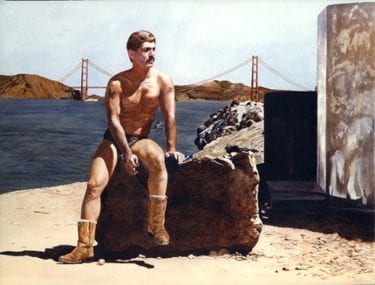
Lands End Tris Evelio Talavera
In the 1970s I was at San Francisco State, the war in Vietnam was still going on and the college’s Ethnic Studies programs had barely come into being. I took a lot of photographs of the cops on campus in full riot gear, on horses, on motorcycles, (most likely the infamous TAC Squad that had come out during the earlier student strikes in the year or two before my arrival).
…. So, when I've gone back to give talks in their Ethnic Studies classes, I would show the students these photos and their jaws would just drop. These photos were taken at the same time when the students were shot at Kent State; May 1970. I was right in the thick of what was going on. I reminded the students to pay attention, because we're still going through similar wars. That has not changed.
(Note: I went back to SFSU to see the encampments of students urging the university to divest from any U.S. funds which may going toward the genocide of people in Palestine and specifically, Gaza).
So, I started painting the lives of the people in my immediate circle who were largely lesbian, gay and people of color as my subjects. My style in painting was super realistic. Drawing people was just a natural thing. Mainly I painted my friends. That's often the case, that artists paint the people in their immediate circle.
For many years photography was my secondary expressive medium, chronicling events as I do now, but mainly creating concepts for my paintings.

Domestic Partners, 1989
Jeff Jones (JJ): Lenore, I feel like you have an essential perspective on this chapter in history because when I arrived in San Francisco in 1979, you were one of the first artists I met here. So I'd like to hear your perceptions about what individual artists were around before I got here. Because, except for maybe Adele Prandini’s It’s Just A Stage, I don't think there were any other Queer arts organizations before 1978, when Theater Rhinoceros and the Gay Men Chorus were founded.
LC: My recollections going back 40 years may be kind of fuzzy. There's a lot of overlap in who I met when and where. When I first started showing my work, the gallery system, as it came to be known, had not yet taken root. Today it is much more focused on commodity, commercialization, and profit making. One of the first places I exhibited was the Lucien Labaudt Gallery, run by his widow Marcelle Labaudt. According to my late uncle, the photographer Benjamen Chinn, my getting into that gallery was a great achievement. But I was submitting my work to all kinds of different venues, mostly alternative spaces and to competitions juried by notables in the Bay Area or around the country.
One of my first exhibitions was in a group show located at San Francisco Arts Commission’s Capricorn Asunder Gallery. This 4-person group show was curated by the late Bob Hanamura, whose salary was paid by Jimmy Carter’s Comprehensive Employment and Training Act (CETA) program. That was in 1980. I was also involved in the San Francisco Arts Festival (NOTE: Art in the Park was not affiliated with the SF Arts Commission and that event was held in Golden Gate Park, not Civic Center. It was produced by Frank Pietronigro and sponsored by the Castro Street Fair Non-Profit Corporation). held outdoors in the Civic Center. I got my start by responding to calls for artists and by submitting slides of my work everywhere I could find opportunities.
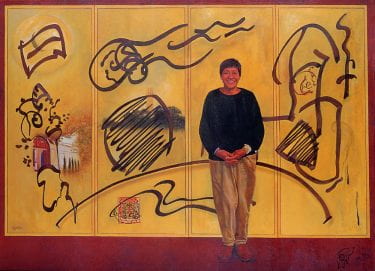
Bing
JJ: When you started your career here in San Francisco, what other gay or lesbian artists did you know? How about the painter Bernice Bing? When did you meet her?
B&A: Her paintings are incredible!
LC: Not until about the last 8 to 10 years of her life. I met her through 2 sources. One was through L.A. “Happy” Hyder because I was involved with the group Lesbian Visual Artists (LVA) just before I got involved with QCC. Around the late 1980s and early 1990s I was part of a group who organized an exhibit in the rotunda of City Hall because somebody in our group, Dori Friend, worked there and had access. I met a lot of people through the course of all my art explorations That is how I got to know Richard Bolingbroke who started the Gay and Lesbian Artist Alliance in 1989. Somewhere in that time I got to know Valérie Jacobs who recently died on March 7, 2024.
JJ: When did you meet artist Rudy Lemke?
LC: Not until you guys got us together after the San Francisco Arts Task Force formed in 1990 or 1991. In terms of the individuals who ultimately formed the Queer Cultural Center’s initial Board of Directors, I knew Adrienne Fuzee who was on the board of LVA and I might have known Osa Hidalgo-de la Riva. Adrienne ran Spectrum Gallery near the foot of the Bay Bridge. She would curate projects in what today we would call pop-up galleries.
JJ: She was one of the very few lesbian curators I met. She was an impressive person; unfortunately, she died soon after I met her. The first time I remember seeing your work it was at that South of Market lesbian bar, dance club, and hostel on Clementina Street called Clementina’s Bay Brick Inn but it went by several names (see: https://en.wikipedia.org/wiki/Clementina%27s_Baybrick) run by Lauren Hewitt. Earlier you mentioned that your Uncle Benjamen Chinn was a really great photographer. Was he your main role model when you were growing up?
LC: Yes. I had two great role models. The other one was my dad, William G. Chinn because he was really ahead of his time in a lot of ways. He was a mathematician but he exposed our family to all kinds of art. We lived out in the Richmond district in the 1950s at a time when there really were very few families of color out there. It was a pretty segregated neighborhood. But my father took us to the de Young Museum and the Legion of Honor (formerly known as the California Palace of the Legion of Honor), on a regular basis. He also took us to see plays and musicals downtown.
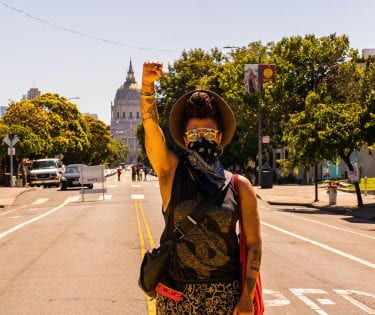
Melorra Green
My uncle and my dad were pretty close. I grew up hearing stories about my uncle's travels and his photography. He brought a camera, with flash bulbs, to every family gathering. He didn't realize the impact he had on the artists of my generation. He went to the California School of Fine Arts, which later came to be known as the San Francisco Arts Institute. Hearing these stories had a big impact on me because he made me aware of what was possible.
JJ: Where did you meet Rick Pacurar and Michael Housh? The Milk Club? The three of us worked together in the 1980 US Census. Rick Pacurar, in addition to being Supervisor Harry Britt's roommate, was an assistant to Mayor Art Agnos and congressman John Burton before he died of AIDS. Michael Housh also worked for John Burton before he became the City of San Francisco’s archivist. Your portrait of these two gay men was the first one of your works I looked at critically.
B&A: What was the Milk Club and where was it?
JJ: The Harvey Milk LGBTQ Democratic Club was originally founded by Harvey as the SF Gay Democratic Club in 1976 to provide a Progressive alternative to the more conservative Alice B Toklas Club.
LC: I joined this Club around 1980 and co-led the Club’s Women’s Caucus along with Tish Pearlman. We advocated expanding the Club to include more Lesbians. The name changed to reflect that inclusion, from the Harvey Milk Gay Democratic Club to the Harvey Milk Lesbian and Gay Democratic Club. I don't know the people in it currently; it's been a few generations.
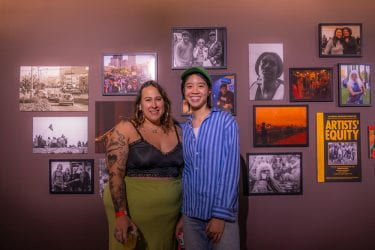
Chinn and Tricia
JJ: I started going to both Harvey and Alice in 1979. I noticed there were very few lesbians at the Milk Club and not many more at Alice. Both Clubs were very male. Why did you join Harvey as opposed to Alice?
LC: I can’t give a definitive answer, but I kept running into a lot of their members. I probably went to some meetings in the early eighties to hear people like Dr Marcus Conant who was talking about what was going on in the community before AIDS had a name.
JJ: So I also remember you did a portrait of painter Kim Anno (who recently became a Guggenheim Fellow) and her wife Ellen Meyers. How did you know Kim?
LC: Kim and I met in a project at the South of Market Cultural Center in the 1980s when she curated one of my paintings of a black cat. She also knew Adrienne Fuzee.
JJ: I remember seeing that picture several times, perhaps it was hanging in Moira Roth’s house.
LC: Yeah, they were pretty close. Moira, who was the Trefethen Professor of Art at Mills College, helped Kim when she was trying pursue a teaching job at the California College of the Arts. Note: The image Jeff probably saw was the original photo on which my portrait of Kim Anno and Ellen Meyers, titled “Before the Wedding,” was based.
JJ: Beth and Annie, did you know Moira Roth?
Beth: We both knew her and we loved her. I knew Happy Hyder and Adrienne Fuzee too. At one point, I think Adrienne and Happy lived together in Oakland.
Note: Adrienne and Happy (L.A. Hyder) shared an apartment on 11th Street in Oakland.
LC: She used to host great salons.
JJ: Adrienne was one of the founders of the Queer Cultural Center(QCC).
B: I had a crush on her. She was very striking.
JJ: So Lenore, who recruited you to be on QCC’s board?
LC: You did.
JJ: Me. Okay. I couldn't remember if it was me or Pam Peniston or Greg Day.
LC: You threw out the idea of a gay museum when we were sloshing drinks with Pam and probably Rudy.
JJ: I didn't know either Pam or Rudy until we found ourselves on that Task Force the City set up to deal with the aftermath of Festival 2000.
LC: Yeah, I heard all kinds of stuff about it.
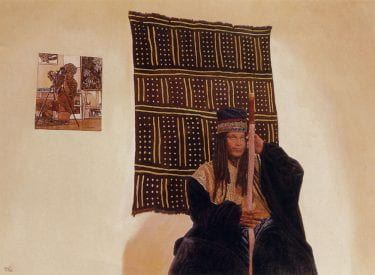
Affirmations
JJ: That's where I first met Flo Oy Wong. Because after I put out my report entitled “Institutionalized Discrimination at Grants for the Arts” in 1987, either Moira Roth or probably Flo Oy Wong called me up and said I want to meet you. I volunteered to cook dinner for six. In addition to Flo and me there were 4 other people: Carlos Villa, Flo’s brother Bill Wong, Moira Roth and Betty Kano, a Japanese American painter who had been at SF State during the ethnic studies struggle in the late 1960s.
So, I had dinner with almost five complete strangers. Moira suggested that we go around the table and introduce ourselves; this process took over an hour. After my guests left, I realized that my report or race and the arts, was significant. Although the Chronicle’s response was to run an editorial that said that art and race had nothing to do with each other, I was universally greeted with derision by the “professionals” in the arts world. On the other hand Bill Wong, who was the only Asian American nationally syndicated columnist in the United States, later published an article, which discussed San Francisco’s Arts Apartheid Policy.
AB: Lenore, please tell us about Flo Oy Wong. Who was she and what did she do?
LC: Flo Oy Wong is a Sunnyvale based artist and now a poet. There's a film that just came out called “Drawn from life: The Creative Legacy of Flo Oy Wong.” It was recently completed and shown at the Silicon Valley Asian Pacific Film Fest. It was nice to see on the big screen. Plus there’s gonna be a mural going up with her work at the restaurant where she and her family worked in Oakland.
JJ: I met Flo before my dinner when she contacted me and asked me to help her raise funds for an exhibition of Chinese American painters that would be included as part of Festival 2000. I was very interested in having an inside perspective on Festival 2000, which had been set up by Grants For the Arts in response to my report. Flo convinced Festival 2000’s Executive Director to commit $30,000 or $40,000 to the exhibition. But then the Festival went bankrupt after 4 days, and the directors shut it down, leaving everybody holding the bag, including Flo.
LC: Flo said she was in tears because she thought, oh my God, we've lost all this money and what are we gonna do? She said René Yañez calmed her down. He was a trip and a half. The community is so small that if you're here long enough you meet everybody.
JJ: That's true. If you're as old as we are, you eventually meet almost everybody. Flo suddenly dragged me into raising money for that event and that’s where I met Bernice Bing for the only time in my life.
LC: Bernice died the same year as my mom, 1998.
JJ: So that was in 1990, Festival 2000. In 1999, “They Hold Up Half the Sky" - "Bernice Bing: A Memorial Tribute and Retrospective,” was co-curated by me along with Flo Oy Wong, Moira Roth and Kim Anno at the South of Market Cultural Center. The Executive Director of the South of Market Cultural Center Jack Davis had known Bernice from their early days there. The other half of the project was the 5th anniversary celebratory exhibit of the Asian American Women Artists Association.
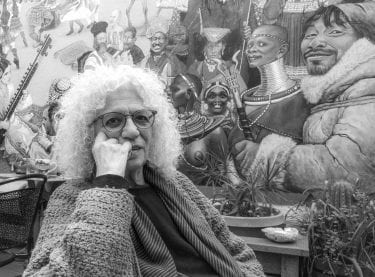
La Happy Hyder Cafe International
LC: We got together down at Jack Davis’ office. He had known Bernice from the early days when she had been the first Executive Director of the at the South of Market Cultural Center. He wanted to have some kind of a tribute for her because of her involvement with the Center. That's when we pulled in the Asian American Women Artists Association (AAWAA). It was on the verge of its 5th anniversary that year, then QCC was kind of behind the scenes because Rudy was putting the website together for all of those things.
JJ: I was writing the grant.
LC: The Asian American Women Artists Association was the other way I knew Bernice.
JJ: Because of that, I spent a lot of time with Flo Oy Wong and later we hung out with her brother Bill too. He wrote a nationally syndicated column that talked about Grants for the Arts as arts apartheid policies in San Francisco. That flipped people out, as you can imagine, Kary Schulman, the Director of Grants For The Arts was livid.
LC: I saw Bill Wong the other day at a film festival. He's trying to navigate without his wife Joyce, who passed last year. He has a new book coming out that focuses on their father. Well, maybe you know about this. Brenda Wong Aoki and Mark Izu just had a production at the Presidio Theatre entitled “Soul of the City” that was spectacular.
JJ: Yeah, Marie Acosta saw that too and she said the same thing.
The other thing I wanted to talk to you about was the lesbian blood drive that you did during the AIDS crisis. How did you decide to do that?
LC: Well, some of us in the Milk Club were trying to figure out what kind of projects we could do to support people with AIDS. We heard about a blood drive that was done in Santa Cruz. The women's caucus decided that we would create something like that. Dawn Moore, one of the Milk Club members, had a connection to Most Holy Redeemer Church in the Castro. We worked it out so that we were able to have the mobile blood draw unit of the Irwin Memorial Blood Bank (Note: the name has changed to Blood Centers of the Pacific) come out. It all ran pretty well until we ran into Dr. Lorraine Day, who was a Seventh Day Adventist. I don't know if you remember that controversy, Jeff, but she tried to shut us down.
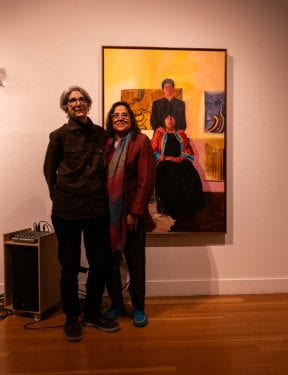
Before the Wedding
There was another smaller blood drive called Arm in Arm run by a nurse friend of mine named Penni Kimmel. She was basically told to cease and desist because Dr. Day used her influence and was telling outright lies. Dr. Day had no knowledge of what was going on, but she presented it to the health department that we were collecting tainted blood.
Because of my connection as a healthcare worker with California Pacific Medical Center at the Davies campus, I knew a lot of doctors and nurses. They helped me create a petition to counteract the stories that she was telling. Anybody who knew anything about what was going on with the blood drive knew we weren't collecting from gay men. At that time the guidelines were pretty narrow. Gay men could not donate to those blood drives. Not that lesbians can't get AIDS, but in those days it was crazy because people literally thought you could get AIDS standing next to somebody in an elevator. Davies got freaked out because some of the patients who were not sick would see all these guys coming in who really looked like death. So they got the hospital to acquiesce to put in a separate elevator so that patients who had HIV/AIDS would be going through a different elevator to get to various parts of the hospital.
At Davies we had a large population of patients with HIV and AIDS coming through because of where we were located; Castro and Duboce. Eventually we got Dr. Day to back off and the blood drive continued for about 9 years.
JJ: Wow! It went on that long.
LC: It wasn't like if you donated blood, it would go directly to a person who had HIV/AIDS. Because that's impossible logistically. But it allowed for our account to accumulate credits. A lot of people with AIDS were getting blood transfusions because of AZT, which was one of the primary drug therapies. AZT had a side effect of anemia. I think our patients saved about $75 a pint. So it was a financial benefit for those who applied for credit.
B&A: Lenore, what job did you have in health care?
LC: I was a clinical laboratory assistant and an assistant to the pathologist. Part of it was clerical and part of it was assisting pathologists, doing things that did not require a license.
B&A: Did you have that job because you were an artist on the side or were you an artist first?
LC: I was looking for a job to essentially subsidize my art practice and friend of mine from college was working there and heard that there was a job opening. I was looking for part time work to subsidize my art practice. In those days it was pretty easy to get work with referrals and whatnot. Now there's like all this crazy bureaucracy. She referred me and I talked to the head pathologist. At that time it was called Franklin Hospital. Before that, long before that, it was called German Hospital, but during and after World War II, that wasn't too popular so they changed its name to Ralph K. Davies Hospital.
JJ: He was an oil billionaire whose wife Louise is the namesake of Davies Symphony Hall.
LC: So I worked there for about 35 years. I started working just on weekends. Then I worked in the evenings full time. Eventually I cut my hours to part time, but I still could keep my full medical benefits… dental, and vision. You can't get that kind of job anymore.

John Paul Marcelo
JJ: On my way out of town in 1984, I went to Davies to see Allen Estes. He was one of my closest friends. I was gone for 3 weeks. When I got back, he had passed away. That was just what happened back then. He was the founder of Theater Rhinoceros and the first producer of The AIDS Show. But he died before it opened. I'd like to talk for a minute about your relationship to the San Francisco Cultural Equity Grants program. How many grants did you receive from them?
LC: The only grant I have ever received was in 2011. You didn’t write it. Rudy and Pam Wu assisted me with it. Over the years I had seen what you had written for other artists and groups and that was a nice template.
By then I knew Laurie Lazer and Darryl K. Smith from the Luggage Store Gallery where I did a show called Family Album with Steve Compton, a friend of mine. That was one of the first projects I did that included Flo Oy Wong: Steve and I had heard about her work and saw her pencil drawings of Oakland’s Chinatown at the Oakland Museum. Then I got familiar with the Luggage Store and I co-curated a show there. Then I did other projects because I was on a jury with Carlos Villa there.
JJ: Yes, he was the chair of the board.
LC: I had a long relationship with Carlos and he was really close to Moira Roth.
JJ: He and I were also very close. He was my mentor and the person who taught me how to talk about things from the outside, from the ‘other’ perspective. He said there's actually two ways you can look at this. One is from the inside, one is from the outside. You're from the outside because you're queer and you should incorporate that into how you think and talk. I was like, wow, that’s really smart. That was around 1989.
We stayed in touch until he died in 2013. I still miss him very much because he was the one who really pushed me through that door, and many other people too. He said, “I've been in San Francisco a long time and I was at the Art Institute way back when there were people of color and queer painters in the fifties and early sixties that nobody really could remember.” Then he did that show about the “early expressionists,” as he put it; Rehistoricising the Time around Abstract Expressionism in the San Francisco Bay Area. That was at the Luggage Store and was really an amazing exhibition.
LC: Emael Haasalum helped him create a website and it's still live. It includes my information about Bernice and there are a bunch of people in there. https://rehistoricizing.org/ Bernice was in that show because he asked if we could get a hold of some of her work. I knew Alexa Young, the Executor of Bernice’s estate. So we were able to include a couple of her pieces in that show.
B&A: When was that show?
LC: It was June 4 – July 31, 2010
B&A: Does the Luggage Store have things like their catalogs and ephemera organized? Is everything still there?
JJ: No. The Luggage Store is the place where an incredible number of artists of color had their first shows and who became really, really, really famous.
Were there any other LGBT painters? in the Family Album exhibition that you co-curated with Steve Compton?
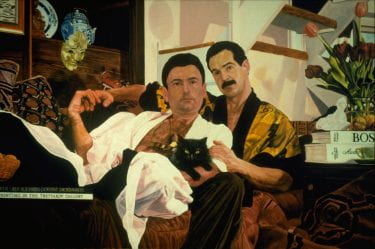
The Family ,1991
LC: The artists in Family Album had work in a variety of media and included, among others, L.A. “Happy” Hyder, Osa Hidalgo-de la Riva, Lola de la Riva, Orlonda Uffre, Greg Day, Maude Church, Steven Compton, Flo Oye Wong and myself. Years later (2013) I curated a separate exhibit there called “Flo Oy Wong: The Whole Pie.”
JJ: There was a show named “Face” that was all portraits…
LC: That was the first show that Rudy Lemke and I co-curated and organized. That was huge.
JJ: Yeah, it was the opening night of the first National Queer Arts Festival
LC: We were still dealing with slides in those days. That's how long ago it was. Everything was sent by snail mail. One day Rudy said he got a death threat because he didn’t include someone in the show. I don't know if somebody actually went to his house and rang his doorbell. We laugh about it now.
JJ: There is a catalog that I have somewhere in my archives.
LC I designed the program. We printed boxes and boxes of those catalogs. I'm sure Pam has some in her basement too.
JJ: I'm sure she does.
When I think back now on people that were on the original board of QCC it included people like Blackberri and Adrienne. You, me, Pam and Greg, Osa Hidalgo-de la Riva, and Freddie Niem.
LC: He's the one who took that picture of all of us.
B&A: Has your archive been placed somewhere yet?
LC: No, but I have received overtures from various places that want me to keep them in mind. There's a woman coming out from the Smithsonian soon who wants to talk to me and she wants to see my work. She also wants to see my uncle's work, even though my cousins and I don't have too much left because his work has already been distributed to various archives. We had so much stuff at one point that we just wanted to make sure that our uncle's work was safe. When he was still alive, I asked him where he would want his stuff to go. He said the Center for Creative Photography, which is a national photographic archive in Tucson, Arizona. That's where a lot of his friends’ work went, like Edward Weston, Minor White and others my uncle knew have their photographs archived there. Minor White, was gay. So, we got a lot of stuff placed there and then later we placed some stuff with SFMOMA.
LC: Oh, the Cantor took a batch of his vintage photography. One of his photographs is on view right now. So we went down to take a look.
B&A: Cool. What's your greatest achievement, in life and or art?
LC: How do you define achievement? There have been a lot of little highlights. Not so much as an artist per se, but in the arts. I think it was elevating Bernice Bing’s legacy. She had really lapsed into complete obscurity and died too young.
It took 25 years to get her into any major art museum until Abby Chen, who became the Head of Contemporary Art and Senior Associate Curator at the Asian Art Museum, reached out to me.
I was just talking to my cousins and realized that because of my work helping Bing, I was later able to do similar legacy advocacy thing for my uncle.
I don't know if you guys would know or remember Freddie Kuh. He was the guy who owned the Old Spaghetti Factory back in the day. That's where she had her studio. At one time, she worked there as a cocktail waitress. Well, I think Freddie had like maybe 3 of her works. When he died, I think he willed them to the Oakland Museum. But they declined them. Because of course nobody paid attention to her at that time. You know what I mean? Like who the hell is she? A person of color, a lesbian, those were all obstacles that were present. They said we cannot honor this bequest and we will not take care of these works in perpetuity.
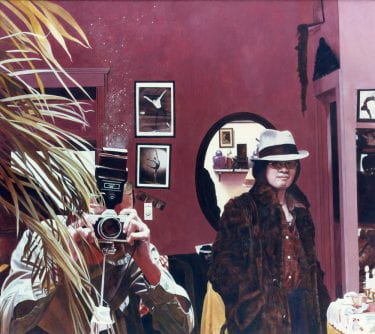
Déjà Vu, 1986
So Kim Anno said, “I'm just gonna go down there with my truck and pick them up.” So that was how one ended up at the de Young Museum. They had been interested earlier, but when they talked to Bernice earlier, she had not been in a position to be giving work away. She used a lot of her work to pay dental bills and things like that. So Flo and I went and asked Timothy Anglin Burgard (the Distinguished Senior Curator and Curator-in-Charge of American Art for the Fine Arts Museums of San Francisco) if he would still be interested in an acquisition. This was also a tip that Elizabeth Cornu, our friend who used to be an arts conservator, gave us. She said, “you need to start placing them in different institutions if you can, so they can get on the radar through their registries and people will begin to notice and take them seriously.”
That's how we started and managed to get one small oil painting in there. Over the years, step by step, we got her into shows. The biggest exhibit, up until the Bing estate, which got her into the collection of the Asian Art Museum was the Sonoma Valley Museum of Art. That one caught people's attention. When filmmaker Madeleine Lim came along and hooked up with the Asian American Women Artists Association, they were looking for a project. Bernice Bing was one of their early members. It was like, how can we put all these pieces together to honor and elevate her. It's a great legacy. When the Bing Estate got an exhibit at the Sonoma Valley Museum of Art there was a really great turnout of the Asian American arts community. There was a great write-up by Charles Desmarais who was a San Francisco Chronicle writer and was also President of the San Francisco Art Institute at one time.
Then Abby Chen, the Head of Contemporary Art and Senior Associate Curator of the Asian Art Museum contacted me and said she thought that the Asian might be interested. “How do we get a hold of whoever is in charge?” I said, “You should be talking to Frieda Weinstein.” That was before Alexa Young died. Or maybe she was gone because Alexa just died earlier this year. Alexa was the executor and knew Bing from back in the day. So, I contacted Frieda and the two of them worked it out. That's why they have arguably the largest collection of Bing works. There's a lot of Bing ephemera at the Cantor Arts Center at Stanford too.
B&A: That's a noble and great achievement and must feel so good.
Lenore, we want ask about San Francisco. We are interested in helping to archive the history of San Francisco’s diversification of culture, and creating more equity and inclusion and all. Do you feel like San Francisco was the epicenter, of that cultural movement? Having grown up here, and having been an artist on the inside, what's your perspective?
LC: I wasn't involved at the beginning. But I've talked to several people about this. Jeff, do you know DeWitt Cheng? He's a local photographer, curator, and writer. He gave me a really good review on the group show that I have photographs in at Yerba Buena Center for the Arts, Bay Area Now 9. One of the things we were talking about was an article that came out recently in the New York Times, about how two major galleries pulled out of San Francisco. The Times got a lot of push back from people here because we said, no, there is still an arts community here. But it's very different from New York. A lot of art and creativity is incubated here. The Bay Area is less concerned with profit than what we see in the New York scene. It's a very different thing. We have a lot of alternative spaces and things like that. So art’s purpose here is very different.
JJ: The things that are considered theatrical achievements here usually take place in a 100-seat house as opposed to Broadway, you know? That's always been the history of theater in San Francisco. It's small. A lot takes place in restricted spaces. I think that's true for the visual arts too. Look at the nonprofit galleries around here. Darryl and Laurie, started the Luggage Store with absolutely no money, managed to put together the place where artists who have made millions of dollars have come out of, like Barry McGee and Mark Bradford. There are a bunch of other ones too. That's not what you would consider a major arts institution.
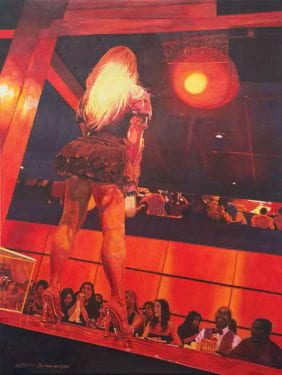
Ceci n’est pas une Pipe, 2010
LC: Who's defining these things? The power brokers in a lot of major museums are a whole different thing. If you're relying on them to be anointed, you're kind of in the wrong game. The other area where I've often been shown is cultural centers and educational institutions. Like I was in Art After Stonewall in New York and that was a traveling show. The first half of the show was at the Leslie-Lohman Museum of Art. The second half was at the Grey Art Gallery, at NYU. I visited both institutions. I think a lot of those areas are where you're gonna see more experimentation and things that are not made to necessarily sell. Although a lot of the people in those places have gone on to bigger and better things, at least in terms of recognition for their work.
B&A: We're curious about Jeff's role in cultural equity and inclusion. Did Jeff write grants for you?
LC: He wrote the grant that got the tribute show for Bernice Bing.
JJ: Yeah, and for Flo Oy Wong’s Festival 2000 show.
B&A: You were out as a lesbian. Did that create challenges for you in the national art world?
LC: I realized very early on that the way the gallery route was structured, was not gonna be a route for me to get my work out. It just wasn't. I had some support initially. I had encouragement from a person who's no longer around, my allergy doctor, William Sawyer. He had a gallery in the Laurel Heights area, called the William Sawyer Gallery. He came to one of my early shows. But there wasn't the kind of connectedness that we see now, when it's more obvious. There was always gay content, but not everybody recognized it. The interesting thing I have found is that the people who really appreciated my work when they saw it were generally lesbian or gay. They could read the iconography with no problem.
Years ago, I was approached by a guy to show my work at the Rasmussen Gallery at Pacific Union College, a private Seventh-day Adventist liberal arts college. So I thought oh why not? I thought he was gay. But he was so freaked out that if we showed these paintings which were largely gay subjects, a bunch of drag queens were going to show up to my opening. I think it was because he was so closeted that he didn't want to trigger anything which might reveal himself. That was probably around the 1990s which is now a long time ago.
Jeff, do you remember Frank Pietronigro? He did Art in the Park. I was in that one.
JJ: Yeah, I remember he tried to revive the Arts Festival the SF Arts Commission held in Civic Center once a year. Are you represented in the Arts Commission collection? Note: The San Francisco Arts Commission used to organize the San Francisco Arts Festival, located in Civic Center for many years. Much later it was held at least once at Moscone Center. I exhibited in both locations. Art in the Park was held in Golden Gate Park by the Bandshell. I exhibited there also and received a blue ribbon from juror Karen Tsujimoto.
LC: No, but I got a purchase award from them in 1977. That is another one of my weird experiences with the Arts Commission. Parts of them have been pretty dysfunctional, I have to say.
JJ: Yes, until they got money.
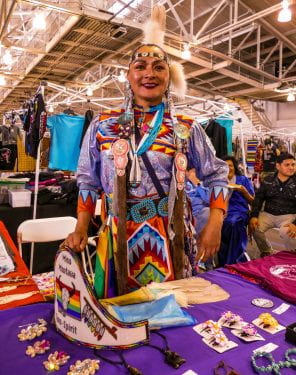
Miss Montana Two Spirit, 2019
LC: I was one of a handful of artists who won a purchase award for works that were destined for the newly constructed North Terminal at San Francisco Airport. The building didn't get done on time or whatever. So the painting essentially disappeared. Everybody wondered where my painting ended up. One day I got a call from one of my father's brothers who was working at City Hall as a handyman. My uncle called my parents and said, you better get Lenore to come down to City Hall, because I just got a work order to put this painting up in a back office and I’m pretty sure it’s hers. So, I went down there with my folks and sure enough it was nowhere in the public view as was intended with this purchase award. It took me a while to get it excavated from that location. It became a foray into politics and bureaucracy. I contacted the Arts Commission and they kind of blew it off. They basically said well it's ours now so it's none of your business. You got paid, you should be happy. Then I read an article in the San Francisco Examiner, an exposé about how some of the works that were under the purview of the Arts Commission disappeared, some were damaged, some were destroyed. I mean, famous artists, right? So I contacted the writer and he told me dreadful stories. He said, “oh, I wish I had known about your painting, but at least you know where it is.” Finally I got a hold of Louise Renne who was on the Finance Committee of the Board of Supervisors, I believe, at that time. She heard about it and was like that's not how we're supposed to be spending our money. That expedited things and it finally went up in the South Terminal for a number of years, which was a different location from where it was originally intended. Ultimately, they deaccessioned it without telling me. So I got contacted by a different person, Michael Brown, who knew Bernice Bing. He recognized my work and contacted me. He used to collect a lot of Asian American contemporary art. So he said, hey, I think I just saw this painting that you did and it was up for auction at Butterfield. That was a stupid place to try to get rid of it, right?
So I contacted the Arts Commission and with my dad's help I essentially bought my painting back for $500. I said, “you know, you're probably not unloading this at this point so I can take it off your hands. You won't have to pay storage fees or whatever.” So now it's with my best friend from college in her living room.
B&A: Their loss! Amazing how you got the painting back.
Thank you so much for sharing your time and your memories. And for your paintings and photographs!
LC: One of my early paintings has recently been acquired by the Smithsonian .
JJ: All the best. Bye.
Krissy Keefer
Krissy Keefer
Krissy Keefer explores the intersection between art and social issues with fierce inventiveness and a deft comic touch.
Coming out of the legendary Wallflower Order (founded in 1975) Krissy Keefer has honed her craft over the last 40 years by creating her content driven choreographies that are a high-energy blend of ballet, modern dance, jazz, song, text, sign language and explosive Taiko drumming. Keefer has a long history of collaborating with a wide array of artists, companies and non-arts community groups. In the highly successful productions of Women Against War at the Herbst Theater, she brought together prominent feminist activists, veteran feminist musicians, both established and emerging dance companies, and Grrrl Brigade.
JJ: Hi, Krissy. Can you tell us your basic bio, like where were you born and where did you go to school?
KK: I was born in Woonsocket, Rhode Island. My parents met at the University of Vermont and my mother got pregnant and had to leave school. My parents subsequently got married and moved to Florida. I was raised in the South between Florida, South Carolina and Cincinnati. I went to Indian Hill High School, which is the number one public high school in the United States. It's in the richest neighborhood and since I lived next to that neighborhood, I got to go to that school. Then I went to the University of Oregon where I started the Eugene Dance Collective and formed The Wallflower Order in 1975.
I am the oldest of five children and I lived in South Carolina during apartheid, where everything was completely and utterly segregated: the water fountains you could use; where you could go swimming; where you went to school; how you interacted with black people specifically. And the dominant question was always, “Are you a Yankee or a rebel?” Literally, we were still asking that question to each other all through grade school, and I, being from Rhode Island, would say I was from Florida because Floridians stayed out of the conflict, so I didn't have to take a stand.
My parents were not liberals. They were Republicans, but they were educated and they were slightly separated from the dominant narrative of white supremacy. So, I didn't take the constant racism home with me the way my friends did. But I lived it. I lived and internalized white supremacy because it was in your face every single day. I think growing up in South Carolina had a huge impact on me. Then we moved to Cincinnati where I went to High School. From the 9th grade onwards I very much identified as a hippie. I read Life Magazine and smoked a ton of marijuana from the 10th grade onwards. From about 16 to 22, I think I was stoned every single day. I was in love with Janis Joplin. I was in love with Grace Slick. I was in love with their music, and I wanted to be like them. I knew someday I would go to California and live in San Francisco.
I graduated in 71. I was a terrible student. I ended up getting into the University of Oregon because my partner in Wallflower Order--Nina Fichter--had a mother who made it her life's journey to get people into college. So she got me into the University of Oregon where I majored in dance.
JJ: When did you start dancing?
KK: My mother was a dancer, when she lived in New York, and she and her sister both danced because my grandfather thought it was really important that they do something. They lived in Larchmont NJ, so he sent them to New York City every Saturday. My cousins ran a big dancing school in Rye NY, and my mother used to teach dance to all the neighboring children when we were living in Florida.
I started dancing ballet when I was 6 and took it very seriously until I was 13 and then got into boys and drugs and had a hard time going to class. I didn't really have the right body type for ballet: Balanchine's aesthetic type was very tall and very thin and I didn't get enough feedback to stick with it. But I never stopped dancing. I danced in the living room. And then I went to the University of Oregon as a dance major.
B&A: Who's Nina?
KK: Nina Fichter and I became friends when I was in fifth or sixth grade. We met each other at ballet school. She went to Bard College and then she dropped out; she came to Oregon and ended up joining Wallflower Order. Later, she and I directed the Dance Brigade until 1998, when she e moved back to Ohio and died of bladder cancer in 2004.
JJ: So you and Nina started working on Wallflower in Oregon?
KK: Yes. I was a member of the Eugene Dance Collective, but that broke up for the summer and so Laurel Near, me and two others, Alex Dunnette and Linda Rose started the Wallflower Order. Then Lyn Neely joined and then Nina joined 2 years later when Alex left. Eugene OR was the Wild West of the women's movement in the 1970s. There were all these women’s collectives: Jackrabbit Press, Gertrude's Café, Mother College Bookstore, Star Flower (a lesbian trucking company that trucked food all over the place), a collective bicycle shop, you name it.
The women’s collectives were embedded in every part of Eugene’s economic structure; that spirit was actually the give-and-take that created the style of Wallflower Order. Huge groups of women, primarily lesbians, would come to our concerts and applaud madly and also give us very direct feedback on what part of our material was working and what was offensive.
After Laurel's sister Holly Near came and saw Wallflower perform, she paid Road Work to book our first national tour in 1977. And I would say that the lesbian movement of that era really dominated the politics and the feel and the look and the community. Eugene is very flat, so everybody rode their bikes everywhere.
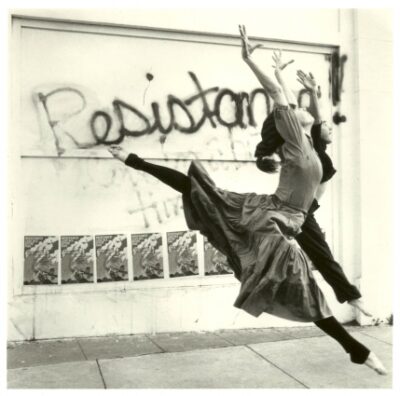 JJ: So when you started Wallflower, did you perceive what you were doing as performance art?
JJ: So when you started Wallflower, did you perceive what you were doing as performance art?
KK: I didn't see what we were doing as performance art. But when Anne Bogart from the Saratoga International Theater Institute came to see Wallflower in New York in 1981, she said, “Oh, this is like performance art.”
But since we were from Eugene Oregon, we didn’t know what to call what we were creating; we never followed trends. The feedback we're getting is from the West Coast: Holly Near took us on tour to help defeat the Briggs Initiative in 1978, which had it passed, would have outlawed any LGBTQ to be employed in California’s public schools. We were trying to make our material accessible to women and to reflect the concerns of women's lives. If we had to sing or dance, or recite poetry, or make skits that were funny, we would do that.
I don't think we were thinking of our art form as much as about creating something that was highly relatable, highly politically charged, and something that impacted our audiences deeply. There was no question as to what our narrative was like: our work kind of tapped us into Russian social realism, or like the famous Chinese ballets red detachment of women almost like we were two fisted women.
I would say honestly, that Sarah Shelton Mann's work with Contraband, which came out in the 1980s, was more performance art than we were. What we were doing was telling a story that we wanted the audience to understand: “to be women like us, you have to change, then we'll all be great together.” I'm not really here to debate whether that was a good thing or a bad thing; I just know the people who showed up at our shows appreciated what we were doing. And of course, we had our detractors, too; “oh my God, there’s so much narrative!”
B&A: Well, more than Anna Halperin?
KK: She was in Marin and I don't think she approved of us: she referred to us as “the angry ones.”
JJ: So, the performance art thing had a very heavy visual component to it that was very abstract and at first it seemed very academic to me. But that's why when I saw what you were doing, I thought it was very different.
KK: The political landscape in the 1980s shifted dramatically: the 1970s was all about the aftermath of the Vietnam War and Watergate, creating community, collective actions and Chairman Mao. And in 1980s artists were trying to find a new path now that Ronald Reagan had taken over.
All the women and lesbians I knew, suddenly wanted a piece of the pie, even Ferron and Holly Near. Jackson Browne took over the solidarity movement. Crossing over seemed like the goal. Melissa Etheridge or Bonnie Raitt took what we were doing and made it accessible to a more mainstream audience. We wondered why not us?
JJ: Thinking back on the 1970s, I remember living in Austin where everything was very community-focused and it was all right there in front of you; all day long, from the minute you got up, you knew what community you belonged to. The culture seemed more like Eugene than San Francisco’s.
When I came to San Francisco in 1979, I noticed that instead of going to a different one of my friend's houses every other night for dinner where everyone got stoned and plotted against the reactionary City Council that ruled Austin’s politics, instead I found myself in public spaces as opposed to in people's houses. Here it seemed like every night I was at a political event of some sort, which was usually followed by a bar-visit; at both, alcohol was omni-present.
But what I really want to know about the most is when Wallflower arrived in San Francisco, did you see what you were doing as feminist art?
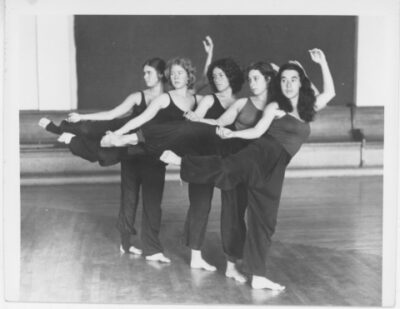 KK: When Wallflower moved from Eugene, Oregon to Boston in 1981, we had been touring all over the United States, in Europe and Latin America and our work occupied the intersection where lesbian feminism meets solidarity work, exemplified by Chile’s Pinochet and many other US-propped up dictators across the globe. Lesbians were at the center of most solidarity groups supporting the liberation of Nicaragua and El Salvador. Our work married these two struggles on stage and there was an audience for it wherever we went.
KK: When Wallflower moved from Eugene, Oregon to Boston in 1981, we had been touring all over the United States, in Europe and Latin America and our work occupied the intersection where lesbian feminism meets solidarity work, exemplified by Chile’s Pinochet and many other US-propped up dictators across the globe. Lesbians were at the center of most solidarity groups supporting the liberation of Nicaragua and El Salvador. Our work married these two struggles on stage and there was an audience for it wherever we went.
Originally, we had moved to Boston so we could be a part of the university scene there and tour more easily. But we hated Boston. Even though our shows attracted a thousand women at Berklee School of Music, we didn't like being there. So, we moved to Berkeley. Then I moved here to San Francisco and I wondered whether we should locate the Dance Brigade in Berkeley or San Francisco. Suddenly, Oakland announced it was now funding the arts, so we went there.
We did a lot of work in Oakland but once that money evaporated, we moved the Company to San Francisco and I started to like it, especially when the Cultural Equity Grants Program specifically named women as a targeted community for funding.
JJ: I remember that when I went to your early shows there would be several hundred people: every other modern dance company I went to see usually had about 50 people in the audience, most of them the friends, family and relatives of the dancers. Your concerts had political content and in the mind-numbing Reagan era, you had an audience.
KK: Yeah, we were popular. And it's interesting because we got reviewed in The Village Voice, we got reviewed in the New York Times, we got reviewed in the Kansas City Star where they said “The Wallflower Order is a national treasure.” However, when we moved to the Bay Area we were really not sophisticated enough for the left here.
The Company’s dancers were involved in a variety of political organizations. I was involved in the Uhuru House movement. Another Wallflower Dancer was in the Line of March; somebody else was doing El Salvador solidarity work. And another was with Workers World, (CPUSA). Politically, none of us agreed and we imploded.
We fought over the name, sued each other, and went to court. It was horrible and very public. There was no money in the bank: we were fighting over the name because the name was our only real asset. We tried to negotiate a settlement and we settled on dividing into two groups with the tag, “a new group from Wallflower Order.” But the other faction’s dance group broke up within six months. And here I am today--almost 40 years later--with an awful, horrible name: Dance Brigade, a new group from Wallflower Order.
So anyway, that was a fucking trauma and everybody knew all about it. And at the time, you told Marie Acosta that I was the one who would continue working in the arts because the others didn't have the choreography chops. And really, they didn’t have it. You can't take away my ability to create dances!
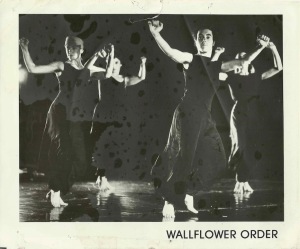 JJ: I think some of these earlier pieces and events you were producing resonated. What about Furious Feet?
JJ: I think some of these earlier pieces and events you were producing resonated. What about Furious Feet?
B&A: Yes, please tell us the genesis.
KK: The Dance Brigade missed the NEA’s Dance deadline so we decided to apply to the presenting and commissioning program. I, with Ellen Gavin’s assistance, made up the title: Furious Feet: A Dance Festival for Social Change. We wrote the grant but didn’t get funded for an obvious reason: President Reagan was not a fan of social change. But we started the festival anyway.
Our main question following the Wallflower break-up was, do we integrate the company or do we do solidarity work. Ultimately, we decided to present artists of color instead of trying to integrate them into our group. So Furious Feet presented artists of color such as Zulu Dance Theater, a South African Ethnic Dance Company. We produced the San Jose Taiko Group, Priscilla Regalado, a Chicana artist, and Contraband. I think that was the very first Furious Feet that we did. Our goal was to make our resources available for people of color to show themselves in their best light, in their own cultural manifestation.
We also did the very first public piece on artists supporting AIDS at the second Furious Feet Festival in 1986, which we dedicated to those who were confronting AIDS: people with AIDS, caregivers, family members, advocates, activists etc. No one in the arts world, outside the Queer community, would touch that issue in that time period. We weren't dealing with the awfulness of what it was internally. I mean, we were all dealing with it as a community, but no one in our company had the stigma of having AIDS.
JJ: But let’s return for a minute to the break-up of Wallflower. How long did this trauma go on?
KK: About a year and a half. It was horrible. In some ways, I would never recover.
JJ: Once that was out of the way, you found yourself in Oakland?
KK: Yeah. So, then that's where we first did Furious Feet and created the Nutcracker. But I think what you're trying to understand is what was the work that went on between 1975 and 1983, and there was a lot of work out there. When we toured nationally, there was a women's production company in every city across the country and we were able to tap into that. At that time there were four main women’s touring groups: the Wallflower Order, Sweet Honey In The Rock, Ferron and Holly Near. We were out there between 1975 and 1985, and then the touring thing kind of eroded financially. I think we went into a financial crisis; people stopped their production companies and also the funds started drying up at the universities. It was the same kind of experience the Mime Troupe was having at the same time.
JJ: Yeah, in the early years of the NEA and the CA Arts Council, touring was actually funded. But since the 1990s, it hasn’t been supported at all and that’s really made a big difference between whether you consider yourself nationally significant or whether you were just parochial.
KK: Well, Sean Dorsey's out there a lot.
JJ: I mean, there's a few people who have succeeded.
KK: And Bandaloop are out there, Axis Dance Company is out there. If you have an audience for your thing, you can get in on that network.
JJ: But other than that, what I was interested in was the difference between the gay art world such as the Gay Men’s Chorus and Theater Rhinoceros and the Women’s Building, the Dance Brigade, Brava for Women in the Arts, Redwood Cultural Work and the Women's Philharmonic, organizations that were actually run by lesbians in the eighties but called themselves women’s arts groups. All of these groups had heavy lesbian representation, the Women's Philharmonic especially.
KK: But don't you think that being a lesbian outside of the lesbian ghetto was pretty stigmatized? I mean, you couldn't just be out in the same way that you could once it became more mainstream, like in the last 10 years or so. I just feel like now anybody can be a lesbian and everybody's queer. But before, if you were running the Philharmonic, you didn't center its narrative around the fact that the Director was a lesbian.
JJ: But nevertheless, I would go to these concerts that had 800 ticket buyers and 80% were dykes but the language was not there. The woman I was married to in Austin, who started one of the nation’s oldest feminist arts groups, did the same thing: she avoided the word Lesbian and named it ‘Women And Their Work.’
In 1979, when I first went to the meetings of the Harvey Milk Club or the Alice B Toklas Club, I noticed there were very few women. At one meeting I asked a woman why there were so few women, she said to me “Look, my history has been with women's consciousness groups and I come to these political meetings and I get to sit here and listen to men arguing with each other, hour after hour. And I just really don’t feel like this has anything for me.”
I soon noticed how Phyllis Lyon and Del Martin were perceived by the Harvey Milk Club as moderate assimilationists; now that I'm older, I see that these two women created LGBTQ history for 40 or 50 years. They founded the Daughters of Bilitis, the first Lesbian political group I know of, in mid-1950s. When Glide Church and others formed The Council on Religion and the Homosexual, Del and Phyllis were there. They were among the founding members of Alice B Toklas, the oldest LGBTQ Political Organization that is now over 50 years old.
I first heard of Del Martin in Austin, when a group of women started a battered women's shelter. Del Martin had written a book called Battered Wives and all the women I knew were reading it. So, I originally thought that Del Martin must be really super militant. But once I arrived in the Bay Area, according to many gay men, she was an assimilationist.
KK: But let's go back to San Francisco. The largest lesbian community in the United States is in Oakland. San Francisco real estate is too fucking expensive. So after the 1970s when on Valencia Street, you had Amelia’s, the Bearded Lady, the Artemis Café, Osento, the Lesbian bathhouse, the Old Wives Tale Bookstore, the Paper Tiger Print Shop, the Women’s Building and Good Vibrations. By the early 1990s, this strip on Valencia Street had completely evaporated because the majority of lesbians had moved to Oakland. And I think the ones that stayed were doctors and lawyers and professional people who could afford to own real estate.
Then the narrative changes. I think that the narrative of “Queer,” kind of erased lesbian culture in a way, or at least participated in the erasure of lesbian culture. It assumed that kind of equalization around everybody's oppression. So, what was particular about being a lesbian in the seventies was that The Women’s movement was influenced by class politics. It wasn't heavily butch femme. We all wore wear jeans and a work shirt and vests at least in Oregon. And this went on for a while I mean, I'm not really being super deep about it, but I'm saying something that I believe happened. There are women who have written about the erasure of women and lesbians in the last 10 years.
JJ: Well, I did see this in the beginning of the nineties, that's when I saw these very young lesbians moving into the Valencia Corridor: Tribe 8, early Michelle Tea, Sini Anderson etc.
KK: But when you talked to them about being lesbians, they're like, “no, we're not lesbians.” Like it was cool to be anything but a lesbian. There was something about being a lesbian that was really not cool enough. So who are we talking about? Help me out, because I don't really know the answer.
JJ: I'm not part of the lesbian community. I just happen to know a whole lot of lesbians who have frequently challenged my assumptions and observations.
KK: Anne Bleuthenthal and I started the Lesbian/Gay Dance festival in 1997 and it was really great for a while. But there weren't that many women who identified as lesbian who were choreographers, and we hit a wall around that. We would do our shows and I felt like there was something missing. There's no edge to this. And then I realized that we weren't working with the whole scene on Valencia Street around Michelle Tea and Sini Anderson and that whole Sister Spit crowd. I felt like we were kind of boring. Then you came along with the National Queer Arts Festival and opened up a whole other chapter in the story.
JJ: There were at least ten years between the Furious Feet and the Lesbian/ Gay Dance Festivals. The 1980s were a mess because we were just inventing how to understand the Non-profit arts world. From the 1990s onward, we did very well. Now there are organizations and people who can deal with whatever your organizational, technical of emotional problem is.
KK: But during the AIDS epidemic, the people's collectives broke up. Reaganomics made a huge cultural shift in this country and kind of destroyed everything that we had tried to create in the 1970s.
JJ: Well, maybe we just got older. In the 1990s a lot of things started happening, maybe because the AIDS epidemic started receding. But from 1983 until about 1992, there were almost no new Queer arts groups during that period.
The groups that existed before AIDS were still around, like the Gay Men's Chorus, the Theater Rhinoceros, the Women's Philharmonic, John Simms Center, etc. But the only new gay groups that formed during those ten years was Joe Goode, and the 848 Community Space that Keith Hennessy, Med-O Whitson and Todd Eugene started on Divisadero Street.
B&A: That was a great venue.
JJ: That's where Queer Arts started coming back in the 1990s. But most of the time before 1990, people were not creating great art. People were dying. Allen Estes the founder of Theater Rhino died. The founder of the Gay Men’s Chorus and the Marching Band Jon Simms died. Chuck Solomon died: he was with the Mime Troupe and Theater Rhinoceros. Choreographer Ed Mock died. Then Ken Dixon, who was the director of Rhino died of AIDS in the early nineties. It was just very hard then. Most of the gay men who built the early Queer arts community had died by that time.
I remember noticing that the John Simms Center, the place where the LGBTQ community arts groups were housed, was suddenly being directed by Lauren Hewitt. So, it all re-started again, I would say, with Keith Hennessy and Joe Goode. They had a lot to do with the reemergence of the gay arts community.
B&A: Jeff, I think you had a lot to do with the queer San Francisco art scene, obviously. I would like to know from Krissy, when did you meet Jeff?
JJ: 83? Somewhere in there.
KK: I don't know who introduced us.
JJ: Nobody introduced us. You just showed up at my door.
KK: No, I didn't just show up. I was invited. We had a date. You invited me over to talk about the Wallflower Order. Then when I showed up, you put some snacks on the table, and I ate every single one of them. That's all I can remember.
JJ: I remember asking myself after you left: Who the fuck was that?
KK: And he started writing our grants—always in long hand--and he worked with Kayla Kirsh. We all got funded for individual artist grants from the NEA. I got the first one, then Nina and Pam. We got $5,000 each, which was an enormous sum in 1983. Then I don't know if it was because we broke up or they stopped funding people for a while, or if there was a collapse in the NEA? I can't remember. They almost didn’t give enough money to make it worthwhile.
JJ: Well, they ended up eliminating all individual artists fellowships, soon after the Mapplethorpe controversy. They decided they're not funding any individual artists at all except for writers.
But during the early 1980s, when Theater Rhinoceros was already funded by the NEA, the Reagan NEA decided to send a reviewer to go and check it out. And they sent Marie Acosta; I don’t think they suspected that she knew Allen Estes. And we didn't really understand how politics intersected with funding.
Artists started learning this lesson in 1983, when the Federal Government passed the Emergency Jobs Act. In San Francisco the City got a ton of Community Development funding to hand out. The decision-making process started with the Citizens Advisory Committee, appointed by Mayor Dianne Feinstein. This committee was eventually chaired by Greg Day. I created a consortium of 5 of my arts clients and we applied. After the Committee, the next step in the process was the Board of Supervisors, where Supervisor Carole Ruth Silver moved to award us $135,000.
B&A: A million dollars now.
JJ: Yeah. It was a lot of money and I understood that the only reason we secured these funds was because I had worked on her campaign, and I asked her to support the Consortium’s proposal. She moved to give the Consortium $135,000 to pay the performing fees of Un-employed and under-employed artists. The next year, Greg Day (See attached Interview) became the Chair of the Citizens Committee and the Consortium received almost $500,000 over the next few years. This experience taught all of us involved in this effort that securing funding was a political process.
But about 15 years after that event, Dance Mission became the poster child for what was going wrong here during the mid-1990s dot.com boom. Could you talk about how that period impacted the Dance Brigade?
KK: I was running the Brady Street Dance Center and I ended up having a falling out with the landlord. We had created this kind of miraculous situation where Brady Street became a very high-profile venue over the two years that we were there with Joey Williams. So, I moved to 24th and Mission Streets where I opened Dance Mission. I built the theater space there. When the individual who had leased the entire space didn’t pay the rent, they tried to shut us down.
It became a very public battle; I told the landlord we would have people demonstrating around the building all the time. I organized a demonstration where people came down and danced in front of City Hall that got a lot of press. Then we went inside and talked to the Board of Supervisors. I remember just spouting off to Ammiano, “if the City is going to go in this direction, you need to find some legislation to pay for all the rent increases.” So Ammiano found $1,000,000 in the city budget and gave it to Alma Robinson (the Director of California Lawyers for the Arts) to hand out.
While rents at arts venues were doubling overnight, suddenly the Crash of the dot.coms took place and everything soon went back to normal. Literally, my rent went from $6000 a month to $12000 and then within a year back down to $6000 because the whole economy imploded.
I worked with Keith Hennessey, and there were other organizations that banded together and held demonstrations around the City and at City Hall. We got a lot of attention around space and equity.
JJ: Well, I think you should think about that particular period when you're talking about the doom and gloom of today. Every ten years the City’s economy is impacted by events outside of its control and it veers off in an entirely new direction: we saw this with the hippies in the sixties, with AIDS in the early 1980s, the 1989 earthquake, the dot.com boom and bust, the advent of the bio-medical industry, COVID, the near-death of downtown and the arrival of the Artificial Intelligence industry. The City always seems to come back from these events.
B&A: Our organization, EARTH Lab SF creates queer and nontraditional environmental art outside the box. Can you say anything about how you've engaged with environmental justice?
KK: What's interesting is that in 1975, people already knew about what was happening with the environment. We were all lit up around it and it was in all of our work, even 40 years ago. I've been talking about the polar ice caps melting in my work since 1998, saying that we don't have a future, and people didn't hear it. And they still don’t hear it now.
We just did a whole show called The Butterfly Effect, which tried to tie all of these environmental justice issues together and to understand the consciousness that we have right now about how environmental catastrophes are coming at us like a steamroller and we just can't move--we're frozen in time.
The thing that's so shocking to me is how many of the victories won in the 1970s have been lost: abortion rights, the environment, black people are still being killed by the police. The unions have all but disappeared. We’re still fighting very basic things around social justice. And now the massacre in Gaza. Really, its 2024 and we are solving a problem by slaughtering women and children of color and hoping nobody notices. Who are we?
I'm just kind of overwhelmed by it all. I feel like I don't really want to make work anymore. Is it really worth using up all these resources to make all these dance pieces? Is this really where we should be putting our energy? I don't know. I feel like we should be stockpiling food and weapons and guns because the censorship is real and takeover can feel immanent.
JJ: Really. You may be right.
KK: Yeah. I feel like we've had that eco-feminist perspective at the core of our work.
JJ: So, before we leave that item, I want to go back to the late 1970s, early 1980s. Did you see Wallflower Order as a feminist group or as a social justice group? Or was feminism part of the larger movement for social justice?
KK: We were a feminist dance company. When you opened our brochure, the first review identified us as a lesbian organization. We didn't call ourselves a lesbian feminist organization. I think our tagline was, “Five Women from Eugene, Oregon.” Then we had reviews that talked about the power of women being together. When I talked to Lisa Vogel from the Michigan Women's Music Festival, she said “your company had the most explicit and demonstrative work that talked about relationships between women.”
We were fearless in a certain kind of way. But we also got a lot of positive reinforcement. Unlike the Women’s music community, where almost all the musicians at a certain point I knew wanted to crossover to the mainstream, dancers don't get famous, so we never thought about crossing over. Our only goal was to get more money for our work. We were never going to be Baryshnikov. Nobody was going to take our work and put it on their dancers or imitate us. People who came to our workshops and took classes from us, and saw us, they imitated us. But hardly anybody was paying us.
JJ: Two weeks ago I read this thing about Tee Corrine, the Lesbian artist who published the Cunt Coloring Book. And she said, “I'm the same age as Robert Rauschenberg, but there's no place in the art world for me to go.” Rauschenberg did indeed just walk right into the visual arts community and become a millionaire painter; Jack Kerouac had a similar experience in the literary world. Tee Corrine had to invent a place for herself.
KK: Look at Yayoi Kusama. She took herself to the Venice Biennale and started showing her artwork on the sidewalk. They kicked her out and she went crazy and went home. But she's famous now and she's 90. She went into a mental institution in Japan in order to hide from her mother so she could work. But she had a nervous breakdown after trying to make it on her own in the 1960s; now she’s treated like a living goddess. People think she's the genius of installation art. So yeah, I think you see a lot of women artists having a Renaissance right now. Judy Chicago's work is all over the place. A lot of women in their eighties and nineties are having real careers after not having gotten their due.
B&A: Have you worked in academia? I'm sure people wanted you to be a professor.
KK: No, I dropped out. I went to the University of Oregon for two years and was wasting my mother's money, so I just quit. But you didn't have to have a degree to teach at the university. You could teach if you had enough chops. You could just slide into a department. Now, they don't let that kind of thing happen.
B&A: Well, you are a legend. Is there satisfaction in being a legend, even if it wasn't mainstream.
KK: I don't really feel like I am anything. The Isadora Duncan Dance Awards has a Sustained Achievement Award. I haven't even gotten that. I have been at this for 50 years. My entire adult life.
B&A: That’s crazy! You’ve done so much for so long. WTF?
JJ: But maybe that's your own lack of self-worth, which is hard to believe, but it's surprising.
KK: What I lack is not self-worth, it’s money. I don’t clamor for it, but every day I look at the bank account. I really feel like coming out of the collective mentality and structure but seeking individual fame is a cheap shot. I spread the accolades around as much as possible.
Beth: We were just talking to artist Linda Montano. She hasn't had the big awards yet either. And she's so important to many different groups of people. The art world can be so cruel. The way that it makes people compete against each other, and it breaks up friendships. Success seems always somewhat arbitrary.
Annie: I was a sex worker artist, and I found the art world surprisingly welcoming.
Beth: But it was different if you called yourself a lesbian. In the early days, in and around the 1980s, if you called yourself a lesbian, it was the kiss of death within the art world.
KK: You could be a lesbian, but you couldn't define yourself that way. Never, ever. There's a whole story about how Holly Near was the first lesbian to publicly come out in the women's music scene. She was the first lesbian to come out in People Magazine; it was a really big deal.
JJ: What I'm struck by when I think about Holly Near is how young she was when she was doing all that. She started Redwood at 23.
KK: She was 22 when she toured with Jane Fonda. I was 22 when we started Wallflower Order. Edna St Vincent Millay was 19 when she wrote her best poem. And Ferron was 19 when she was traveling all over the country. Joni Mitchell wrote Both Sides Now at 19.
B&A: How do you feel about the art world in San Francisco these days? I always tell people that artists are very supportive of each other here. It doesn’t feel competitive. How do you find it now?
 KK: I feel like in dance everybody works with everybody. All the dancers move through many different choreographers because nobody can afford to pay a company except for the ballet, Michael Smuin, Alonzo King and Sean Dorsey. But most dancers move back and forth.
KK: I feel like in dance everybody works with everybody. All the dancers move through many different choreographers because nobody can afford to pay a company except for the ballet, Michael Smuin, Alonzo King and Sean Dorsey. But most dancers move back and forth.
I have 11 dancers in the show that I'm working on right now, and they all have a million other jobs. You can barely get them all to rehearse. It's very community oriented and it's very family. And everybody knows everybody and everybody goes and sees each other's work. We go to see each other's work but we don't exactly like each other's work.
The big grants are so competitive. So there is competition, and there's also this phenomenon: the white choreographers are now being pole-vaulted over for equity reasons. The only reason I'm being funded is because I present and produce so many other artists. It’s not for my own work. I don't get any money to create my own work. But I do enough work through Dance Mission that I save up money to produce myself.
JJ: You found your source of income. I mean, not many artists have been able to actually figure out how to turn their life into something that's supported by a nonprofit arts organization.
B&A: You have over 1,000 people coming through Dance Mission every week. That's incredible. That's a lot of bodies.
KK: People come to Dance Mission to take dance classes, to participate in GRRRl Brigade, the Youth Program, and to see the dancers who perform at our venue and the audiences who attend events there. The pandemic slowed down our attendance figures but we're building them back up.
B&A: You know, the performances I've seen of yours just blew me away and profoundly inspired me and I think they're incredible.
JJ: The ones that I remember the most are from the 1980s and 1990s. I remember The Nutcracker Sweetie in Oakland. What was the name of that venue?
KK: Well, we started at Laney College but we eventually moved it to the Scottish Rite.
JJ: Scottish Rite. That's it.
KK: It was majestic there.
JJ: How many times did you perform that piece?
KK: We did that for ten years. Once it got really going, probably 5000 people annually saw that piece over a ten-year period.
B&A: What are your greatest professional achievements? Have you achieved some dreams? Have you accomplished something unique?
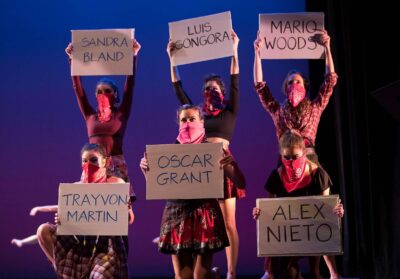 KK: I think definitely The Wallflower Order. Creating that collective was the beginning. I think creating the GRRRl Brigade too. Besides that, I think starting the Lesbian and Gay Dance Festival and the first Festival presenting sky dancers– “Women who Fly through the Air.”
KK: I think definitely The Wallflower Order. Creating that collective was the beginning. I think creating the GRRRl Brigade too. Besides that, I think starting the Lesbian and Gay Dance Festival and the first Festival presenting sky dancers– “Women who Fly through the Air.”
I think the interesting thing about the Lesbian/Gay Dance Festival was that it was the first in the country. Also, Dance Mission is really phenomenal: what we've done there, I don't take credit for it by myself, but I was definitely leading it. I'm its mother. I think that's a great achievement.
B&A: Does your archive have a home yet?
KK: My archives are all over the place. Parts of them are in the costume storage. Some of them are above the bathroom in Dance Mission. There's some stuff in my home’s closet.
You know, one significant thing that I left out is the complaint I filed with the City’s Human Rights Commission against the San Francisco Ballet. My daughter--Fredricka Keefer—was denied acceptance to the Ballet school because she was not tall and thin. This episode drew an enormous amount of international press coverage. Many people in the United States were debating whether I was a terrible mother or that I was bringing something up that should have been dealt with years ago. Anyway, this controversy was covered in the New York Times and in the Wall Street Journal; we were also on The View.
B&A: Yes, I remember that. Huge amount of news coverage everywhere. Good for you!
KK: But I also infuriated Warren Hellman, who decided he was going to ruin my career for my complaint against the Ballet. So he talked to the Chronicle, which did not review my work until David Wiegand and Alan Ulrich and Warren Hellman all died. San Francisco can be very punitive.
JJ: Warren Hellman was the husband of the President of the Ballet’s Board of Directors; he also built the Parking Garages in Golden Gate Park.
KK: Warren Hellman started the Hardly Strictly Bluegrass Festival. So, he had big, big, big bucks. So I would talk to Alan Ullrich, who was the Chronicle’s dance reviewer, and when I asked Alan why he wasn’t reviewing my work, he confessed that his editor “doesn't like you.” So, from 1998 until The Butterfly Effect in 2020, I did not get any reviews in The Chronicle because of my dispute with the Ballet.
JJ: Both of us got blacklisted because we didn’t play ball with the in-crowd.
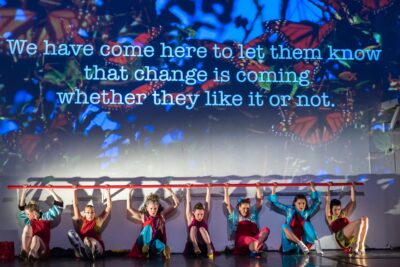 KK: You got demonized super bad. I remember when someone came to meet with me—she had just been assigned by the NEA to be Dance Brigade’s Advancement Consultant. They told me “You gotta stop working with Jeff.” I didn't understand what was going on. But I do remember looking at a finished grant that just sat on the floor of the closet because you had written it. It was that you were calling Kary Schulman’s Agency (Grants for the Arts) racist and they were all coming after you.
KK: You got demonized super bad. I remember when someone came to meet with me—she had just been assigned by the NEA to be Dance Brigade’s Advancement Consultant. They told me “You gotta stop working with Jeff.” I didn't understand what was going on. But I do remember looking at a finished grant that just sat on the floor of the closet because you had written it. It was that you were calling Kary Schulman’s Agency (Grants for the Arts) racist and they were all coming after you.
JJ: I lost all of my clients.
KK: And me too. I didn’t understand what was going on. We were still in Oakland at the time, so I didn't even know what they were talking about.
But then I do have to say in Jeff's complete and utter defense and glorification, that the Cultural Equity Program is the singularly most important program that happened in San Francisco in terms of funding. It changed everyone's life. It changed my life completely. To get those individual artists commissions and then get those Project Grants and then keep moving up and getting the bigger Cultural Equity Initiative Grant. I created lots of work off those individual artist commissions. There weren't that many artists that were doing political work in San Francisco that could navigate the work that the grants went to.
I think that where I related to what Jeff was doing was through Redwood Records and the women's music community. You know, Jeff took Redwood from being a profit organization to a nonprofit. He created that format for them, which allowed them to apply for grants and really changed how they were working and how they were perceived and how they became much bigger and produced the Redwood Festival and all of that. So that's one of the bonds that we had really. Because I didn't actually have a lot of bonds. I didn't really know who your other clients were at the time Jeff.
JJ: Redwood, La Pena, the Mime Troupe, the SF Ethnic Dance Festival, Dimensions Dance Theater, the Jewish Film Festival, the Arab Film Festival. Theater Rhinoceros, and about 5 Oakland-based Ethnic Dance Companies.
KK: Did you guys get enough? Thank you for taking the time to do this. If you need to get back to me about anything you want to know more about, just call me.
B&A: You've been amazing. It’s not easy being ahead of your time for such a long time. You’re a great bad ass.

